
Mid-career researchers are at risk of falling into a critical gap in which they are no longer eligible for early-career support, but not yet fully prominent enough for established researcher grants. Mathipa-Mdakane and Nxumalo ask: can we afford not to invest in the researchers who will shape tomorrow’s breakthroughs?
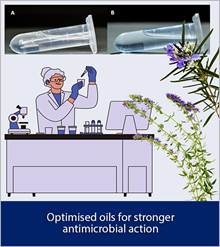
By leveraging computational tools, Leigh and colleagues have optimised the combination of Hyssopus officinalis and Salvia rosmarinus oils for a potent antimicrobial effect. Their subsequent creation of a nanoemulsion formulation enhances the stability and bioavailability of these oils and remarkably causes them to exhibit six-fold greater antimicrobial efficacy against respiratory pathogens when in formulation than as individual oils. As antibiotic resistance looms, this natural remedy offers a promising alternative for managing respiratory infections.
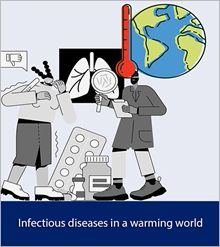
Climate change risks triggering epidemics of emerging and re-emerging diseases across the world with disastrous consequences. When it comes to climate effects on infectious diseases, the future is already here. Moir and colleagues call for immediate action to mitigate the impending global public health crisis for a healthier future for all.

About 90% of homicide victims in South Africa in 2017 were men. Based on routine data collected through forensic and police investigations, Matzopoulos and colleagues found that male homicide rates were higher than female homicide rates across all ages. Most deaths were from sharp force injuries (stabbing), with gunshots the second leading cause. Of the perpetrators, 93% were men, and were usually acquaintances (63%). Of the 7% of men killed by female perpetrators, 60% were killed by their intimate partners. Alcohol use was reported in 50% of homicides by acquaintances and 41% of homicides by family members. The omission of men from the prevention agenda is an equity issue that affects not only men, but also women and children in South Africa’s most marginalised communities.

Access to outer space is crucial for African nations. Ngcofe urges African nations to increase involvement in space activities, promote collaborations, adhere to sustainability principles, and advocate fair space debris responsibility.
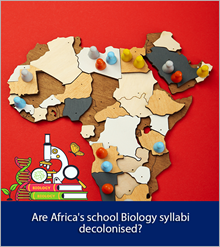
Dempster investigated the extent to which seven African countries have decolonised their ecological and environmental syllabi by departing from the Cambridge International Education syllabus. Although all seven countries have developed their own syllabi, few have decolonised or contextualised their Biology syllabi. A decolonised syllabus may reduce the alienation students experience when they encounter Western science by infusing African epistemology into the syllabus, incorporating Indigenous knowledge, and using relevant familiar examples to illustrate scientific concepts.
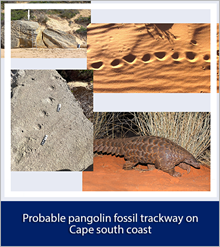
Helm and colleagues describe a fossil trackway, attributed to a probable pangolin trackmaker, discovered on a Pleistocene aeolianite surface of the Waenhuiskrans Formation in the Bosbokfontein Private Nature Reserve on South Africa’s Cape south coast. The trackway consists of eight tracks and two probable tail traces, and was assessed and interpreted through integration of indigenous African and Western-based ichnological approaches, leading to a reasonably confident conclusion. This appears to be the first description of a pangolin trackway in the global fossil record.
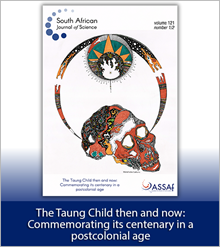
On 7 February 1925, the journal Nature published an article by Raymond Dart detailing the discovery of the Taung Child – a fossilised skull of a young hominin child that was discovered in 1924 by miners in Taung, South Africa, and the type specimen of the species Australopithecus africanus. This special issue commemorates the centenary of this groundbreaking publication in a post-colonial age.
Despite its significance to the human evolutionary story, this first evidence of early hominins in Africa was originally met with skepticism and challenged by some Western scholars who believed our human origins were in Europe or Asia.
This special issue, ‘The Taung Child then and now: Commemorating its centenary in a postcolonial age’, brings together a group of African researchers and international collaborators who offer their perspectives on the science, history, and legacy of palaeoanthropology in South Africa and beyond. They explore how the history of the discovery of early hominins in South Africa, as it played out in a colonial context, impacted the scientific field of palaeoanthropology, asking: Did it promote or limit scientific enquiry? What were its cultural effects, and how do they play out in our current context a century later? How might we work to decolonise palaeoanthropology and its narratives?
The goal of this special issue is to celebrate the remarkable science that the discovery of A. africanus enabled, but also to probe disciplinary legacies viewed through a critical lens that challenges us to do science better. As we enter the next century of palaeoanthropological research and discovery, the contributors call on researchers to take on board socially responsive practice, and for institutions to hold researchers to higher standards of practice.

As the world moves towards cashless transactions, the many people in South Africa doing informal work for which they receive small amounts of cash or donations could increasingly receive less of this informal financial support. With fewer donors carrying cash and expensive devices needed to support cashless transactions, an alternative is needed for this informal sector. Harroway and Bekker therefore developed an architecture for a digital voucher donation management system. The system is based on blockchain technology and is secure. It would enable individual donors to transfer cashless vouchers to recipients. The recipients could then exchange the vouchers for necessities such as shelter, food and clothing at participating stores and institutions of care.

Global warming is evidenced through increasing periods of intense heat and heatwaves. Heat exposure can lead to adverse health impacts ranging from dehydration to death. Wright and colleagues investigated the heat experiences and perceptions of minibus commuters and the minibus taxi industry – a group vulnerable to heat exposure – to inform an intervention to prevent adverse health impacts from heat exposure in the City of Tshwane. They also prepared educational awareness materials on heat risks and actions to take when it is hot, and distributed these through the minibus taxi sector. Future research needs include measuring temperatures in these settings and rolling out large-scale interventions, such as infrastructural changes, to protect health and well-being in a changing climate.
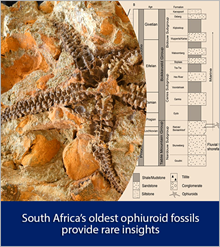
Gess and Reddy comment on their recent description of the oldest recorded brittle stars (ophiuroids) from the southern hemisphere, which revealed two distinct taxa of early Pragian age (approximately 410 million years old). They were recovered from the upper member of the Baviaanskloof Formation (uppermost unit of the Table Mountain Group) and offer insights into the earliest recorded phase of the endemic Malvinoxhosan Realm, deposited in polar regions of the ancient supercontinent of Gondwana, which much later split into Africa, South America, Antarctica, Australia and India. One of the brittle stars discovered belongs to a species previously described from younger strata, but the other represents an unusually spiny taxon formerly unknown to science. Preserved in life positions, twined amongst the shells, they undoubtedly inhabited the sheltered environment prior to being smothered by a pulse of mud washed out of a nearby river mouth. Bearing thorn-like spines on their dorsal disc and running the length of their arms, they were revealed to be an entirely new genus and species, Krommaster spinosus, now known only from this single lens of rock.
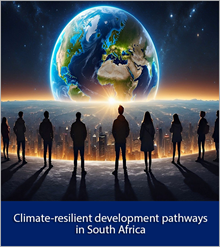
Climate-resilient development pathways (CRDPs) are an attempt, around the world, to bring together the sustainable development agenda with the climate change and disaster risk reduction agendas, linking bottom-up initiatives with large-scale planning efforts. CRDPs provide a means of coordinating the diversity of actions required to transition to a more just, inclusive and sustainable development trajectory that keeps the global climate system within a range suited to human habitation as we know it. Taylor discusses efforts to move from conceptual development and policy goal setting to operational practices, as well as the important convening role played by South Africa’s Presidential Climate Commission and calls on the science community to inclusively coproduce the evidence base needed to negotiate and implement CRDPs across scales that unlock a just transition to sustainable well-being for all.
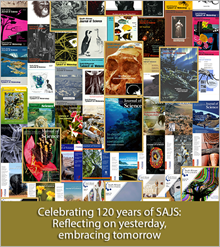
The South African Journal of Science (SAJS) celebrates its 120th volume in 2024.
Reaching the 120th volume is a testament to the resilience and adaptability of the SAJS, and to the Journal’s important role and impact in the broader South African research community. Although it has had different names and formats and various publishers and funders, the SAJS has been published without interruption for 120 years, through two World Wars. It is important to recognise this milestone in the SAJS to honour all those who have contributed to the Journal and its impact over the last 120 years, and to set the stage for continued success. We thank all the publishers, funders, editors, authors, reviewers, and readers who collaboratively have sustained a journal that publishes and promotes the widest diversity of excellent South African research for the local and global academic community and informs policymakers and the public.
This special issue, ‘Celebrating 120 years of SAJS: Reflecting on yesterday, embracing tomorrow’, is a compilation of contributions from the SAJS community, including past editors, ASSAf, and Board members. The contributions reflect on the history of the Journal as well as its role in the history of South African science, from the perspectives of the disciplinary areas represented in the Journal.
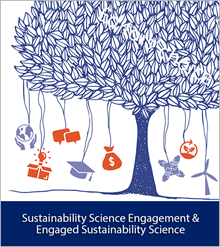
This special issue on ‘Sustainability Science Engagement and Engaged Sustainability Science’ explores the growing need for inter- and transdisciplinary approaches to science, emphasising the importance of including stakeholders in shaping research needs and objectives. It highlights the distinction between ‘science engagement’ and ‘engaged science’, with science engagement going beyond traditional one-way communication to include concepts such as knowledge co-production, citizen science, place-based research and learning, and responsible research and innovation. The process of scientific knowledge production itself needs to be revised in relation to affected publics and the more-than-human world, challenging the often taken-for-granted established role of higher education and research in society.
Focusing on sustainability sciences, the contributions in this issue address complex, ‘wicked problems’ like climate change, water insecurity, and landscape change and governance. The research articles in this special issue bring together selected contributions from a National Research Foundation (NRF) / Department of Science and Innovation (DSI) Community of Practice (CoP) involving 11 Research Chairs working in the sustainability sciences in and across natural and social science disciplines. The research presented advances the understanding of how sustainability science can bridge the gap between policy, practice, and public engagement, fostering a more inclusive and engaged scientific process. The relationship between engaged science, learning and sustainability is highlighted in all the papers.
Additionally, the contributors sought to develop an understanding of transdisciplinary science approaches which include an explicit focus on decolonial, place-based approaches to developing transdisciplinary science in South Africa. To cement the longevity impact of such innovations, the importance of learning and education system transformations surfaced.
This special issue highlights that the role of transdisciplinary and decolonial sciences, transformative learning approaches, and sustainability transitioning through engaged science needs improved articulation in relation to calls for university education and the education system more broadly to better serve the public and common good. However, as said by Allais in her Commentary, the education system cannot make the transition on its own – wider policy, societal, and economic transformations are needed.
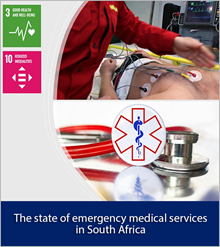
In its current state, the emergency medical services (EMS) in South Africa lacks efficiency to provide emergency care and transportation to patients needing access to health facilities. The World Health Organization (WHO) Health Systems Framework provides key components of a functional health system; Govender and colleagues found that all applicable components are not functioning optimally, thereby contributing to a constrained EMS system in South Africa. Challenges were found in governance; resources; emergency care provider preparedness; health and safety; training and communication systems at a provincial EMS level, despite improvements in legislation, leadership, and governance by the national Department of Health. The evidence suggests that the EMS system is not adequately fulfilling its role in the Integrated Healthcare Delivery Platform in South Africa. Urgent intervention by the national Department of Health is needed, and greater leadership and governance, especially at the provincial and district health levels, are required to improve poorly functioning components of the EMS system so that the goal of universal health coverage and improved health outcomes is realised.
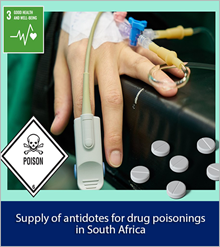
Poisoning, both accidental and intentional, is a significant problem in South Africa, and is a treatable cause of mortality. However, the findings of a recent study highlight the lack of uniform availability of antidotes to common and critical drug poisonings in emergency departments. Fitchett, Saffy and Lewis assessed the availability of antidotes in selected teaching hospitals in the Southern Gauteng City-Region and explored doctors’ experiences of antidote supply. Doctors reported organophosphate poisoning and paracetamol overdose as the most common drug poisonings. The antidotes to the most common poisonings reported by doctors were present in all the emergency departments; however, concerns were raised about the consistency of supply, which will be an important avenue for further research.
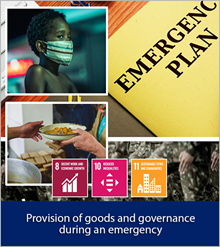
African cities are the fastest growing in the world. Rapid urbanisation and emergency periods (such as the COVID-19 pandemic) add to the complexity of the urban space. Lambrechts describes the provision of political goods and governance in marginalised, local communities, located in Cape Town, South Africa, during the national lockdown period (due to the Covid-19 pandemic). Communities in the city relied mostly on themselves for the provision of goods. These communities experienced desertion across the spectrum of political goods and resilience in such communities needs to be improved through good governing principles. Although optimal local level governance relies heavily on the provision of security, the importance of the provision of education, employment, political freedom, housing, and health services (to mention a few) requires renewed attention.
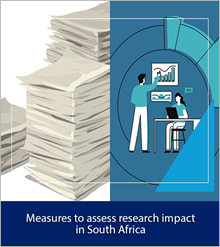
Higher education leaders, funders and policymakers need to collaborate at the national level to initiate and support research assessment reform in South Africa. In a ‘publish or perish’ culture, there is a global push for the prioritisation of research impact beyond scholarly contribution. It is important for higher education leaders, policymakers and funders to understand the challenges and consequences of the current measures used for assessing research impact in higher education institutions and to advocate and support the responsible use of metrics. Bibliometric indicators and other quantitative measures are the most widely used method for evaluating research impact because they are easy to use and provide a quick solution for evaluators, but they fail to capture important dimensions of high-quality research, at the expense of researchers whose impact cannot be quantified. Mfengu and Raju explore the challenges with metric indicators and propose the adoption of responsible research metrics and assessment in South African higher education institutions for more inclusive and equitable research impact assessment.
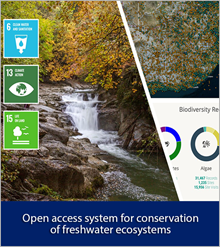
Long-term freshwater biodiversity data sets are vital for monitoring, managing and protecting freshwater ecosystems, but were lacking for South Africa. Therefore the Freshwater Biodiversity Information System – an open access system for hosting, sharing, and analysing freshwater biodiversity data for South Africa – was developed by the Freshwater Research Centre and its technical partner Kartoza, as outlined by Dallas and Shelton. Platform design and functionality were strongly informed by the requirements of key data end-users and decision-makers. The platform has over 790 000 occurrence records, which are freely available to data users and are being converted into impact through incorporation in national decision-support tools. The team behind the Freshwater Biodiversity Information System received the 2022/2023 NSTF-South32 Data for Research Award for its development to facilitate decision-making on freshwater systems.
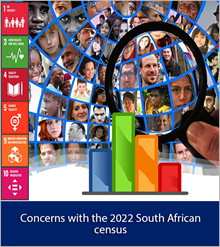
The 2022 South African census may not be fit for purpose to assist with fiscal allocation, or for national, provincial, or local government planning and resource allocation, according to Moultrie and Dorrington. Moultrie and Dorrington identify concerns with the estimates released by Statistics South Africa. Although their investigation is preliminary, it appears that the population of South Africa may have been overestimated by as much as a million people, with about half of that number accounted for by significant overestimates of the white and Indian/Asian populations, particularly. This overall excess is concentrated in the age groups aged 50 and over – an age range unlikely to have been affected by substantial in-migration and appears to be a little higher for men than women.
[Editor’s note: Statistics South Africa has been invited to address the concerns raised and their response is forthcoming.]
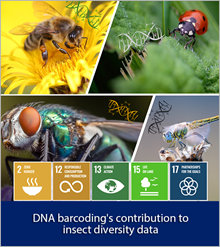
A comprehensive national insect sampling effort is needed alongside increased investment in taxonomic expertise to generate critical baseline data on insect biodiversity in South Africa before species are lost to extinction. South Africa is recognised as one of the most biologically diverse countries globally, with an estimated 44 000 insect species, yet our knowledge of insect diversity within South Africa is sparse. There are few taxonomic specialists relative to South Africa’s biodiversity, and the methods used for insect identification can be time-consuming and expensive. Stewart and colleagues advocate for DNA barcoding as an important research tool to accelerate insect biodiversity research. Insects comprise much of animal diversity and play vital roles in ecosystems, including pest control, decomposition and pollination, with a shortage of wild pollinators currently threatening crop yields.
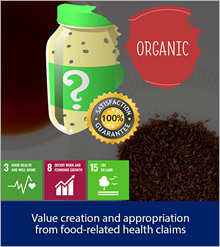
The medicinal plant biodiversity of South Africa offers opportunities for economic, human and environmental value creation through legislated health claims. Health claims are considered a means to add value to food and beverages; however, it is not always evident which stakeholders benefit and to what extent they benefit. Todd and colleagues explored which forms of value can be created by legislating health claims (including those for bioactive compounds found in South African indigenous plants) on food labels. Their findings reveal that health claims have the potential to advance the sustainable development agenda in South Africa, but only if structures can be put in place to appropriate human and intellectual value, as well as environmental value. However, because the current draft legislation for health claims excludes any bioactives from indigenous South African plants, much of this economic, human and intellectual, and environmental value creation potential will not materialise.
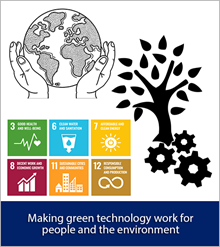
Sustainability is fundamentally a human problem. While many technologies exist to address the wide variety of sustainability challenges facing humanity, many technologies are not adopted at sufficient scale or are used incorrectly, negating the positive impacts. Andrew Thatcher, recipient of the 2022/2023 NSTF-South32 Green Economy award, introduces the discipline of human factors and ergonomics, demonstrating four features that facilitate the effective design and implementation of eco-socio-technical systems for sustainability. He uses the URBWAT research project, which implemented a nature-based solution in an informal settlement to collect and treat greywater, to illustrate how these four features operate in practice.
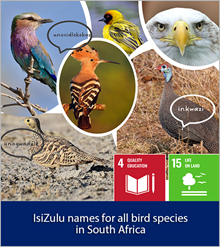
Indigenous African languages need terminology development to be effective in science communication, planning, teaching, and learning. In an inclusive, stepwise and evaluative process, a team including scientists, linguists, environmentalists and bird guides have allocated isiZulu names to all wild bird species occurring in South Africa. Wild birds are key indicators of biodiversity and the state of the environment. Matters of biodiversity conservation involving birds can now be better communicated in isiZulu, with benefit to environments and human communities.
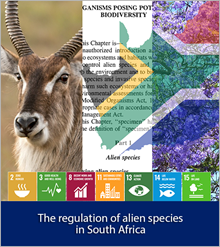
A key global change challenge is to significantly reduce the risks of alien taxa causing harmful impacts without compromising the rights of citizens. As part of efforts to address this challenge, South Africa promulgated comprehensive regulations and lists of alien taxa in 2014. Wilson and Kumschick review how these lists have developed over time and been implemented, and present key issues that remain to be resolved. As South Africa’s regulatory framework continues to develop, the process of listing and regulating alien taxa will become more transparent and consistent, and ultimately facilitate efforts to reduce the harmful impacts of alien taxa.
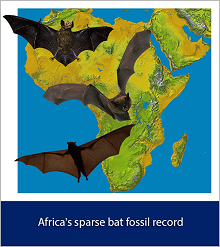
Bats are found in nearly every habitat worldwide. They play crucial roles in ecosystems, from pollinating flowers to controlling insect populations. Yet, despite their global presence and ecological importance, the story of bat evolution, particularly in Africa, remains elusive due to a surprisingly sparse fossil record. This scarcity renders bats a ‘silent taxon’ in the annals of palaeontology; they are vitally important yet leave few traces behind. Mariette Pretorius asks why bat fossils in Africa are so rare, and how this rarity impacts our understanding of modern bats and their conservation.
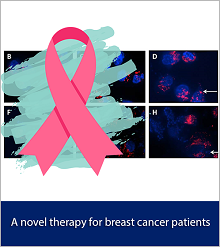
Doxorubicin is a well-known and highly effective treatment for breast cancer patients. However, many patients present with resistance to chemotherapeutic drugs, which ultimately results in treatment failure and contributes to high mortality rates. MKP-1 (mitogen-activated protein kinase phosphatase 1) mediates the response to chemotherapy, with excess MKP-1 associated with chemoresistance. Du Plessis and colleagues report that MKP-1 inhibition can sensitise breast cancer cells to doxorubicin therapy, and as such has potential therapeutic benefit for breast cancer patients by increasing the efficacy of conventional chemotherapy. Breast cancer is the most commonly diagnosed cancer and the second most common cause of cancer death in women. MKP-1 inhibition should be developed as a clinically relevant adjuvant therapy, which could provide a novel avenue for therapeutic intervention in combination with chemotherapy in breast cancer patients.
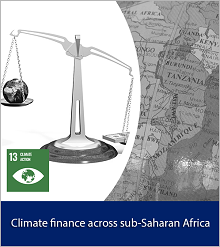
Some African countries are more exposed to climate financial risk. This is a finding from the first study to provide a comprehensive network structure of the climate finance flows into Africa, based on the global public climate finance governance system. Queensley Chukwudum employed network theory and decision tree techniques to study the structure of climate finance flows from donors to recipients in sub-Saharan Africa, and identified an isolated region of Africa with no boundary funding units. Boundary funding units cater to only a few countries at once. African countries within this group could be more exposed to climate financial risk as they rely only on central funding units, which simultaneously cater to many African countries. Insights from this analysis are critical for future planning as it can provide African governments and interested stakeholders with informed evidence upon which they can make reliable and justifiable decisions.
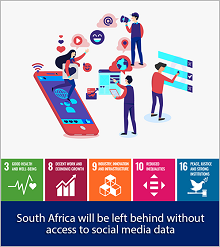
Social media data are essential for studying human behaviour and understanding potential systemic risks. Social media platforms have, however, begun to remove access to these data. In response, other countries and regions have implemented legislation that compels platforms to provide researchers with data access. In South Africa, we have lagged behind the Global North when it comes to using platform data in our research and, given the recent access restrictions, we risk being left behind. Douglas Parry calls attention to this critical issue around access to social media data in South Africa.
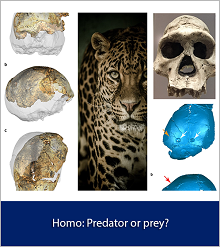
Classic depictions of human evolutionary ecology cast our Homo ancestors as predator and other hominins, including Paranthropus robustus, as prey. Such hypotheses rest on a small number of fossils that exhibit evidence of carnivore predation, including the iconic SK 54 cranium from Swartkrans in South Africa. Martin and colleagues demonstrate that the SK 54 cranium shares its closest affinities with H. erectus rather than P. robustus. Demonstrating that Homo was prey for leopards at Swartkrans weakens the historically significant hypothesis that Homo was better able to avoid predation because of being behaviourally and technologically advanced compared to Paranthropus. Hypotheses concerning the biology, behaviour, and technological capabilities of Homo and P. robustus should be reassessed.

It was early in 1938 that the medical superintendent of Rand Mines, Dr A.J. Orenstein, asked Professor Basil Schonland, the Director of the Bernard Price Institute of Geophysical Research (the BPI) at the University of the Witwatersrand, about the feasibility of radio communications underground in mines. Orenstein had long been concerned that firefighting and rescue teams were severely hampered by a lack of communication between those personnel and anyone else when they ventured into the most hazardous of situations. Schonland was sceptical that radio signals would propagate over useful distances through rock strata, but agreed to investigate. Brian Austin summarises the pioneering work done in South Africa in developing radio communications technology for use underground in mines.

Portulacaria afra (spekboom) is a medicinally important plant species endemic to South Africa and is resilient to rising CO2 levels. Portulacaria afra is used by traditional healers to treat various skin conditions. Basson and colleagues investigated the effect of elevated CO₂ concentrations on the medicinal properties of the leaves of Portulacaria afra. Atmospheric CO₂ was 417 ppm in 2022 – a 50% increase on pre-industrial concentrations – and it is predicted to rise at an unprecedented rate, potentially reaching 600 ppm by 2050. As CO₂ is a limiting factor in photosynthesis, rising atmospheric CO₂ could increase the photosynthetic pathway, leading to alterations in primary and secondary metabolism. However, Basson et al. found that the phytochemical profile and antioxidant and antimicrobial activities of Portulacaria afra either remained the same or increased after exposure to an elevated CO2 concentration of 600 ppm. Their findings suggest that Portulacaria afra is a resilient medicinal plant and that its leaves may continue to provide relief against certain ailments, despite rising atmospheric CO2 concentrations.
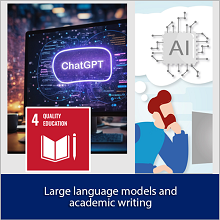
Large language models (LLMs) like ChatGPT have changed the world forever. Researchers and academic journals, among others, need immediate yet thoughtful guidelines for using LLMs and AI in the scientific process. Bekker divides LLM usage in the academic writing process into tiers of use and offers practical guidance to cautiously and ethically embrace the benefits of this significant new tool.

In Africa, 40% of traffic fatalities are pedestrians – the highest proportion globally. The latest findings of Bantjes and colleagues indicate that efforts to improve pedestrian safety in South Africa should focus on changing motorists’ attitudes to the law. Bantjes et al. explored associations between driving practices that endanger pedestrian safety and motorists’ attitudes to the law, controlling for sociodemographic and personality factors. In addition to lawlessness, or a general disregard for the law, being an important determinant of unsafe driving, other determinants associated with unsafe driving were male gender and four dimensions of motorists’ personality: aggression, impulsivity, risk tolerance, and altruism. Bantjes et al. provide valuable insights that can inform targeted interventions.

Postdocs in South Africa are a category of early-career researcher which has been growing in size and relevance but has remained largely invisible. Prozesky and van Schalkwyk provide, for the first time, longitudinal, quantitative evidence on the past two decades of postdoctoral research fellows, with a focus on research intensity (time spent on research) within the national research system, as well as nationality and gender. Their findings support concerns raised about the casualisation of academic labour in the country, and further indicate that it may be gendered.

Earth is surrounded by a geomagnetic field that protects us from the harmful effects of space weather, and also plays an integral role in navigation and mapping applications. Updates of geomagnetic field models are required to ensure the accuracy of maps, navigation, and positioning information. Nel and colleagues describe a new regional field model called the South African Regional Core and Crust model (SARCC) – the first time that a local lithospheric model has been combined with the core component of CHAOS-6, a global field model. Nel et al. also compared the new SARCC regional geomagnetic field model with the existing regional field model as well as with global core field models. The SARCC model showed small-scale variations that were not present in the other three models, leading them to surmise that including a lithospheric magnetic field component likely contributed to the better performance of the SARCC model.
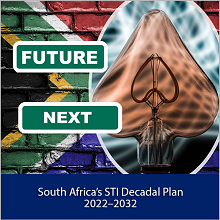
South Africa’s Science, Technology and Innovation Decadal Plan 2022–2032 intends to shape innovation activities and their contribution to development. It serves as government’s master plan and pivots the National System of Innovation to mitigate the socio-economic, health and environmental challenges of times that are volatile, uncertain, complex and ambiguous. But, comments Kahn, in trying to be all things to all people, the Decadal Plan avoids prioritisation, reading more as a Vision Statement than an Implementation Plan.
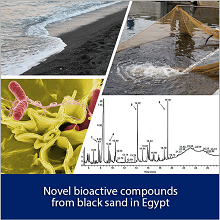
The increasing number of multidrug-resistant pathogens has necessitated the discovery of novel bioactive compounds. Atallah and colleagues isolated two actinomycetes strains, Streptomyces griseorubens and Streptomyces rochei, for the first time from the black sands shore of Kafr El Sheikh, Egypt. Both strains exhibited powerful antimicrobial activities against three serious multi-drug resistant pathogens (Bacillus subtilis, Salmonella enteritidis and Pseudomonas aeruginosa) and the bioactive compounds were identified using gas chromatography–mass spectroscopy. Atallah et al. recommend these isolates for use as an eco-friendly biocontrol against multidrug-resistant pathogens that attack fish farms.

Some have reported that chief executive officers (CEO) who are chartered accountants can help their companies increase profits through their tax knowledge – known as the ‘CEO effect’. However, corporate tax avoidance can impede governments’ spending on social and economic initiatives that increase infrastructure development, economic growth and equality, and reduce poverty. Van der Spuy and De Jager investigated the influence of the CEO effect on corporate tax avoidance using data from the 112 largest listed companies on the Johannesburg Securities Exchange between 2004 and 2018. They found that the CEO effect had no observable influence on the level of corporate tax avoidance, thereby assuaging possible concerns of negative effects on societal interests.
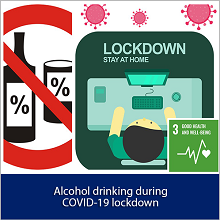
Bans on alcohol sales have the potential to reduce or stop alcohol intake in moderate drinkers, but may make heavy episodic drinkers drink more than usual. This finding is from Theron et al. who investigated changes in alcohol-related behaviour and the drivers of illegal alcohol sales between 2019 and 2020 – during the COVID-19 lockdown-related alcohol sales ban. During COVID-19 lockdown, illegal alcohol sales took place through unlicenced alcohol outlets and friends, and not through licenced online applications. Theron and colleagues recommend stricter regulations aimed at legal online alcohol sales applications to prevent alcohol sales to minors and those who have already consumed too much alcohol, and a ban on marketing of addictive substances such as alcohol.
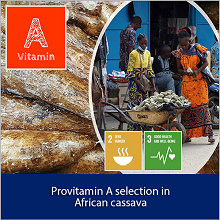
Vitamin A deficiency contributes to significant levels of mortality and morbidity, particularly among children and women in Africa. Biofortification of crops with beta-carotene can help to reduce the prevalence of vitamin A deficiency in a cost-effective and sustainable way but can be a laborious and slow process. Codjia and colleagues found that marker-assisted selection was sufficiently accurate for early screening for carotenoid content in cassava, which is a major staple crop in Africa. Their approach can efficiently reduce the challenges related to the use of sophisticated instruments for carotenoid quantification.
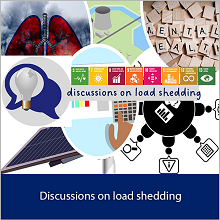
Load shedding is an ongoing issue in South Africa, with significant and widespread effects. It is an issue which brings together the range of disciplines represented in the Journal, from politics to engineering, and from sociology to climatology. There is no one understanding and experience of the problem, and there is no single way forward. Several Commentaries in this issue comprise our latest discussion series, Discussions on Load Shedding, which explores the multifaceted causes, consequences and costs of load shedding.
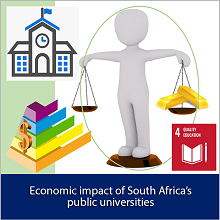
Universities have multiple social purposes. As an economic sector, higher education in South Africa contributes more to the gross value added than economic sectors such as Wood and Wood Products, Textiles, Clothing & Leather Goods, or Paper & Paper Products, and is comparable to sectors such as Gold Mining, and Beverages & Tobacco. Bawa and Pouris conservatively estimated the economic benefits of public universities at about ZAR513 billion for 2018. For this estimation they used only four activities – university exports, research at universities, the production of graduates, and universities as business entities. By comparison, government expenditure on higher education in 2018 was ZAR66 billion, giving a cost–benefit ratio for the sector of 1:7.7. This analysis highlights for policymakers the importance of the sector as an area of investment.

Cardiovascular diseases are the leading cause of death worldwide and their burden is increasing in low- and middle-income countries like South Africa. Physical activity has substantial positive effects on cardiovascular health – effects that are already observed in childhood. Arnaiz and colleagues compared two widely used methods to assess physical activity levels in children as part of the KaziBantu project, a school-based intervention programme to promote sustainable lifestyle changes to achieve better health within disadvantaged communities in Gqeberha, South Africa. Although 65% of the children achieved the recommended minimum of 60 minutes of moderate to vigorous physical activity per day, overall they were sedentary for 64% of their day. Boys were significantly more active than girls, with the World Health Organization’s recommendations for physical activity attained by 82% of boys compared with only 47% of girls. Importantly for researchers and public health practitioners, they also found that the two assessment methods were weakly associated and inconsistent in detecting relationships with cardiovascular risk markers.

Many South African children are wearing school shoes that do not fit their foot morphology. School shoes are an integral part of mandatory school uniforms, as legislated by the South African Schools Act, yet limited data on South African foot morphology means shoes are typically designed according to British measurements. As ill-fitting shoes can negatively impact the developing foot, manufacturers of school shoes in South Africa face the challenge of accommodating the unique foot shape of habitually barefoot South African children and adolescents. In a Commentary in this issue, Breet and colleagues comment on their published study that has yielded valuable insights to guide the design of shoes that promote healthy foot development in the South African population. They found that 98% of South African children wore shoes that were too narrow for their feet, while 59% wore shoes that were not the appropriate length.
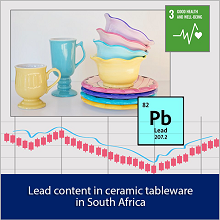
Ceramic ware is used by most of us around the world on a daily basis. At high concentrations, lead leached from ceramic ware can lead to fatal lead poisoning. Even low lead levels in blood have been linked to a range of detrimental effects, especially in children. Regulations promulgated in 2009 to limit lead in paint and coatings intended for household use are on the verge of being strengthened by reducing the maximum permissible concentration from 600 parts per million (ppm) to 90 ppm. Mathee and colleagues assessed the lead content of ceramic ware newly purchased in South Africa and found that 60% of items had lead levels higher than 90 ppm. They advocate for a monitoring and surveillance programme for paint and other coatings manufactured, imported, sold and used in South Africa, as well as a public education campaign because levels of awareness of lead hazards are very low in South Africa.
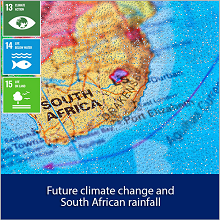
Future predictions in regional climate variability are extremely important for South Africa, a region prone to drought and flooding and home to a large population dependent on rain-fed agriculture. South African climate variability has been linked to changes in both the Agulhas system and external forcing (i.e. CO2 and ozone). Daher and Kirtman analysed future climate change in the Agulhas system and its associated impacts on South Africa’s precipitation. They used three emission scenarios (RCP2.6, RCP4.5, and RCP8.5) to understand the influence of varying greenhouse gas (GHG) emissions in future climate prediction and found that prediction of South Africa’s rainfall is dependent on the intensity of GHG emissions. When the GHG emissions are not increasing at an alarming rate (RCP2.6), ozone recovery dictates the climate response in the Agulhas system and South Africa. But when the GHGs are increasing significantly throughout the 21st century (RCP8.5), the ozone recovery signal is overpowered by the GHG forcing and trends similar to those of the ozone depletion period are witnessed.

3D printing can be used to make test phantoms for image quality assessment in planar X-ray imaging. A test phantom is a scientific device used as a stand-in for human tissue to test and calibrate medical imaging equipment. Typically, commercially available phantoms cost USD4000 to USD10 000. Noonoo and colleagues designed and printed a test phantom which was used successfully to analyse image quality parameters on general X-ray imaging systems, including resolution, contrast and contrast-to-noise-ratio. Noonoo et al.’s test phantom costs about USD150 and can be a good alternative to expensive commercially available phantoms for low-resourced medical facilities in low- and middle-income countries.
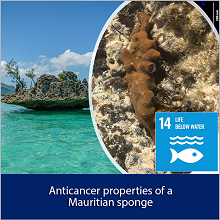
Marine sponges represent an untapped goldmine of structurally unique compounds with interesting anticancer properties. Beesoo and colleagues report on the promising anticancer activity of extracts derived from the marine sponge Neopetrosia exigua, collected from Mauritian waters. Their study provides a new understanding into the mode of action underlying the cytotoxicity of the constituents present in extracts of this Mauritian sponge. The promising inhibitory effect against liver cancer cells is mainly due to induction of apoptosis via reactive oxygen species (chemicals) in the mitochondrial pathway.
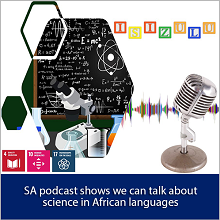
Communicating science in African languages can include more people in the public understanding of science, in science discourse and in science education, and thereby even improve health care. iLukuluku – a Zulu word for “curiosity” – is also the name of a science communication podcast that includes curious Zulu-speaking communities in scientific discourse. The podcast entertains and educates Zulu listeners of all ages, by breaking down complex scientific topics using facts, linguistic quirks and humour. Each episode is an entertaining, light-hearted dialogue between Zulu-speaking hosts Ntokozo Nomasiko Msomi, a professional language practitioner, and Sibusiso Biyela, a professional bilingual science communicator. Msomi and Biyela’s goal in each episode is to find or invent the Zulu words for a topic through conversation. iLukuluku is a practical, proudly South African example of how the community can work together to communicate science beyond English.
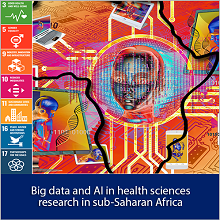
This special issue on ‘Big data and AI in health sciences research in sub-Saharan Africa’ introduces a broad range of scientific, ethical, legal and social concerns in the realm of data-intensive research and AI in sub-Saharan Africa. These transdisciplinary challenges were once in their infancy but the exponential voluminous growth in digital technology, the speed of early adoption, and the contentious debates that are emerging make engagement with the digital world a responsibility of African scientists and civil society alike.
The use of data science for health promotion is highly relevant for Africa given its many pressing public health challenges and the growing threats posed by climate change. Technology can bring enormous benefit, but it can also come at a price, and with potential harms. Africa may be especially vulnerable in this context because African critical data scholarship is relatively nascent, with critical data studies disproportionately focused on concerns in high-income countries. Also, public awareness in Africa about data science and potential concerns associated with it appears to be lower than that in high-income countries which have a longer experience with digital technology and the critical discourses surrounding it. This lower awareness of data science means communities in Africa may not be aware that what they do on the Internet or with their phones – or in interactions with their medical providers – is collected and shared for purposes largely beyond their knowledge or control.
Responsible governance is therefore required to ensure that the price we pay and the harms accrued from the benefits of technology do not outweigh the overall scientific benefit to humanity. As with any scientific enterprise, much depends on how the research is designed, how and what data are collected, and especially how the collected data are processed and managed.
The social, ethical and legal implications of data science – and the changes it will bring about in Africa – will also likely evolve and become clearer as time goes on. This special issue provides a snapshot of perspectives and findings that offer some glimpses into the future. Common themes in this issue are: an indication of the potential benefits of data science; the importance of data management, quality and integrity; challenges of engaging communities and stakeholders in data science; ethical and legal issues raised by the gathering and use of mobile phone data; the direction of AI governance in the African context; and voices from scientists and research ethics committee members.
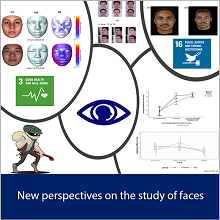
Our faces are central to how we perceive our environment through our senses; to our non-verbal communication and expression, and how we convey emotional and social information; and to our personal identity. The special significance of the face is likely the reason that the brains of primates have multiple face-selective cortical areas. It is not surprising then that the face is of interest to scientists across a range of disciplines. Research on faces includes aspects such as the brain regions involved in the complex act of cognitively processing faces, as well as practical applications such as facial recognition by computers and forensic identification.
The special section on Face Science in the current issue presents cutting-edge research and new perspectives on the study of faces within South Africa and provides insights into the promise of interdisciplinarity in the scientific study of faces. Atuhaire and colleagues used 3D face modelling to assess foetal alcohol syndrome, because facial dysmorphology is a key factor in the early diagnosis of foetal alcohol syndrome. They used a 3D face model learned from a database of registered 3D face scans to reconstruct 3D face surfaces from single frontal 2D images, as a potential low-cost method for resource-challenged contexts. Current methods for identifying the facial phenotype use 3D facial image data from expensive surface scanning devices.
Scott and colleagues applied computing methods to face images to generate synthetic faces from descriptions given by eyewitnesses, and to compare these to face composites made by witnesses with extant composite software. The reliability of facial identification evidence obtained from eyewitnesses, such as person descriptions and facial composites, is often questioned, and Scott and colleagues were interested in whether statistical models of faces could be used to produce better quality face composites than are presently possible.
Gering and colleagues examined the impact of stress on eyewitness performance in line-up face recognition tasks and found a non-linear relationship between stress and performance, with those experiencing moderate levels of stress showing better recognition accuracy than those who experienced low or high stress. Another study on face recognition looked at the own group bias (OGB), which is a tendency to better recognise faces of one's own group (being of the same race, ethnicity, age, or sex) than another group. The OGB has serious implications in criminal investigations and can lead to incorrect identifications, mistaken convictions, and wrongful imprisonment. Tredoux and colleagues aimed to determine whether the OGB occurs during encoding or retrieval of faces from memory.
These papers comprising this special section on Face Science were presented at the Face Science Symposium – an annual interdisciplinary symposium that provides a platform for researchers and practitioners from diverse academic disciplines to share their work and engage across disciplinary boundaries.
 The Global Syndemic – undernutrition, obesity and climate change – has major health and economic consequences for South Africans and our society as a whole: 1 in 5 South Africans is affected by food insecurity, and South Africa has the highest obesity prevalence in sub-Saharan Africa. Malnutrition is the most preventable cause of ill health globally, but the global food system is broken. Poor nutrition is driven by diet, diet is influenced by the food environment, the food environment forms part of and is influenced by the food system, and the food system and climate change have a bi-directional impact on one another. With increasing malnutrition and worsening climate costing billions of rands annually, this is an opportune time to review the drivers of these major challenges and search for comprehensive and efficient approaches in tackling complexities of the syndemic. Erzse and colleagues discuss the causes which arise from several issues including pricing, marketing, and the availability of nutritious food. They outline a wide range of double and triple duty policy options to simultaneously tackle the syndemic; these include the breaking down of silos of action, improving the collection and utilisation of data, scaling up nutrition financing, focusing on healthy diets in the systems, and improving the governance structure for actors in the food system. Actions will demand a more coherent policy action and breaking down of current incentive structures between industry actors and their governance.
The Global Syndemic – undernutrition, obesity and climate change – has major health and economic consequences for South Africans and our society as a whole: 1 in 5 South Africans is affected by food insecurity, and South Africa has the highest obesity prevalence in sub-Saharan Africa. Malnutrition is the most preventable cause of ill health globally, but the global food system is broken. Poor nutrition is driven by diet, diet is influenced by the food environment, the food environment forms part of and is influenced by the food system, and the food system and climate change have a bi-directional impact on one another. With increasing malnutrition and worsening climate costing billions of rands annually, this is an opportune time to review the drivers of these major challenges and search for comprehensive and efficient approaches in tackling complexities of the syndemic. Erzse and colleagues discuss the causes which arise from several issues including pricing, marketing, and the availability of nutritious food. They outline a wide range of double and triple duty policy options to simultaneously tackle the syndemic; these include the breaking down of silos of action, improving the collection and utilisation of data, scaling up nutrition financing, focusing on healthy diets in the systems, and improving the governance structure for actors in the food system. Actions will demand a more coherent policy action and breaking down of current incentive structures between industry actors and their governance.
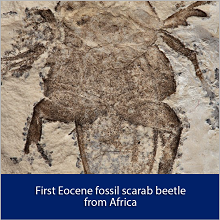
Strümpher and colleagues describe the first Eocene fossil scarab from Africa: Mahengea mckayi new genus, new species (Coleoptera: Scarabaeoidea). It is one of only a few scarab fossils from the continent and one of the best-preserved insect fossils from the otherwise rich Eocene (~45.6 mya) maar Lagerstätte at Mahenge in central northern Tanzania. A maar is a broad and shallow volcanic crater which typically fills with water to form a lake. Numerous fossil fishes and plants have been recovered from this site and described, but the dearth of insect fossils is surprising considering their richness in other deposits of similar origin and age. Strümpher et al. surmise that the rich fish fauna present in the oxygen-rich parts of the water in the former volcanic crater lake may have scavenged most of the terrestrial insects that fell into the water.

Is there currently a technological revolution? No, according to Moll. Moll challenges the mainstream notion of technological innovation and change associated with the Fourth Industrial Revolution (4IR). He suggests that examination of the history of technologies that are often held up to be proof of the 4IR, in fact shows that there is no contemporary technological revolution, merely a continuance of the Third Industrial Revolution (3IR).
In response to Moll, Marwala argues that there is a clear demarcation between the 3IR and 4IR and that the very unfolding of our response to the COVID-19 pandemic signified the 4IR in action. The impact of the pandemic and the need to switch to remote systems to adapt to lockdowns throughout the world, hastened the adoption of digital technologies.
Ntlatlapa believes that, if Moll focused on the definition of the 4IR presented initially by Schwab – that is, around the fusion of technologies across the digital, physical and biological worlds – he would come to a different conclusion.
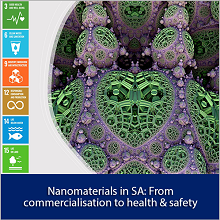 Nanotechnology has become an integral platform for the development of new innovations and technologies for almost all industrial sectors. As such, the commercial exploitation of nanotechnology has become a key focus and many countries across the globe have already seen the introduction of nanomaterial-enabled products in their marketplaces. In other countries, successful commercialisation of nanomaterials and nanotechnologies has been more difficult, with nanomaterial research resulting more often in publications than in nano-products. Dikweni and colleagues present a guide for South African university researchers on how to successfully commercialise their nanomaterial research.
Nanotechnology has become an integral platform for the development of new innovations and technologies for almost all industrial sectors. As such, the commercial exploitation of nanotechnology has become a key focus and many countries across the globe have already seen the introduction of nanomaterial-enabled products in their marketplaces. In other countries, successful commercialisation of nanomaterials and nanotechnologies has been more difficult, with nanomaterial research resulting more often in publications than in nano-products. Dikweni and colleagues present a guide for South African university researchers on how to successfully commercialise their nanomaterial research.
With increasing development and commercialisation of nanomaterials, comes the responsibility of understanding their potential implications on health, safety, and the environment (HSE). The Nanotechnology HSE Research Platform – established by the Department of Science and Technology in 2015 – has enabled South Africa to set up and grow the necessary infrastructure for the risk assessment of nanomaterials and their products. Gulumian and colleagues describe the major contributions thus far by South Africa in the field of nanomaterial HSE, within the context of current international developments, and evaluate the research needs. A glaring void that needs urgent attention in South Africa is discussion on nanomaterial HSE between industry and authorities, as such discussions have not taken place consistently.
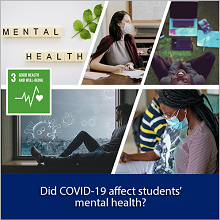
The impact of the COVID-19 pandemic on student mental health may not have been as marked in South Africa compared to other regions. For university students in South Africa, COVID-19 may have been just one more stressor they had to face amidst ongoing adversity and disruptions. Bantjes and colleagues examined the impact of COVID-19 on first-year students at two universities in South Africa by analysing changes in the prevalence and age-of-onset of three common mental disorders (namely major depressive episode, generalised anxiety disorder, and suicidal ideation) before and during the pandemic. Although COVID-19 has had far-reaching economic, social and health consequences, with particular concern expressed about university students’ mental health, Bantjes et al. found no significant changes in the 12-month prevalence of common mental disorders in students before and during COVID-19. Nevertheless, high rates of psychopathology confirm the need for sustainable campus-based interventions to support students’ well-being.
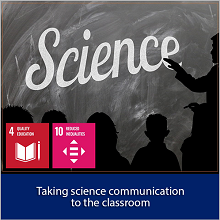 Nemadziva and colleagues examined key challenges in the science education and training pipeline in South Africa to identify factors contributing to the low throughput. They also reviewed how national science policy changes have impacted the curriculum and teaching practices across socio-economic groups. They found that most public schools (80%) lack the resources for practical learning, making it difficult for teachers to implement enquiry-based teaching methods. They recommend the use of science communication practices to design resources to enhance science teaching and learning in under-resourced schools as a more immediate solution to generate greater interest and understanding, and encourage learners to pursue careers in science.
Nemadziva and colleagues examined key challenges in the science education and training pipeline in South Africa to identify factors contributing to the low throughput. They also reviewed how national science policy changes have impacted the curriculum and teaching practices across socio-economic groups. They found that most public schools (80%) lack the resources for practical learning, making it difficult for teachers to implement enquiry-based teaching methods. They recommend the use of science communication practices to design resources to enhance science teaching and learning in under-resourced schools as a more immediate solution to generate greater interest and understanding, and encourage learners to pursue careers in science.
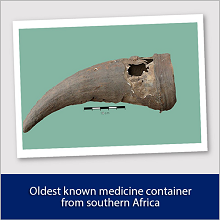 An isolated, chance discovery of a cattle-horn container sheds new light on the traditional medicines of 500 years ago. The medicine horn was found in a painted rock shelter on the farm La vie D’Antan in the Eastern Cape Province of South Africa. Bradfield and colleagues analysed the solidified substance found inside the horn container and found that it contained a medicinal substance composed of at least two plant ingredients. They cannot know for certain which plant species were used, but the main compounds present, mono-methyl inositol and lupeol, have a wide range of recorded medicinal applications, including the control of blood sugar and cholesterol levels, treatment of fevers, inflammation and urinary tract infections, and may be applied topically to treat infections.
An isolated, chance discovery of a cattle-horn container sheds new light on the traditional medicines of 500 years ago. The medicine horn was found in a painted rock shelter on the farm La vie D’Antan in the Eastern Cape Province of South Africa. Bradfield and colleagues analysed the solidified substance found inside the horn container and found that it contained a medicinal substance composed of at least two plant ingredients. They cannot know for certain which plant species were used, but the main compounds present, mono-methyl inositol and lupeol, have a wide range of recorded medicinal applications, including the control of blood sugar and cholesterol levels, treatment of fevers, inflammation and urinary tract infections, and may be applied topically to treat infections.
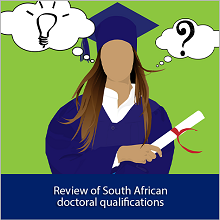
Are doctoral qualifications in South Africa educating students to be the broad and critical thinkers needed to address current and future scientific and societal challenges? Burton and colleagues address this question in their Commentary on the recently completed national review of doctoral qualifications. The national review has shown that many of the doctoral programmes offered at our universities are not intellectually, academically, and philosophically directed, and do not provide sufficiently intensive opportunities for doctoral candidates to engage in academic conversation and debate, or scholarly activities that add intellectual depth and develop high-level critical thinking. Recommendations from the review include integrating and assessing graduate attributes in every doctoral programme, and fostering attributes such as critical citizenry and consciousness of social responsibility. This review, based on the National Standard for Doctoral Qualifications established by the Council on Higher Education in 2018, was the first national review of an entire qualification type and all South African universities and private higher education institutions that offer doctoral degree qualifications participated.
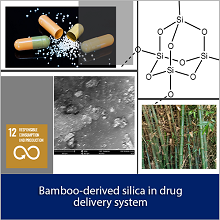 A formulation containing silica derived from bamboo stems has shown considerable cost–benefit potential for safe and regulated drug delivery. A drug delivery system is a formulation or material capable of injecting a medication into the body while managing the speed, duration, and location of its release to preserve its effectiveness and safety. Porous silica particles are used as encapsulation material for drugs because of their small size, ability to manage surface charge, optical properties, high surface area, low density and adsorption capacity delivery. However, the use of alkoxysilane silica precursors for the production of silica/polymer composite delivery material is expensive. Essien and colleagues investigated the use of silica derived from bamboo stems for the development of a controlled drug delivery system, given bamboo’s renewability and abundance in African. The ash from the bamboo stem was mixed with a polycaprolactone solution to produce a composite that was then loaded with tetracycline as a test drug. The composite released the tetracycline in a consistent and sustained way, and showed regulated degradability.
A formulation containing silica derived from bamboo stems has shown considerable cost–benefit potential for safe and regulated drug delivery. A drug delivery system is a formulation or material capable of injecting a medication into the body while managing the speed, duration, and location of its release to preserve its effectiveness and safety. Porous silica particles are used as encapsulation material for drugs because of their small size, ability to manage surface charge, optical properties, high surface area, low density and adsorption capacity delivery. However, the use of alkoxysilane silica precursors for the production of silica/polymer composite delivery material is expensive. Essien and colleagues investigated the use of silica derived from bamboo stems for the development of a controlled drug delivery system, given bamboo’s renewability and abundance in African. The ash from the bamboo stem was mixed with a polycaprolactone solution to produce a composite that was then loaded with tetracycline as a test drug. The composite released the tetracycline in a consistent and sustained way, and showed regulated degradability.
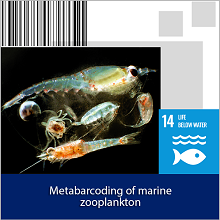
Metabarcoding has been successfully applied to marine zooplankton for the first time in South Africa, demonstrating its potential as a tool to generate ecosystem indicators during routine ocean observations. Zooplankton play a key role in marine food webs and carbon cycling and are useful indicators of climate-related changes and ocean health in pelagic ecosystems. Zooplankton are traditionally identified to species through microscopy, but new molecular techniques have enabled the identification of individual specimens (DNA barcoding) or multiple species in the same sample (DNA metabarcoding). Huggett and colleagues report on both methodological and logistical considerations in the use of metabarcoding for the rapid and accurate measurement of marine zooplankton biodiversity and relative abundance, and its potential application as a long-term indicator of pelagic ecosystem status in South African coastal and neritic waters. Challenges to the implementation of DNA-based methods to measure zooplankton biodiversity easily and routinely include an incomplete DNA barcode reference library, logistical complexity and uptake of the new technology by environmental management agencies. These challenges call for a national effort to intensify zooplankton barcoding initiatives and to effectively engage stakeholders in developing a roadmap towards application of DNA-based methods in marine environmental management.
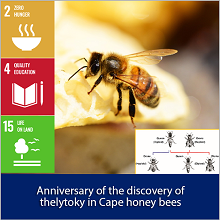 The existence of thelytoky in Cape honey bees was first documented in 1912 – making 2022 the 110th anniversary of this discovery, although its significance would only be fully appreciated decades later. Thelytoky, or the ability of Cape honey bee workers to lay eggs that develop into diploid (female) individuals was first described by George William Onions (1866–1941), a hobbyist beekeeper, in 1912. This reproductive parasitism involves laying workers of the Cape honey bee (Apis mellifera capensis) invading healthy host colonies of the Savannah honey bee (A. m. scutellata), laying unfertilised diploid eggs and producing other workers that are also reproductively active. The newly emerged workers in turn seek out and invade other colonies, eventually leading to dwindling and collapse of the host colonies – the ‘Capensis calamity’. An estimated 50 000–100 000 honey bee colonies were lost in 1993. In their Commentary, Mumoki and colleagues examine the consequences of thelytokous parthenogenesis and outline what is being done to understand and limit the spread of the laying workers of the Cape honey bee.
The existence of thelytoky in Cape honey bees was first documented in 1912 – making 2022 the 110th anniversary of this discovery, although its significance would only be fully appreciated decades later. Thelytoky, or the ability of Cape honey bee workers to lay eggs that develop into diploid (female) individuals was first described by George William Onions (1866–1941), a hobbyist beekeeper, in 1912. This reproductive parasitism involves laying workers of the Cape honey bee (Apis mellifera capensis) invading healthy host colonies of the Savannah honey bee (A. m. scutellata), laying unfertilised diploid eggs and producing other workers that are also reproductively active. The newly emerged workers in turn seek out and invade other colonies, eventually leading to dwindling and collapse of the host colonies – the ‘Capensis calamity’. An estimated 50 000–100 000 honey bee colonies were lost in 1993. In their Commentary, Mumoki and colleagues examine the consequences of thelytokous parthenogenesis and outline what is being done to understand and limit the spread of the laying workers of the Cape honey bee.
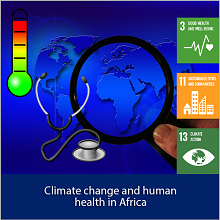 As temperatures increase across Africa, there is an urgent need to develop heat-health plans and implement interventions. Manyuchi and colleagues conducted a systematic review of published studies on how heatwaves and high ambient temperatures affect morbidity and mortality in Africa. Although heat-health relationships in Africa are complex, extreme temperatures are associated with high mortality and morbidity, especially amongst vulnerable populations such as children and the elderly. Location-specific interventions and policy suggestions include developing early warning systems, creating heat-health plans, changing housing conditions and implementing heat-health awareness campaigns. Future studies must document intervention effectiveness and quantify the costs of action and inaction on extreme heat-related mortality and morbidity.
As temperatures increase across Africa, there is an urgent need to develop heat-health plans and implement interventions. Manyuchi and colleagues conducted a systematic review of published studies on how heatwaves and high ambient temperatures affect morbidity and mortality in Africa. Although heat-health relationships in Africa are complex, extreme temperatures are associated with high mortality and morbidity, especially amongst vulnerable populations such as children and the elderly. Location-specific interventions and policy suggestions include developing early warning systems, creating heat-health plans, changing housing conditions and implementing heat-health awareness campaigns. Future studies must document intervention effectiveness and quantify the costs of action and inaction on extreme heat-related mortality and morbidity.
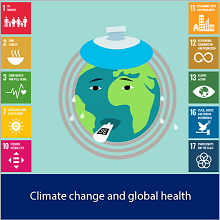
South Africa is a microcosm of the world, with its local threats and challenges mirroring the global. According to Benatar, instabilities that pervade the world, highlighted by the COVID-19 pandemic, are especially significant for South Africa, where they manifest most starkly because of its apartheid legacy, its relative success economically on the African continent, and the implications of ongoing widening disparities and antagonism amongst South Africa’s diverse people. Belief in moving towards narrowing wide disparities through decolonisation and reversion to an ‘idyllic African heritage’ via a transformation that includes widespread corruption, and the ANC government’s perverse erosion of lives today and in the future through ‘state capture’, intensifies rather than ameliorates our predicament in an era when cooperation and a clear vision of current threats and future possibilities are desperately needed.
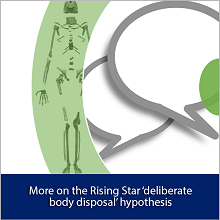 The hypothesis that about 1500 Middle Pleistocene hominin bones represent the remains of complete corpses deposited deliberately in Rising Star Cave by conspecifics is provocative. This is because intentional handling of dead bodies might imply these hominins had developed a uniquely human sense of mortality salience more than 235 000 years ago. Egeland and colleagues and Pettitt interrogate this hypothesis.
The hypothesis that about 1500 Middle Pleistocene hominin bones represent the remains of complete corpses deposited deliberately in Rising Star Cave by conspecifics is provocative. This is because intentional handling of dead bodies might imply these hominins had developed a uniquely human sense of mortality salience more than 235 000 years ago. Egeland and colleagues and Pettitt interrogate this hypothesis.

In these times – as we sit on the horizon of the emergence of a not yet fully determinable world – radical thought, science, ethics, institutional arrangements, and other shared systems of valuation and understanding, are required to give depth and meaning to the full articulation of the questions that we need to be asking now to engender the arrival of a just and equal world to come. No one discipline or system of thought can answer, or fully account for, the questions we are facing as humanity today. This is the time for Radical Reason.
This special issue on ‘Radical Reason’ brings together a selection of critical contributions from thinkers from around the world, who all offer provocations for thinking anew what it means to be human now and here. In these contributions, structured as interviews, conversations and dialogues, a series of intense engagements is undertaken with some of the foremost intellectuals in the world to reflect on the future of knowledge, critique and thought.
The theme of Radical Reason was conceptualised as a deliberate attempt to engage with the history of the humanities and social sciences in South Africa and to invite discussion and debate about the future of the planet. It affirms a commitment to the ideal of reason but looks, deliberately, to radically enlarge its logics. Radical Reason anticipates the supplementation of the global archive with its absent and diminished African narrative, so as to enable it to imagine for itself a new and inclusive future. In so doing, the aim of the Radical Reason initiative is to consider – and show – how African thought had and could contribute to the development of new logics and new forms of reason.
The contributions that comprise this special issue capture or extend presentations and conversations that took place at the Science Forum South Africa in 2020 as part of the ‘Conversations with Global Thinkers’ series of the Human Sciences Research Council (HSRC) Consortium. This Consortium was led by the HSRC and included the Academy of Science of South Africa, Universities South Africa, the International Science Council, and several humanities faculties throughout the country and was established on the occasion of the 50th anniversary of the HSRC and the 90th anniversary of its predecessor, the National Bureau for Educational and Social Research, to interrogate the role of the social sciences and the humanities in tackling the multiple developmental challenges of South Africa and the world. Prompted by the global events of 2020 which saw life, science and race raised to new profiles with the spread of the novel coronavirus and the protests around Black Lives Matter, this special issue, building off the contributions of the HSRC Radical Reason Consortium, seeks to stimulate and engage critical knowledges that reflect the full complexity of the lived experiences and conditions of the world.
This special issue was convened and guest edited by Rachel Adams (Principal Researcher, Research ICT Africa, Cape Town, South Africa) and Crain Soudien (Adjunct Professor, Cape Peninsula University of Technology, Cape Town, South Africa). The contributions emanate from the HSRC Radical Reason ‘Conversations with Global Thinkers’ series that took place at the 2020 Science Forum South Africa. The publication of this special issue was sponsored by the Human Sciences Research Council (HSRC) of South Africa.

Adopting zero-tolerance drink-driving legislation – at a reduced blood alcohol threshold of 0.02 g/100 mL and introduced gradually – within a broader zero tolerance approach offers a critical window of opportunity to address drink-driving and advance road safety in South Africa. Alcohol is a major contributing factor to the burden of road traffic crashes and injuries in South Africa and the proposed amendment to the National Road Traffic Act of a zero blood alcohol concentration is aimed at reducing fatalities. Sukhai and colleagues critically examined global research and experiences with the adoption of zero-tolerance approaches to drink-driving and found that very few countries have adopted strict zero-tolerance legislation on drink-driving. However, there is significant evidence to support the adoption of zero-tolerance legislation but at a blood alcohol concentration threshold limit for the general driving population of 0.02 g/100 mL rather than the proposed limit of zero. Sukhai and colleagues further recommend a gradualist approach as well as complementary interventions including measures relating to enforcement, education, awareness-raising, and harm reduction such as designated-driver and safe-ride-home schemes.
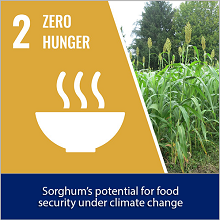 An integrated approach is needed to increase sorghum production in South Africa. Extreme events, declining rainfall and increasing temperatures under climate change threaten the food security and livelihoods of smallholder households. Sorghum (Sorghum bicolor) is a climate-resilient crop known for its ability to withstand heat and drought stresses and thus has the potential to bolster food and livelihoods of smallholder farmers in South Africa. Yet a combination of socio-economic, socio-cultural and biophysical challenges limit sorghum production and performance in South Africa. Dunjana and colleagues review these factors and recommend increasing awareness, policy development and support, and capacitation of extension services, as well as improving market access, agronomic and cultural practices, and availability of more locally adapted sorghum varieties to address the prevailing constraints limiting sorghum production.
An integrated approach is needed to increase sorghum production in South Africa. Extreme events, declining rainfall and increasing temperatures under climate change threaten the food security and livelihoods of smallholder households. Sorghum (Sorghum bicolor) is a climate-resilient crop known for its ability to withstand heat and drought stresses and thus has the potential to bolster food and livelihoods of smallholder farmers in South Africa. Yet a combination of socio-economic, socio-cultural and biophysical challenges limit sorghum production and performance in South Africa. Dunjana and colleagues review these factors and recommend increasing awareness, policy development and support, and capacitation of extension services, as well as improving market access, agronomic and cultural practices, and availability of more locally adapted sorghum varieties to address the prevailing constraints limiting sorghum production.

High-resolution geospatial data are needed in multi- and transdisciplinary research to better analyse fine-scale biotic–abiotic interactions within ecosystems, particularly in the contexts of the impacts of climate change and invasive species. Rudolph and colleagues present an online geospatial database for the Prince Edward Islands produced from a high-resolution digital surface model and satellite imagery. Their database contains vector files, raster data sets, and maps of topographical and hydrological parameters and is available from an open access data repository. They encourage the South African polar science community to make use of similar platforms for improved data sharing practices.
 The built environment is a critical part of the climate change problem in cities. Energy efficiency interventions in the building sector offer substantial mitigation potential within the most feasible payback periods when compared to other sectors. Elias and Thambiran developed a marginal abatement cost curve (MACC) to assess the costs in achieving the emissions-reduction potential for each high-emitting sector in the eThekwini Municipality. They found that the building sector offers the lowest cost to mitigate each tonne of greenhouse gases when compared to other sectors in the Municipality. The MACC produced in their study is the first of its kind for any municipality in South Africa and can be replicated by other municipalities to support prioritisation of actions needed to address climate change.
The built environment is a critical part of the climate change problem in cities. Energy efficiency interventions in the building sector offer substantial mitigation potential within the most feasible payback periods when compared to other sectors. Elias and Thambiran developed a marginal abatement cost curve (MACC) to assess the costs in achieving the emissions-reduction potential for each high-emitting sector in the eThekwini Municipality. They found that the building sector offers the lowest cost to mitigate each tonne of greenhouse gases when compared to other sectors in the Municipality. The MACC produced in their study is the first of its kind for any municipality in South Africa and can be replicated by other municipalities to support prioritisation of actions needed to address climate change.
 Both the participation and productivity of women in academia, and especially black women, have increased, particularly in the areas of agriculture and engineering. Yet despite the substantial increases in the share of female-authored publications and participation of female academic staff, there remains a large gender gap. Mouton and colleagues provide an updated picture of the contribution of female academics to university research output in South Africa from 2005 to 2020.
Both the participation and productivity of women in academia, and especially black women, have increased, particularly in the areas of agriculture and engineering. Yet despite the substantial increases in the share of female-authored publications and participation of female academic staff, there remains a large gender gap. Mouton and colleagues provide an updated picture of the contribution of female academics to university research output in South Africa from 2005 to 2020.
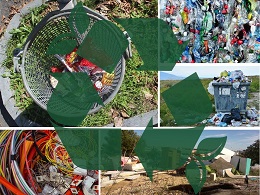
Waste can take many forms – organic waste, municipal solid waste, light industrial waste, construction and demolition waste, electronic and electrical waste (e-waste) and mining waste. Returning waste fractions to some form of use and converting that which cannot be used into a more societally acceptable end-form recognises that waste is an integral part of economic activity within the societal context. Waste management needs to evolve from consigning waste to ever-increasing landfills as a final resting place towards being a regular economic activity within a socio-economic framework.
Circularity, with a focus on waste management, influences social and economic resilience as well as planetary health. South Africa combines many characteristics of the economies of a developed and developing nation. This dual nature is also reflected in waste management interventions with well-managed landfill sites co-existing with waste pickers who reclaim materials that can be gainfully recycled. South Africa has a reasonable legislative waste management framework which recognises the need and opportunity for circularity, yet the existing systems make economic activity in this space cumbersome, forcing activities to legal and economic margins.
The Community of Practice (CoP) ‘Waste to Value: Transitioning South Africa towards a Waste-to-Resource Circular Economy’ brought together an interdisciplinary collective of experts to explore the nexus between existing waste management practice, legislation, and the socio-economic realities in South Africa. A key realisation of the CoP is that addressing the status quo will require local solutions to the global problem, recognising that turning waste materials back into economic commodities needs to fit within the local socio-economic context, and there is no global one-size-fits-all solution. In going forward, the CoP intends to formulate a meaningful strategy by which material flows in the South African economy thus far considered as waste are evaluated for their potential to be returned into the local economic cycle in the most sustainable fashion. To achieve this, a continued multidisciplinary approach is needed that draws on the expertise of sociologists, economists, legal experts and technologists, and takes cognisance of local and national socio-economic realities and aspirations.
This special issue presents 12 articles that reflect on perceptions of waste, investigate municipal solid waste management practice, explore the socio-economic realities of waste pickers, and study the legal framework that governs our relationship with an increasingly complex material legacy in South Africa. Transition to a sustainable circular economy will need to focus on establishing a material transformation process more akin to biogenic circular flows. Waste reduction strategies, re-design, and a focus on end-of-life management in the South African socio-economic context is at the heart of the CoP. The thinking that guides the formulation of potential pathways towards this transition is reflected in the articles published in this special issue.
This special issue was convened by and edited in partnership with the South African Research Chairs (SARChI) in the CoP: Waste to Value:
Professor Hanri Mostert (UCT), SARChI: Mineral Law in Africa
Professor Jochen Petersen (UCT), SARChI: Minerals Beneficiation
Professor Catherina Schenck (UWC), SARChI: Waste and Society
Professor Anne Stark (UKZN), SARChI: Sugarcane Biorefining
Professor Cristina Trois (UKZN), SARChI: Waste and Climate Change
with assistance from Aysha Lötter, Project Manager, CoP: Waste to Value.
The publication of this special issue was sponsored by the CoP: Waste to Value, funded by the National Research Foundation (NRF) of South Africa (grant UID 128149). The NRF cannot be held liable for any of the authors’ stated opinions, findings and conclusions.

The Comrades Marathon, South Africa's most iconic road running event, will be held on 28 August 2022 – much later in the year than the usual May/June date. Consequently, runners are more likely to experience heat-related illness along the route. The change in date prompted Havenga and colleagues to examine the likelihood of extreme heat events occurring on the new date using the Universal Thermal Comfort Index (UTCI). Although their analysis does not predict the weather for the 2022 date, they showed that UTCI values representing an intense heat stress response are historically more likely to occur in late August than in late May and early June. When athletes are exposed to warmer conditions, the body exhibits an adverse physiological response, decreasing performance and, in extreme cases, leading to heatstroke and hospitalisation. Hydration, clothing and pacing need to be adapted to the weather conditions on the day to reduce possible adverse physiological effects.
Exposure to extreme heat conditions could adversely affect a runner's performance and health. Photo: Don Havenga
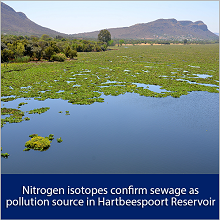 The Hartbeespoort Reservoir in the Crocodile River catchment has suffered water pollution and invasive water hyacinth plants for decades. Upgrades to sewage works and sanitation in the Gauteng area hold the key to cleaning up the Crocodile River catchment. High levels of nitrogen in water make the hyacinth grow at an "Olympic" pace and no attempt, whether chemical, biological or manual, will win the fight against this water weed. Diamond and Germishuys sampled these plants and analysed their nitrogen isotopes, confirming the view that overflowing sewage works and informal settlements with no toilets are the main source of pollution in this water. This technique is not new, but has likely never been used in Africa before, and so the potential exists to use plant or animal samples to trace the source of water pollution elsewhere.
The Hartbeespoort Reservoir in the Crocodile River catchment has suffered water pollution and invasive water hyacinth plants for decades. Upgrades to sewage works and sanitation in the Gauteng area hold the key to cleaning up the Crocodile River catchment. High levels of nitrogen in water make the hyacinth grow at an "Olympic" pace and no attempt, whether chemical, biological or manual, will win the fight against this water weed. Diamond and Germishuys sampled these plants and analysed their nitrogen isotopes, confirming the view that overflowing sewage works and informal settlements with no toilets are the main source of pollution in this water. This technique is not new, but has likely never been used in Africa before, and so the potential exists to use plant or animal samples to trace the source of water pollution elsewhere.
Water hyacinth (Eichhornia crassipes) colonising the Hartbeespoort Dam. Image: CC-BY-SA 4.0: Olga Ernst
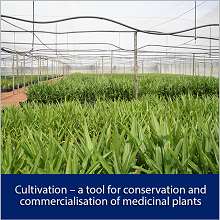
The worldwide trade in plant-based medicine increased from ZAR192 billion (USD30 billion) in 2000 to ZAR1.01 trillion (USD940 billion) in 2014. According to Mofokeng and colleagues, cultivation of medicinal plants provides several opportunities, including preservation of indigenous plants and related knowledge, access to primary health care through traditional medicine, local economic development, and job creation. Whereas unsustainable harvesting for income generation, land clearing for developments, and other human activities have led to the extinction of a number of medicinal plants, such as African ginger (Siphonichillus aethiopicus). Cultivation can improve biomass production for sustainable supply without negatively affecting the bioactivity or “power” of the medicinal plants. Over-supply of medicinal plant materials can negatively impact prices, and, therefore, cultivation needs to be managed in terms of market demand.
Image: African ginger cultivation
 Bamboo has potential as an environmentally friendly construction material in South Africa. Bamboo products such as floorboards are popular in South Africa, but using whole stems (culms) in bamboo construction is uncommon, even though bamboo is found in various parts of the country. Given the need for environmentally friendly construction materials and technologies, Ross and Alexander conducted literature-based research to determine the viability of whole-culm bamboo as a construction technology for South Africa. South Africa has one bamboo species considered suitable for construction – Bambusa balcooa – but the South African variety has not been evaluated in terms of its material properties. Engineering design approaches and material properties reported in the literature indicate that this species is a viable construction material. The limitations of bamboo design and construction are common to those countries where bamboo is used in construction. Their experience in overcoming these limitations can be transferred to South Africa, making bamboo construction a potentially viable construction technology for us.
Bamboo has potential as an environmentally friendly construction material in South Africa. Bamboo products such as floorboards are popular in South Africa, but using whole stems (culms) in bamboo construction is uncommon, even though bamboo is found in various parts of the country. Given the need for environmentally friendly construction materials and technologies, Ross and Alexander conducted literature-based research to determine the viability of whole-culm bamboo as a construction technology for South Africa. South Africa has one bamboo species considered suitable for construction – Bambusa balcooa – but the South African variety has not been evaluated in terms of its material properties. Engineering design approaches and material properties reported in the literature indicate that this species is a viable construction material. The limitations of bamboo design and construction are common to those countries where bamboo is used in construction. Their experience in overcoming these limitations can be transferred to South Africa, making bamboo construction a potentially viable construction technology for us.
Bamboo growing in the Western Cape. Photo: Sheila Ross
 Electrification is expected to decarbonise transportation and forms part of the agenda to delay climate change. Electric vehicle sales have ballooned and production of combustion engines will stop soon. In sub-Saharan Africa the transition is slow. Crucial knowledge gaps, explored by Booysen and colleagues, include the potential demand and where and when this demand will occur. Minibus taxis carry more than 70% of commuters and little is known about their electrification requirements. Electrical demand planning is better with vehicle-based data than with passenger-based data. Stationary times provide ample time for taxis to recharge from the grid and solar, but using solar power requires substantial stationary battery capacity to negate grid-impacting fast charging.
Electrification is expected to decarbonise transportation and forms part of the agenda to delay climate change. Electric vehicle sales have ballooned and production of combustion engines will stop soon. In sub-Saharan Africa the transition is slow. Crucial knowledge gaps, explored by Booysen and colleagues, include the potential demand and where and when this demand will occur. Minibus taxis carry more than 70% of commuters and little is known about their electrification requirements. Electrical demand planning is better with vehicle-based data than with passenger-based data. Stationary times provide ample time for taxis to recharge from the grid and solar, but using solar power requires substantial stationary battery capacity to negate grid-impacting fast charging.
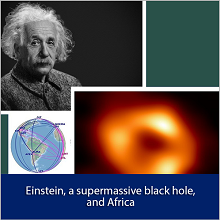 The Event Horizon Telescope (EHT) Collaboration recently released the first images of the supermassive black hole in the heart of the Milky Way galaxy. The ring size and shape in these images are consistent with Einstein’s general theory of relativity. The location of this black hole in southern skies and its rapidly changing appearance mean that expanding the EHT into Africa is critical to optimally utilise this unique gravitational laboratory in the future. Deane and Natarajan explain how leveraging our southern African geographic advantage will turn images into high-fidelity movies – a game-changing milestone for precision tests of gravity with the next-generation EHT. More equitable involvement of African countries and researchers in large-scale international scientific collaborations also has the potential to grow human capacity and technology development. Perhaps a deeper legacy of African EHT stations would be to spur further innovation, inspire local youths to excellence, and foster greater equality in science collaboration between the Global South and the rest of the world.
The Event Horizon Telescope (EHT) Collaboration recently released the first images of the supermassive black hole in the heart of the Milky Way galaxy. The ring size and shape in these images are consistent with Einstein’s general theory of relativity. The location of this black hole in southern skies and its rapidly changing appearance mean that expanding the EHT into Africa is critical to optimally utilise this unique gravitational laboratory in the future. Deane and Natarajan explain how leveraging our southern African geographic advantage will turn images into high-fidelity movies – a game-changing milestone for precision tests of gravity with the next-generation EHT. More equitable involvement of African countries and researchers in large-scale international scientific collaborations also has the potential to grow human capacity and technology development. Perhaps a deeper legacy of African EHT stations would be to spur further innovation, inspire local youths to excellence, and foster greater equality in science collaboration between the Global South and the rest of the world.
The global COVID-19 pandemic has affected every aspect of our lives: our physical and mental well-being, freedoms, employment, education and career trajectories – unequally – and thus has also exacerbated the racial, gender and socio-economic inequalities prevalent in our country.
This special issue, ‘How to do social distancing in a shack’, on COVID-19 in a South African context, addresses some of these effects, from the unfeasibility of some communities to comply with the restrictions of early lockdown, to the ethics of mandatory vaccination and our economic recovery over the decades to come. Edited by Professors Jonathan Jansen and Shabir Madhi, this special issue aims to bring together the best thinking in the social sciences and biomedical sciences to work through the complex challenges posed by COVID-19.
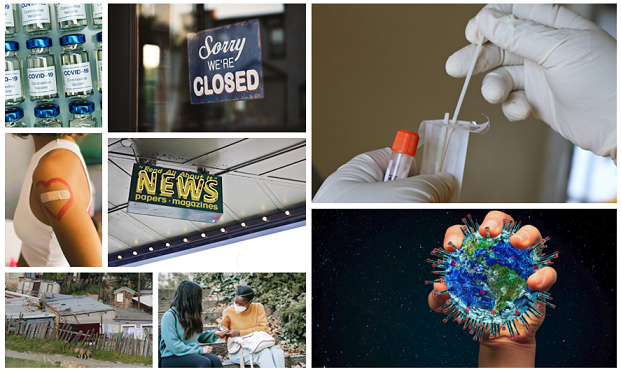
Despite COVID-19’s worldwide effects, experiences of the pandemic have been varied and context-specific. Ellison and colleagues show that economic vulnerability and poor service delivery were more important determinants of compliance with COVID-19 restrictions for shack-dwellers than housing quality and Van Wyk & Reddy explain why social distancing in a shack was not possible, highlighting how local contextual factors (re)shape the form of policy responses as well as their associated consequences. They motivate for a ‘politics of informality’ which can better inform policy as it is situational, contingent, and informed by the daily realities of the people thereby affected. Even within communities, experiences differed. Theron and colleagues further explore what places young adult township dwellers at risk for not complying with social distancing.
The COVID-19 interventions further aggravated pre-existing and rising unemployment and poverty levels. By 2021, only 42% of the working-age population in South Africa was employed. Altman shows that, after a rapid and significant fall caused by the policies to manage COVID-19, employment might only recover to peak 2018 levels by 2024–2026.
The pandemic has amplified the divide between the career-life prospects of learners with sufficient access to educational resources and support and those without such access. Maree proposes that ‘hope-, purpose-, and action’-enhancing counselling for self and career counselling can bolster the sense of agency, empowerment, dignity, and self-worth of learners in underprivileged contexts, thereby promoting career adaptability and improving their present and future employability. Similarly, Walters and colleagues show how the pandemic has deepened the systemic and institutionalised inequalities that female academics experience.
Gender inequalities were also evident in the media representation of scientists during the COVID-19 pandemic. Joubert and colleagues show that male academics were disproportionately featured as expert voices in the South African mass media, as were those experts in the field of health and medicine.
Pre-existing inequities predispose vulnerable groups to poor disease outcomes and more limited access to health interventions. Jassat and colleagues compared demographic characteristics and trends in hospital admissions and the health care they received. Using multivariable analyses, they found that black African patients, coloured patients, and patients of Indian descent had increased risk of in-hospital COVID-19 mortality compared with white patients. Admission to a public hospital was also associated with increased risk of mortality compared with admission to a private hospital.
In addition to reported COVID-19 deaths, Bradshaw et al. show that there were three times the excess deaths from natural causes in South Africa during 2020 and 2021. Although the causes of these deaths remain unknown, the strong temporal correlation between excess deaths and reported COVID-19 deaths within each province indicates that the majority of excess deaths were probably associated with COVID-19. Making use of death data from the National Population Register made it possible to track in near-real time the number of excess deaths in South Africa.
Although the global response to COVID-19 has demonstrated that some progress has been made in ensuring timely access to new medical interventions in Africa, Rees and colleagues argue that much more needs to be done to strengthen the global systems that enable equitable access to health technologies during public health emergencies. To this end, dos Santos et al. debate whether intellectual property protection of medical products and devices required to prevent, treat and contain COVID-19 should be waived, as proposed by South Africa and India, under the World Trade Organization’s Agreement on Trade-Related Aspects of Intellectual Property Rights.
Vaccines are central to an appropriate response to protect public health, health systems and the economy. Moodley explores vaccine mandates in South Africa – a country with a high prevalence of HIV, vulnerable unvaccinated adults and children, and a fragile public health system – from an ethical perspective.
South African scientists, with a long history of studying viral evolution and antibody responses, were well positioned to pivot their research to focus on SARS-CoV-2. Moyo-Gwete and Moore describe how the expertise and infrastructure developed over decades for HIV vaccine research enabled South Africa to take a leadership role in studying the antibody response elicited by SARS-CoV-2 infection and vaccination. Despite this expertise, the paucity of COVID-19 vaccine trials conducted on the African continent is a cause for concern and has implications for the role that Africa may play in future pandemics. Wiysonge and colleagues argue that Africa needs to allocate public funds to fund research, development, and innovation; invest in clinical trial capacity; and improve regulatory pathways to facilitate timely participation in vaccine trials.
In vaccine trials, electronic consent is an invaluable option for enabling large numbers of participants quickly and efficiently from scattered geographical locations under conditions that preclude close contact. Nair and colleagues report that the electronic consent process of the SISONKE Trial was easily navigated by healthcare professionals with access to electronic devices and data, but that a third of participants did not recall that breakthrough infections and adverse events had to be reported.
Healthcare workers have been at the frontline of the pandemic. Hoare describes the frontline psychological experience as similar to that of wartime combat. The collective stressors experienced by healthcare workers must be recognised to ensure appropriate support is provided to help them recover.
Where to from here?
With SARS-CoV-2 likely to remain in circulation for the foreseeable future, Suliman and Mtsweni examine the data and evidence of the effect of non-pharmaceutical interventions, and find that, although they likely delayed the transmission of the virus, they had little effect in mitigating or eliminating onward transmission. The difficulties in implementing these measures, as well as their harmful socio-economic consequences, need to be understood in the South African context.
Because context matters. Jansen and Madhi outline what we have learned from the contributions in this special issue: the biomedical sciences cannot provide vital insights into questions of ethics, compliance, governance, representation, well-being and the nature of (academic) work that emerge from pandemic disruption; complementary perspectives, both medical and social, can lead to more effective management of pandemics; and context matters. You can’t do social distancing in a shack.
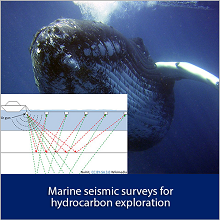 South Africa’s pursuit of energy self-sufficiency through local fossil fuel extraction should not come at the cost of its unique biodiversity nor planetary health. In an Invited Commentary, Singh and colleagues outline the immediate, intermediate, and long-term implications of seismic surveys for hydrocarbon exploration. There is ample evidence that seismic surveys have an immediate and detrimental impact on a diverse range of marine species, including mammals, fish, invertebrates, plankton, and reptiles. Then, if seismic surveys detect feasible hydrocarbon deposits, they effectively serve as a precursor to hydrocarbon extraction and consumption. In the intermediate term, extraction activities pose dire risks for the environment; the accidental release of a contaminant can have a devastating impact on ecosystems. In the long term, actively seeking new hydrocarbon deposits to exploit will contribute to already dangerously high levels of greenhouse gases (GHG) in the earth’s atmosphere, thereby posing an existential threat to most life on earth. Seen in these immediate, intermediate and long-term contexts, rationalising the boring of wells to exploit hydrocarbons in the name of energy sovereignty and security, is short-sighted, nationalistic, environmentally irresponsible, and morally indefensible. We, as a country, need to rethink this strategy.
South Africa’s pursuit of energy self-sufficiency through local fossil fuel extraction should not come at the cost of its unique biodiversity nor planetary health. In an Invited Commentary, Singh and colleagues outline the immediate, intermediate, and long-term implications of seismic surveys for hydrocarbon exploration. There is ample evidence that seismic surveys have an immediate and detrimental impact on a diverse range of marine species, including mammals, fish, invertebrates, plankton, and reptiles. Then, if seismic surveys detect feasible hydrocarbon deposits, they effectively serve as a precursor to hydrocarbon extraction and consumption. In the intermediate term, extraction activities pose dire risks for the environment; the accidental release of a contaminant can have a devastating impact on ecosystems. In the long term, actively seeking new hydrocarbon deposits to exploit will contribute to already dangerously high levels of greenhouse gases (GHG) in the earth’s atmosphere, thereby posing an existential threat to most life on earth. Seen in these immediate, intermediate and long-term contexts, rationalising the boring of wells to exploit hydrocarbons in the name of energy sovereignty and security, is short-sighted, nationalistic, environmentally irresponsible, and morally indefensible. We, as a country, need to rethink this strategy.
 In South Africa, energy impoverished communities – those with constrained access to modern forms of energy – are dependent on a mixture of solid fuels like wood or coal and hydrocarbons such as paraffin. These, especially paraffin use, are associated with significant negative health outcomes, particularly burns due to accidental fires and spillages, but also paraffin ingestion, and toxic fume inhalation. The energy-poor furthermore suffer disproportionate long-term social, economic and psychological impacts that entrench their impoverished conditions. There is both international and national recognition of these adverse effects of energy poverty and that the universal access to safe and sustainable energy is crucial for the attainment of health and other global social, economic and well-being goals. Van Niekerk and colleagues call on South Africa to expedite access to modern energy usage, through the enactment of a substantive policy on the provision of safe, clean and affordable energy for energy-impoverished communities and households.
In South Africa, energy impoverished communities – those with constrained access to modern forms of energy – are dependent on a mixture of solid fuels like wood or coal and hydrocarbons such as paraffin. These, especially paraffin use, are associated with significant negative health outcomes, particularly burns due to accidental fires and spillages, but also paraffin ingestion, and toxic fume inhalation. The energy-poor furthermore suffer disproportionate long-term social, economic and psychological impacts that entrench their impoverished conditions. There is both international and national recognition of these adverse effects of energy poverty and that the universal access to safe and sustainable energy is crucial for the attainment of health and other global social, economic and well-being goals. Van Niekerk and colleagues call on South Africa to expedite access to modern energy usage, through the enactment of a substantive policy on the provision of safe, clean and affordable energy for energy-impoverished communities and households.
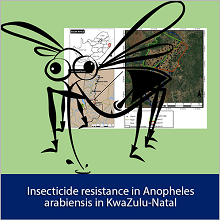 Insecticide resistance in the major malaria vector Anopheles arabiensis in northern KwaZulu-Natal Province is cause for concern in terms of resistance management and ongoing vector control leading toward malaria elimination. Munhenga and colleagues assessed the Anopheles species assemblage in northern KwaZulu-Natal and collected insecticide susceptibility data for An. arabiensis, the primary vector of malaria in KwaZulu-Natal. They found that, despite ongoing control interventions, northern KwaZulu-Natal remains receptive to malaria, owing to the perennial presence of several Anopheles vector species. The contribution to malaria transmission by several mosquito species, variation in their resting behaviours and low levels of insecticide resistance makes it necessary to periodically monitor Anopheles species assemblages and resistance phenotypes in vector populations.
Insecticide resistance in the major malaria vector Anopheles arabiensis in northern KwaZulu-Natal Province is cause for concern in terms of resistance management and ongoing vector control leading toward malaria elimination. Munhenga and colleagues assessed the Anopheles species assemblage in northern KwaZulu-Natal and collected insecticide susceptibility data for An. arabiensis, the primary vector of malaria in KwaZulu-Natal. They found that, despite ongoing control interventions, northern KwaZulu-Natal remains receptive to malaria, owing to the perennial presence of several Anopheles vector species. The contribution to malaria transmission by several mosquito species, variation in their resting behaviours and low levels of insecticide resistance makes it necessary to periodically monitor Anopheles species assemblages and resistance phenotypes in vector populations.
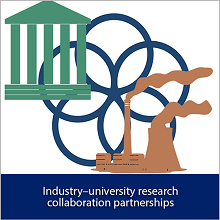 In addition to the benefits of such partnerships, both industry and universities experience challenges in the academic engagement sphere of industry–university collaboration. Malherbe and colleagues propose and evaluate a contractual structuring instrument (in the form of a Framework Research Agreement) in support of research collaboration partnerships between universities and large industry in the South African context. By providing insight from both industry and university perspectives, factors impacting on academic engagement (with specific emphasis on the legislative framework, contractual aspects, institutional research contract practices and institutional risks) can be considered for improved industry–university collaboration.
In addition to the benefits of such partnerships, both industry and universities experience challenges in the academic engagement sphere of industry–university collaboration. Malherbe and colleagues propose and evaluate a contractual structuring instrument (in the form of a Framework Research Agreement) in support of research collaboration partnerships between universities and large industry in the South African context. By providing insight from both industry and university perspectives, factors impacting on academic engagement (with specific emphasis on the legislative framework, contractual aspects, institutional research contract practices and institutional risks) can be considered for improved industry–university collaboration.
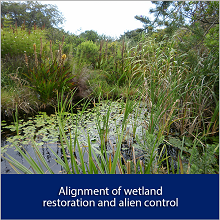 Wetland restoration and alien control need to be integrated to preserve South Africa’s water resources. Two of the biggest conservation challenges that South Africa faces are the control of invasive alien plants and the prevention of the loss of wetland resources against land degradation. The government invests heavily in programmes that address these challenges. Sieben and colleagues undertook an inventory of wetland vegetation across the country and generated a list of the most common invasive alien plants across South Africa. Many of the plants on that list do not correspond with the priorities in the programmes for alien control, as they are not listed on a government produced list that guides the priorities for alien control. They argue that because wetlands are such important parts of the landscape, invasive aliens in wetlands are of special concern, and there should be more alignment between alien control programmes and wetland rehabilitation programmes. Synergy between such programmes will benefit the mandates of both.
Wetland restoration and alien control need to be integrated to preserve South Africa’s water resources. Two of the biggest conservation challenges that South Africa faces are the control of invasive alien plants and the prevention of the loss of wetland resources against land degradation. The government invests heavily in programmes that address these challenges. Sieben and colleagues undertook an inventory of wetland vegetation across the country and generated a list of the most common invasive alien plants across South Africa. Many of the plants on that list do not correspond with the priorities in the programmes for alien control, as they are not listed on a government produced list that guides the priorities for alien control. They argue that because wetlands are such important parts of the landscape, invasive aliens in wetlands are of special concern, and there should be more alignment between alien control programmes and wetland rehabilitation programmes. Synergy between such programmes will benefit the mandates of both.
 The field of socio-hydrology is still under-researched in Africa. Socio-hydrology research is concerned with the understanding of how humanity interacts with water resources. Botai and colleagues assessed the disparity between global and African trends as well as developments in the research domain of socio-hydrology. Although the output of scientific publications on socio-hydrology research from Africa increased from 2016, with significant output reached in 2019, the field of socio-hydrology is still underdeveloped, yet nascent. At a global level, the USA, China, and the Netherlands had the highest number of scientific publications, while in Africa, South Africa dominated. Water management and supply, hydrological modelling, flood monitoring as well as policies and decision-making, were some of the dominant themes. Botai and colleagues highlight the need to advance socio-hydrology research in Africa to address pressing water crises that affect sustainable development as well as to understand the feedback mechanisms and linkages between water resources and different sectors of society.
The field of socio-hydrology is still under-researched in Africa. Socio-hydrology research is concerned with the understanding of how humanity interacts with water resources. Botai and colleagues assessed the disparity between global and African trends as well as developments in the research domain of socio-hydrology. Although the output of scientific publications on socio-hydrology research from Africa increased from 2016, with significant output reached in 2019, the field of socio-hydrology is still underdeveloped, yet nascent. At a global level, the USA, China, and the Netherlands had the highest number of scientific publications, while in Africa, South Africa dominated. Water management and supply, hydrological modelling, flood monitoring as well as policies and decision-making, were some of the dominant themes. Botai and colleagues highlight the need to advance socio-hydrology research in Africa to address pressing water crises that affect sustainable development as well as to understand the feedback mechanisms and linkages between water resources and different sectors of society.
 The use of a nanocomposite material for wastewater treatment represents a potentially affordable, simple, and sustainable technology for point-of-use water treatment. Malunga and colleagues report on the fabrication and use of a photocatalyst derived from waste from coal combustion in removing dyes and pathogens from wastewater. Higher TiO2 loading of the photocatalyst increased the removal efficiency for methyl orange (95.5%), and fluorine-doping improved the disinfection efficacy from 76% to 95% relative to unmodified material. Malunga and colleagues were able to effectively convert hazardous waste into a value-added product that has potential in point-of-use water treatment. Water pollution due to dyes and pathogens is problematic worldwide, and the disease burden is higher in low-income countries where water treatment facilities are usually inadequate. Development of low-cost techniques for the removal of dyes and pathogens in aquatic systems is thus critical for safeguarding human and ecological health. Future research should focus on upscaling the technique, investigating the fate of the potential of the photocatalysts for multiple reuse, and recovery in treated water.
The use of a nanocomposite material for wastewater treatment represents a potentially affordable, simple, and sustainable technology for point-of-use water treatment. Malunga and colleagues report on the fabrication and use of a photocatalyst derived from waste from coal combustion in removing dyes and pathogens from wastewater. Higher TiO2 loading of the photocatalyst increased the removal efficiency for methyl orange (95.5%), and fluorine-doping improved the disinfection efficacy from 76% to 95% relative to unmodified material. Malunga and colleagues were able to effectively convert hazardous waste into a value-added product that has potential in point-of-use water treatment. Water pollution due to dyes and pathogens is problematic worldwide, and the disease burden is higher in low-income countries where water treatment facilities are usually inadequate. Development of low-cost techniques for the removal of dyes and pathogens in aquatic systems is thus critical for safeguarding human and ecological health. Future research should focus on upscaling the technique, investigating the fate of the potential of the photocatalysts for multiple reuse, and recovery in treated water.
 Lee and colleagues report on the Second Southern African Bird Atlas Project (SABAP2) – initiated in 2007 – and one of the region’s longest-running citizen science programmes. SABAP2 collects spatial and temporal data on birds. The data are publicly available and used extensively by environmental impact assessment practitioners, conservationists, authors, protected area managers, scientists and the general public. Since initiation of SABAP2, there has been a three-fold increase in publications, with over 150 papers attributable to SABAP2. The contribution of citizen scientists to the published scientific domain has been enormous and the project has become the template for others across the continent.
Lee and colleagues report on the Second Southern African Bird Atlas Project (SABAP2) – initiated in 2007 – and one of the region’s longest-running citizen science programmes. SABAP2 collects spatial and temporal data on birds. The data are publicly available and used extensively by environmental impact assessment practitioners, conservationists, authors, protected area managers, scientists and the general public. Since initiation of SABAP2, there has been a three-fold increase in publications, with over 150 papers attributable to SABAP2. The contribution of citizen scientists to the published scientific domain has been enormous and the project has become the template for others across the continent.
 Access to information is fundamental to scientific, cultural and economic progress. Jooste comments on the highly controversial recently published Draft National Data and Cloud Policy and the related stakeholder commentary from a cyberlaw perspective. The relationship between the law and data is a complex one and the Policy has met with substantial opposition. By addressing the myths about data ownership, Jooste exposes dangers in government’s plans to nationalise data and consolidate state-funded databases. He calls on those whose scientific research activities rely on controlled data access, and those who have a proprietary interest in the economic value of data, to conduct an intellectual property rights audit as a matter of urgency.
Access to information is fundamental to scientific, cultural and economic progress. Jooste comments on the highly controversial recently published Draft National Data and Cloud Policy and the related stakeholder commentary from a cyberlaw perspective. The relationship between the law and data is a complex one and the Policy has met with substantial opposition. By addressing the myths about data ownership, Jooste exposes dangers in government’s plans to nationalise data and consolidate state-funded databases. He calls on those whose scientific research activities rely on controlled data access, and those who have a proprietary interest in the economic value of data, to conduct an intellectual property rights audit as a matter of urgency.
 Climate change is the largest and most singular danger confronting humankind, with vulnerable and disadvantaged communities progressively and most disproportionately at risk as natural ecologies become less stable. Dos Santos comments on the World Health Organization (WHO)’s release of the COP26 Climate Change and Health Special Report: The Health Argument for Climate Action, which outlines critical action that needs to be considered by politicians, scientists, corporations and civil society, post the COVID-19 pandemic. The special report emphasises that individual health can be protected by transformational acts in every sector, including the engineering, energy, transport, urban design, nature, food systems and finance sectors. It points to the potential for public health co-benefits of climate change interventions to offset their costs, and provides South Africa with the opportunity to reflect and carefully consider how priority recommendations may be implemented locally.
Climate change is the largest and most singular danger confronting humankind, with vulnerable and disadvantaged communities progressively and most disproportionately at risk as natural ecologies become less stable. Dos Santos comments on the World Health Organization (WHO)’s release of the COP26 Climate Change and Health Special Report: The Health Argument for Climate Action, which outlines critical action that needs to be considered by politicians, scientists, corporations and civil society, post the COVID-19 pandemic. The special report emphasises that individual health can be protected by transformational acts in every sector, including the engineering, energy, transport, urban design, nature, food systems and finance sectors. It points to the potential for public health co-benefits of climate change interventions to offset their costs, and provides South Africa with the opportunity to reflect and carefully consider how priority recommendations may be implemented locally.
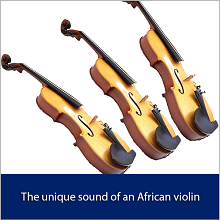 An African violin – made from wood indigenous to southern Africa – produces a high-quality, unique sound. The African violin was made from yellowwood (Podocarpus latifolius) and sapele (Entandrophragma cylindricum) – found to be the most suitable as tonewoods from several woods assessed by Meincken and colleagues. The sound quality was determined subjectively through performances to an audience and more objectively via spectral analysis of audio recordings. The analysis showed differences in the relative magnitude of the harmonics between the violin made from indigenous wood and a violin made with conventional wood species. Good quality violins are usually made from spruce and maple wood, which have to be imported to South Africa – often at high cost. However, the growth conditions of most southern African wood species make them suitable tonewoods.
An African violin – made from wood indigenous to southern Africa – produces a high-quality, unique sound. The African violin was made from yellowwood (Podocarpus latifolius) and sapele (Entandrophragma cylindricum) – found to be the most suitable as tonewoods from several woods assessed by Meincken and colleagues. The sound quality was determined subjectively through performances to an audience and more objectively via spectral analysis of audio recordings. The analysis showed differences in the relative magnitude of the harmonics between the violin made from indigenous wood and a violin made with conventional wood species. Good quality violins are usually made from spruce and maple wood, which have to be imported to South Africa – often at high cost. However, the growth conditions of most southern African wood species make them suitable tonewoods.
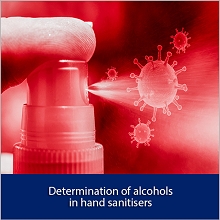 Alcohol-based hand sanitisers on the market and in public places that do not meet the alcohol content recommended by the World Health Organization (WHO), pose a great risk to consumers, as hand hygiene and disinfection remains one of the most (if not the only) effective measure for mitigating the spread of COVID-19 at this time. Yusuf analysed commercial, off-the-shelf and public hand sanitisers available in and around Pretoria (South Africa) to determine whether they contained enough alcohol to be efficacious virucides against SARS-CoV-2, as recommended by the WHO. Most of the products analysed were substandard, did not contain the recommended amount of alcohol and were not labelled correctly according to local and international standards. Only 42% of the products analysed contained at least 70% alcohol; of these only 28% met the WHO recommended 80±5% alcohol content to have a virucidal effect on SARS-CoV-2. Homemade products conformed to a greater degree to the WHO standards.
Alcohol-based hand sanitisers on the market and in public places that do not meet the alcohol content recommended by the World Health Organization (WHO), pose a great risk to consumers, as hand hygiene and disinfection remains one of the most (if not the only) effective measure for mitigating the spread of COVID-19 at this time. Yusuf analysed commercial, off-the-shelf and public hand sanitisers available in and around Pretoria (South Africa) to determine whether they contained enough alcohol to be efficacious virucides against SARS-CoV-2, as recommended by the WHO. Most of the products analysed were substandard, did not contain the recommended amount of alcohol and were not labelled correctly according to local and international standards. Only 42% of the products analysed contained at least 70% alcohol; of these only 28% met the WHO recommended 80±5% alcohol content to have a virucidal effect on SARS-CoV-2. Homemade products conformed to a greater degree to the WHO standards.
 The properties that make PET desirable for fluid-containing bottles have also made it highly resistant to environmental biodegradation, with reusable plastic bottles marketed as a solution to reduce the environmental impact of single-use plastic bottles. But are they really more environmentally friendly, if you consider the entire life cycle of the bottles? Yes – a reusable PET bottle has a lower life cycle impact, and extending the life of reusable bottles and designing lighter weight bottles would further reduce their life cycle impact. Olatayo and colleagues assessed the life cycle impact of single-use PET bottles and an alternative, reusable PET bottle based on consumption patterns in South Africa and the material flow and supply chain in the urban environment. In their examination of 13 impact categories, they found that using the reusable bottle had a lower impact than using single-use bottles in all the categories examined, including ecotoxicity, global warming and energy for production, use and disposal of the bottles.
The properties that make PET desirable for fluid-containing bottles have also made it highly resistant to environmental biodegradation, with reusable plastic bottles marketed as a solution to reduce the environmental impact of single-use plastic bottles. But are they really more environmentally friendly, if you consider the entire life cycle of the bottles? Yes – a reusable PET bottle has a lower life cycle impact, and extending the life of reusable bottles and designing lighter weight bottles would further reduce their life cycle impact. Olatayo and colleagues assessed the life cycle impact of single-use PET bottles and an alternative, reusable PET bottle based on consumption patterns in South Africa and the material flow and supply chain in the urban environment. In their examination of 13 impact categories, they found that using the reusable bottle had a lower impact than using single-use bottles in all the categories examined, including ecotoxicity, global warming and energy for production, use and disposal of the bottles.
 The need to eradicate the housing backlog in South Africa requires the government and the private sector to partner and promote effective and innovative ways of delivering housing. According to Mahachi, the nature of innovation and the benefits of 3D printing technologies in the complex government housing value chain opens opportunities for mass-scale customisation. 3D construction printing of houses has the potential to disrupt the way housing is delivered and may assist the South African government to deliver better quality houses, and much quicker, than traditional brick and mortar construction. Although 3D construction printing has not yet been explored in South Africa, this technology has been tried and tested internationally.
The need to eradicate the housing backlog in South Africa requires the government and the private sector to partner and promote effective and innovative ways of delivering housing. According to Mahachi, the nature of innovation and the benefits of 3D printing technologies in the complex government housing value chain opens opportunities for mass-scale customisation. 3D construction printing of houses has the potential to disrupt the way housing is delivered and may assist the South African government to deliver better quality houses, and much quicker, than traditional brick and mortar construction. Although 3D construction printing has not yet been explored in South Africa, this technology has been tried and tested internationally.
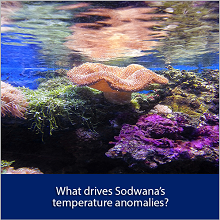 The Sodwana reef system experiences short-term temperature fluctuations that may provide relief from bleaching and be crucial in the future survival of the reef system. These temperature fluctuations occur over a period of days and cause a drop in temperature of a few degrees on the reef. Wells and colleagues analysed temperature measurements taken between 1994 and 2015 on Nine-Mile Reef at Sodwana and found that these temperature fluctuations occur about three times a year, mainly during summer. This finding suggests that they potentially provide relief from bleaching during periods of elevated temperatures in summer and potentially improve the coral’s resilience to bleaching. Corals become stressed when exposed to elevated temperatures for extended periods and expel their symbiotic algae, which is known as coral bleaching; severe bleaching may result in permanent reef damage and coral mortality from which the reef may not recover. Wells and colleagues found that 33% of the temperature anomalies at Sodwana were not associated with the presence of cyclonic eddy systems, which means that an offshore cyclonic eddy interacting with the shelf is not the sole driving mechanism of the temperature fluctuations. Future research can explore potential alternative drivers of the temperature anomalies, for example, wind-driven upwelling or upwelling due to waves breaking on the shelf.
The Sodwana reef system experiences short-term temperature fluctuations that may provide relief from bleaching and be crucial in the future survival of the reef system. These temperature fluctuations occur over a period of days and cause a drop in temperature of a few degrees on the reef. Wells and colleagues analysed temperature measurements taken between 1994 and 2015 on Nine-Mile Reef at Sodwana and found that these temperature fluctuations occur about three times a year, mainly during summer. This finding suggests that they potentially provide relief from bleaching during periods of elevated temperatures in summer and potentially improve the coral’s resilience to bleaching. Corals become stressed when exposed to elevated temperatures for extended periods and expel their symbiotic algae, which is known as coral bleaching; severe bleaching may result in permanent reef damage and coral mortality from which the reef may not recover. Wells and colleagues found that 33% of the temperature anomalies at Sodwana were not associated with the presence of cyclonic eddy systems, which means that an offshore cyclonic eddy interacting with the shelf is not the sole driving mechanism of the temperature fluctuations. Future research can explore potential alternative drivers of the temperature anomalies, for example, wind-driven upwelling or upwelling due to waves breaking on the shelf.
 The UN Decade of Ocean Science (2021–2030) has set research and technology priority areas to achieve the 2030 Sustainable Development Goals. Taljaard and Adams reviewed the current status of scientific support for coastal management in South Africa within the context of these priorities and found promising development. However, challenges for the next decade remain, such as rolling out developmental phases into sustainable, national-scale programmes, facilitating greater collaboration and coordination among role players, and achieving long-term commitment and political will for dedicated financial support for human and technological capacity development, both in the generation and dissemination of related scientific knowledge. Although Taljaard and Adams focused on the ecological system and its coupling with the social system, better characterisation and understanding of the dynamics within the social system are also critical. Ultimately, sustainable development within the coastal social-ecological system relies heavily on the willingness of the social system to embrace and execute related policies.
The UN Decade of Ocean Science (2021–2030) has set research and technology priority areas to achieve the 2030 Sustainable Development Goals. Taljaard and Adams reviewed the current status of scientific support for coastal management in South Africa within the context of these priorities and found promising development. However, challenges for the next decade remain, such as rolling out developmental phases into sustainable, national-scale programmes, facilitating greater collaboration and coordination among role players, and achieving long-term commitment and political will for dedicated financial support for human and technological capacity development, both in the generation and dissemination of related scientific knowledge. Although Taljaard and Adams focused on the ecological system and its coupling with the social system, better characterisation and understanding of the dynamics within the social system are also critical. Ultimately, sustainable development within the coastal social-ecological system relies heavily on the willingness of the social system to embrace and execute related policies.
 In a time of economic crisis brought about by COVID-19, purposefully uplifted home and community gardens can alleviate food insecurity in South Africa, according to Carstens and colleagues who assessed the potential of the establishment of home and community gardens to alleviate food insecurity. Home gardens mainly target the alleviation of malnutrition, with vegetables produced to augment cereal-based diets. Protection of social capital by institutional networks ensures durability and long-term success of campaigns to encourage home gardening. In a South African context, rainwater harvesting technology is immensely influential to the success of home gardens. The benefits of home gardening go beyond food security: home gardening can greatly benefit well-being and mental health as well as support plant genetic diversity, with well-managed gardens containing as many as 60 different vegetable plant species. Home gardens can mitigate urban heat island effects, regulate stormwater run-off and maintain soil carbon stocks and other aspects of soil quality. They also preserve indigenous knowledge and culture and present opportunities for education and community engagement.
In a time of economic crisis brought about by COVID-19, purposefully uplifted home and community gardens can alleviate food insecurity in South Africa, according to Carstens and colleagues who assessed the potential of the establishment of home and community gardens to alleviate food insecurity. Home gardens mainly target the alleviation of malnutrition, with vegetables produced to augment cereal-based diets. Protection of social capital by institutional networks ensures durability and long-term success of campaigns to encourage home gardening. In a South African context, rainwater harvesting technology is immensely influential to the success of home gardens. The benefits of home gardening go beyond food security: home gardening can greatly benefit well-being and mental health as well as support plant genetic diversity, with well-managed gardens containing as many as 60 different vegetable plant species. Home gardens can mitigate urban heat island effects, regulate stormwater run-off and maintain soil carbon stocks and other aspects of soil quality. They also preserve indigenous knowledge and culture and present opportunities for education and community engagement.
 Legislation and regulations are necessary to protect South Africa’s remarkable biodiversity and manage resource utilisation, but overly stringent legislation and regulations have unintended negative consequences on research and conservation. Alexander and colleagues relay how, over the last decade, new legislation, new interpretations of established legislation, and increasing administrative oversight have massively increased the administrative and compliance burden experienced by researchers in South Africa, especially those doing field-based research, which typically requires various permits, permissions, and authorisations for the collection, transport, storage and use of biological samples. The mandates of the country's natural science collections have also been impacted. Hamer and colleagues describe how the permitting requirements for the collection of plants and animals have become increasingly complex in the last 10 to 15 years, and that, for most biodiversity scientists, determining what permits are required is daunting. Hamer and colleagues assert that, while it is not reasonable to expect research or collection institution activities to be exempt from all permits, it is reasonable to expect that the permitting requirements and processes be transparent, accessible, responsive and rational. Alexander and colleagues provide recommendations to facilitate research without reducing the effectiveness of the legislation in the protection of South Africa’s natural resources and biodiversity.
Legislation and regulations are necessary to protect South Africa’s remarkable biodiversity and manage resource utilisation, but overly stringent legislation and regulations have unintended negative consequences on research and conservation. Alexander and colleagues relay how, over the last decade, new legislation, new interpretations of established legislation, and increasing administrative oversight have massively increased the administrative and compliance burden experienced by researchers in South Africa, especially those doing field-based research, which typically requires various permits, permissions, and authorisations for the collection, transport, storage and use of biological samples. The mandates of the country's natural science collections have also been impacted. Hamer and colleagues describe how the permitting requirements for the collection of plants and animals have become increasingly complex in the last 10 to 15 years, and that, for most biodiversity scientists, determining what permits are required is daunting. Hamer and colleagues assert that, while it is not reasonable to expect research or collection institution activities to be exempt from all permits, it is reasonable to expect that the permitting requirements and processes be transparent, accessible, responsive and rational. Alexander and colleagues provide recommendations to facilitate research without reducing the effectiveness of the legislation in the protection of South Africa’s natural resources and biodiversity.
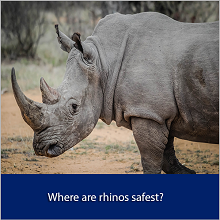 During 2020, South Africa reported 394 poached rhino carcasses – 34 at private properties and 360 at state properties. Rhinos occur in national parks managed by SANParks, reserves managed by provincial conservation authorities and non-state areas comprising private and communal ownership. Of these, the Kruger National Park has experienced the highest number of poaching losses reported for state land. The number of rhinos poached per population per unit area in Kruger is higher than that in other national parks (4.1 times) and non-state reserves (7.8 times). Size plays an important role: Kruger has an operational area the size of Israel (approximately 2 000 000 ha), compared with privately owned nature reserves containing rhinos in South Africa with a national average of 10 000 ha. Ferreira and Dziba highlight that responsible and balanced media reporting could facilitate lessons stakeholders can collectively learn by looking at, for instance, what makes non-state reserves, provincial reserves and small national parks more successful in managing the threat of poaching to rhino populations. Multiple approaches associated with rhinos can provide beneficial outcomes to support South Africa’s rhino conservation initiatives. It is not about who keeps rhinos safest, it is about the safest way to keep rhinos.
During 2020, South Africa reported 394 poached rhino carcasses – 34 at private properties and 360 at state properties. Rhinos occur in national parks managed by SANParks, reserves managed by provincial conservation authorities and non-state areas comprising private and communal ownership. Of these, the Kruger National Park has experienced the highest number of poaching losses reported for state land. The number of rhinos poached per population per unit area in Kruger is higher than that in other national parks (4.1 times) and non-state reserves (7.8 times). Size plays an important role: Kruger has an operational area the size of Israel (approximately 2 000 000 ha), compared with privately owned nature reserves containing rhinos in South Africa with a national average of 10 000 ha. Ferreira and Dziba highlight that responsible and balanced media reporting could facilitate lessons stakeholders can collectively learn by looking at, for instance, what makes non-state reserves, provincial reserves and small national parks more successful in managing the threat of poaching to rhino populations. Multiple approaches associated with rhinos can provide beneficial outcomes to support South Africa’s rhino conservation initiatives. It is not about who keeps rhinos safest, it is about the safest way to keep rhinos.
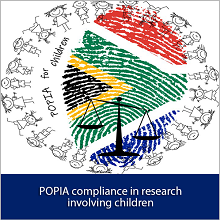 Compliance with South Africa’s Protection of Personal Information Act (POPIA) is a foremost governance challenge for research involving high-risk and vulnerable groups such as children and adolescents. It remains unclear what constitutes adequate safeguards to protect the personal information of the child under this new law. Hertzog and colleagues join the Discussions on POPIA series as a research group that generates evidence that influences social and health policy and programming for young people in sub-Saharan Africa. Their contribution draws on work adhering to multiple transnational governance frameworks imposed by national legislation such as data protection regulations, funders, and academic institutions. In their Commentary, they summarise seven essential instruments to achieve POPIA compliance in research projects involving children and adolescents .
Compliance with South Africa’s Protection of Personal Information Act (POPIA) is a foremost governance challenge for research involving high-risk and vulnerable groups such as children and adolescents. It remains unclear what constitutes adequate safeguards to protect the personal information of the child under this new law. Hertzog and colleagues join the Discussions on POPIA series as a research group that generates evidence that influences social and health policy and programming for young people in sub-Saharan Africa. Their contribution draws on work adhering to multiple transnational governance frameworks imposed by national legislation such as data protection regulations, funders, and academic institutions. In their Commentary, they summarise seven essential instruments to achieve POPIA compliance in research projects involving children and adolescents .
 Mollusc collections are among the oldest natural science collections in South Africa, dating from just before 1900. They provide an invaluable resource of morphological and genetic diversity, with associated spatial and temporal data. Cole collates available information about these diverse collections which are spread across the country in three comprehensive and seven smaller thematic collections, including one of the largest collections in the southern hemisphere and the most comprehensive collections of Cephalopoda (octopus, squid and relatives) and Polyplacophora (chitons) for southern Africa. Together these collections cater to a variety of the country’s identified research priorities. The Department of Science and Innovation is investing in collections as irreplaceable research infrastructure through the Natural Science Collections Facility. The Natural Science Collections Facility is developing an online Virtual Museum, with images of type specimens, specimen data and archival documents. A major stumbling block to long-term security and effective use of collections is the fragmentation of governance, and the inappropriate placement of the natural science collections under national and provincial departments of sports, arts and culture which have no mandate for the curation of biological collections. This could overturn the progress made over the past two decades to save and improve conditions for collections and taxonomic research. Consolidation of collections at larger institutions has been proposed.
Mollusc collections are among the oldest natural science collections in South Africa, dating from just before 1900. They provide an invaluable resource of morphological and genetic diversity, with associated spatial and temporal data. Cole collates available information about these diverse collections which are spread across the country in three comprehensive and seven smaller thematic collections, including one of the largest collections in the southern hemisphere and the most comprehensive collections of Cephalopoda (octopus, squid and relatives) and Polyplacophora (chitons) for southern Africa. Together these collections cater to a variety of the country’s identified research priorities. The Department of Science and Innovation is investing in collections as irreplaceable research infrastructure through the Natural Science Collections Facility. The Natural Science Collections Facility is developing an online Virtual Museum, with images of type specimens, specimen data and archival documents. A major stumbling block to long-term security and effective use of collections is the fragmentation of governance, and the inappropriate placement of the natural science collections under national and provincial departments of sports, arts and culture which have no mandate for the curation of biological collections. This could overturn the progress made over the past two decades to save and improve conditions for collections and taxonomic research. Consolidation of collections at larger institutions has been proposed.
 The increasing concern surrounding plastic pollution has placed a spotlight on key items, forcing plastic value-chain actors to respond. But are their responses motivated by a true desire for environmentalism or are these actors engaging in greenwashing? Greenwashing is misleading of consumers on the environmental benefits associated with a company’s products, processes or practices. In this case study on plastic straws undertaken by Chitaka, the brand owners and retailers interviewed were driven by a desire to meet consumer expectations. This desire led to the substitution of plastic straws with glass, paper and polylactide alternatives. However, the broader environmental implications of the alternatives were rarely considered. This single-minded focus on marine pollution has the potential to result in inadvertent greenwashing as alternative products may result in more harm in other environmental compartments.
The increasing concern surrounding plastic pollution has placed a spotlight on key items, forcing plastic value-chain actors to respond. But are their responses motivated by a true desire for environmentalism or are these actors engaging in greenwashing? Greenwashing is misleading of consumers on the environmental benefits associated with a company’s products, processes or practices. In this case study on plastic straws undertaken by Chitaka, the brand owners and retailers interviewed were driven by a desire to meet consumer expectations. This desire led to the substitution of plastic straws with glass, paper and polylactide alternatives. However, the broader environmental implications of the alternatives were rarely considered. This single-minded focus on marine pollution has the potential to result in inadvertent greenwashing as alternative products may result in more harm in other environmental compartments.
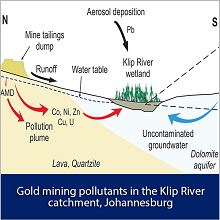 Waste from gold mines is considered to constitute the largest single source of waste pollution in South Africa and contributes significantly to acid mine drainage, which remains one of the country’s most serious environmental and socio-economic issues. Analyses by Chetty and colleagues, of metal pollutants in the upper Klip River catchment in Johannesburg, revealed that the majority of pollutants were associated with contaminant plumes that emanated from mine dumps and entered the Klip River wetland via groundwater recharge. Extensive accumulation of metals within the Klip River wetland reflects the contaminant legacy associated with gold mining on the Witwatersrand and highlights the vital role this natural system has played in trapping vast quantities of toxic pollutants and remediating downstream waters. Contaminant plumes associated with mine dumps will likely persist for decades; preventing further deterioration of the Klip River wetlands is thus critical for safeguarding water sources in the region.
Waste from gold mines is considered to constitute the largest single source of waste pollution in South Africa and contributes significantly to acid mine drainage, which remains one of the country’s most serious environmental and socio-economic issues. Analyses by Chetty and colleagues, of metal pollutants in the upper Klip River catchment in Johannesburg, revealed that the majority of pollutants were associated with contaminant plumes that emanated from mine dumps and entered the Klip River wetland via groundwater recharge. Extensive accumulation of metals within the Klip River wetland reflects the contaminant legacy associated with gold mining on the Witwatersrand and highlights the vital role this natural system has played in trapping vast quantities of toxic pollutants and remediating downstream waters. Contaminant plumes associated with mine dumps will likely persist for decades; preventing further deterioration of the Klip River wetlands is thus critical for safeguarding water sources in the region.
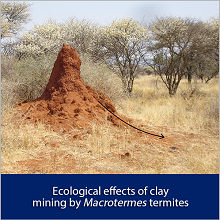 The mounds of Macrotermes termites in sandy soils usually have a greater clay content than the surrounding topsoils. The origin of the clay is unknown, but could be from the termites mining clay from the topsoil, subsoil or from tens of metres into the regolith. There are a range of potentially positive ecological effects of this clay mining by the termites, but also a potentially negative effect of increased clay content in sandy topsoils – which is an increased tendency of the surface layer of the soil to seal during rain events, and to reduce infiltration of rainwater as a result. Mills and Medinski investigated the likelihood of this potentially negative effect. As expected, they found that the mean clay content of mound samples was considerably greater than that of topsoils, but surprisingly, this greater clay content did not result in reduced infiltrability. Mills and Medinski attribute this finding to the greater electrical conductivity, pH and exchangeable sodium percentage of the mound samples compared with the topsoil. These chemical changes in the soil would be expected to reduce the dispersibility of the clay and consequently reduce the tendency of the soil to seal.
The mounds of Macrotermes termites in sandy soils usually have a greater clay content than the surrounding topsoils. The origin of the clay is unknown, but could be from the termites mining clay from the topsoil, subsoil or from tens of metres into the regolith. There are a range of potentially positive ecological effects of this clay mining by the termites, but also a potentially negative effect of increased clay content in sandy topsoils – which is an increased tendency of the surface layer of the soil to seal during rain events, and to reduce infiltration of rainwater as a result. Mills and Medinski investigated the likelihood of this potentially negative effect. As expected, they found that the mean clay content of mound samples was considerably greater than that of topsoils, but surprisingly, this greater clay content did not result in reduced infiltrability. Mills and Medinski attribute this finding to the greater electrical conductivity, pH and exchangeable sodium percentage of the mound samples compared with the topsoil. These chemical changes in the soil would be expected to reduce the dispersibility of the clay and consequently reduce the tendency of the soil to seal.
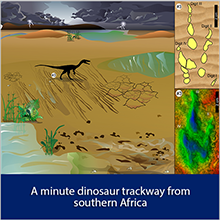 A newly discovered Early Jurassic theropod trackway near Storm Shelter in the Eastern Cape in South Africa contains not only the smallest tracks in the Clarens Formation, but also the most elongated dinosaur footprints in southern Africa to date. The tracks show that the small bipedal trackmaker dashed across the wet sediment surface at an estimated running speed of ~12.5 km per hour. During the dash, either as a predator or as a prey, the trackmaker’s small feet sunk hallux-deep into the sediment. Bordy documents this newly discovered Early Jurassic trackway of very small, functionally tridactyl tracks and presents the footprint dimensions, locomotor parameters (step length, stride, speed), and body size estimates of the trackmaker. Based on the track morphometrics and the regional dinosaur skeletal record, the trackmaker is attributed to Megapnosaurus rhodesiensis – a small-to-medium-sized, early theropod common in southern Africa in the Jurassic.
A newly discovered Early Jurassic theropod trackway near Storm Shelter in the Eastern Cape in South Africa contains not only the smallest tracks in the Clarens Formation, but also the most elongated dinosaur footprints in southern Africa to date. The tracks show that the small bipedal trackmaker dashed across the wet sediment surface at an estimated running speed of ~12.5 km per hour. During the dash, either as a predator or as a prey, the trackmaker’s small feet sunk hallux-deep into the sediment. Bordy documents this newly discovered Early Jurassic trackway of very small, functionally tridactyl tracks and presents the footprint dimensions, locomotor parameters (step length, stride, speed), and body size estimates of the trackmaker. Based on the track morphometrics and the regional dinosaur skeletal record, the trackmaker is attributed to Megapnosaurus rhodesiensis – a small-to-medium-sized, early theropod common in southern Africa in the Jurassic.
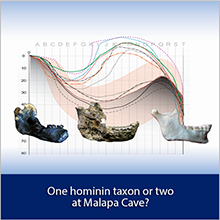 Rak and colleagues argue that the skeletons of two individuals from the Malapa Cave site in South Africa that were attributed to a new hominin species, Australopithecus sediba, actually represent two separate genera: Australopithecus and Homo. These genera are known to have jointly occupied sites, as seen in several early South African caves, so it is possible that Malapa also contains remains of both taxa. Rak et al.'s analysis of the specimens’ mandibles indicates that Australopithecus sediba is not a ‘Homo-like australopith’ – a transitional species between Australopithecus africanus and Homo. Their results also indicate that all the Australopithecus species on which the relevant mandibular anatomy is preserved are too specialised to constitute an evolutionary ancestor of Homo sapiens.
Rak and colleagues argue that the skeletons of two individuals from the Malapa Cave site in South Africa that were attributed to a new hominin species, Australopithecus sediba, actually represent two separate genera: Australopithecus and Homo. These genera are known to have jointly occupied sites, as seen in several early South African caves, so it is possible that Malapa also contains remains of both taxa. Rak et al.'s analysis of the specimens’ mandibles indicates that Australopithecus sediba is not a ‘Homo-like australopith’ – a transitional species between Australopithecus africanus and Homo. Their results also indicate that all the Australopithecus species on which the relevant mandibular anatomy is preserved are too specialised to constitute an evolutionary ancestor of Homo sapiens.
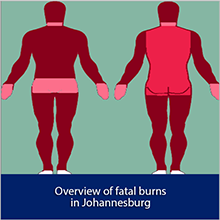 Thermal and electrical burn injuries affect millions of people globally each year and South Africa is a developing country in which fatal fires are common. Keyes and Liphoko reviewed 185 case files of fatal burns received at the Johannesburg Forensic Pathology Services Medico-Legal Laboratory from 2010 to 2014. Those most at risk of fatal burns are black individuals, male individuals, and individuals 30–39 years old. Thermal burns, as a result of flames, are the most common type of burn and are prevalent in the winter months, most notably in August. Electrical burns are relatively rare. Burn wounds are most common to the head, chest, back, and abdomen. Johannesburg has a lower burn mortality rate than Cape Town, Pretoria and Mpumalanga.
Thermal and electrical burn injuries affect millions of people globally each year and South Africa is a developing country in which fatal fires are common. Keyes and Liphoko reviewed 185 case files of fatal burns received at the Johannesburg Forensic Pathology Services Medico-Legal Laboratory from 2010 to 2014. Those most at risk of fatal burns are black individuals, male individuals, and individuals 30–39 years old. Thermal burns, as a result of flames, are the most common type of burn and are prevalent in the winter months, most notably in August. Electrical burns are relatively rare. Burn wounds are most common to the head, chest, back, and abdomen. Johannesburg has a lower burn mortality rate than Cape Town, Pretoria and Mpumalanga.
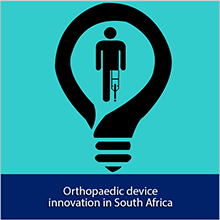 About 90% of all medical devices in South Africa are imported. As medical devices have a key role to play in addressing South Africa’s burden of disease, innovation in this area is vital. Salie and colleagues assessed knowledge development and exchange among actors who patent orthopaedic devices in South Africa over the period 2000–2015 as an indication of innovation activity. Their results show that university, healthcare and industry organisations have primarily been responsible for increased patenting over time. National universities were found to make a small contribution, and science councils were found to be absent, despite the efforts in the changing innovation landscape to encourage publicly financed research organisations to protect their intellectual property. The collaboration networks were found to be sparse and disjointed, with many actors – mostly clinicians from the private healthcare sector – patenting in isolation.
About 90% of all medical devices in South Africa are imported. As medical devices have a key role to play in addressing South Africa’s burden of disease, innovation in this area is vital. Salie and colleagues assessed knowledge development and exchange among actors who patent orthopaedic devices in South Africa over the period 2000–2015 as an indication of innovation activity. Their results show that university, healthcare and industry organisations have primarily been responsible for increased patenting over time. National universities were found to make a small contribution, and science councils were found to be absent, despite the efforts in the changing innovation landscape to encourage publicly financed research organisations to protect their intellectual property. The collaboration networks were found to be sparse and disjointed, with many actors – mostly clinicians from the private healthcare sector – patenting in isolation.
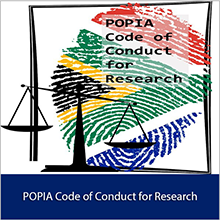 Compliance with the Protection of Personal Information Act No. 4 of 2013 (POPIA) will be mandatory for all sectors in South Africa from 1 July 2021. To promote understanding and compliance with POPIA within the research community in South Africa, a Code of Conduct for Research is being developed through a transparent and consultative process led by the Academy of Science of South Africa (ASSAf). The Commentary by Adams and colleagues describes the purpose and process of the Code of Conduct for Research which, it is envisaged, will be submitted by ASSAf to the Information Regulator by early June 2021. The proposed Code will pertain to all research conducted in South Africa which uses personal information as defined under POPIA as part of the research process. The full scope of the Code of Conduct is set out in the Discussion Document by Adams et al.
Compliance with the Protection of Personal Information Act No. 4 of 2013 (POPIA) will be mandatory for all sectors in South Africa from 1 July 2021. To promote understanding and compliance with POPIA within the research community in South Africa, a Code of Conduct for Research is being developed through a transparent and consultative process led by the Academy of Science of South Africa (ASSAf). The Commentary by Adams and colleagues describes the purpose and process of the Code of Conduct for Research which, it is envisaged, will be submitted by ASSAf to the Information Regulator by early June 2021. The proposed Code will pertain to all research conducted in South Africa which uses personal information as defined under POPIA as part of the research process. The full scope of the Code of Conduct is set out in the Discussion Document by Adams et al.
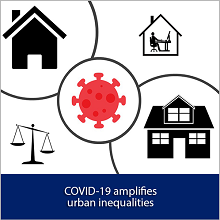 Poor communities have borne more of the burden of the lockdown than have suburban communities in South Africa, according to original evidence presented by Turok and colleagues. Blanket national measures have not been sensitive to these variations, with the unintended consequence of amplifying inequalities. National programmes need complementary efforts to boost jobs and livelihoods in and around vulnerable communities. This means targeting particular kinds of places as well as specific groups of people in tackling poverty. Treating unequal places in the same way will not narrow the gap between them. Turok et al.’s evidence comes from Waves 1 and 2 of the ongoing National Income Dynamics Study: Coronavirus Rapid Mobile Survey (NIDS-CRAM). The NIDS-CRAM was designed as a ‘barometer’ to assess the socio-economic impact of COVID-19. Suburbs started out in February 2020 in a much stronger position, with 58% of adults in paid employment, compared with 51% in the townships, 45% in peri-urban areas and 59% among shack dwellers. After Level 5 lockdown was imposed, suburbs lost one in seven jobs (14%) by April 2020, compared with one in four in the townships (24%) and peri-urban areas (23%) and more than a third of jobs (36%) in shack areas. More than half of peri-urban respondents (54%) lived in households that received social grants in June 2020, compared with less than half of township residents (45%), two in five shack dwellers (40%) and one in four suburban residents (26%). In terms of special relief from the crisis, less than one in three peri-urban residents (29%) said that someone in their household had received the COVID-19 grant, compared with 27% in townships, 18% of shack dwellers and 16% in suburban areas. These differences are smaller than for other grants, suggesting that the COVID-19 grant has benefitted people who did not qualify for government support before, such as unemployed men. The proportion of respondents who said their household had run out of money to buy food in April 2020 was 31% in the suburbs, 48% in the townships and 61% in the shack areas. By June 2020, these proportions had come down to 24% in the suburbs, 40% in the townships and 50% in the shack areas. The proportion of respondents who said that someone in their household had gone hungry in the last seven days (in May/June 2020) was 11% in the suburbs, 22% in the townships and 32% in the shack areas. By July/August 2020, these proportions had come down to 7% in the suburbs, 16% in the townships and 22% in the shack areas. Government grants have clearly helped to protect livelihoods in poor communities and compensate for high unemployment rates. However, there is a corresponding risk to living standards if the temporary relief is withdrawn before the labour market has recovered. Such a scenario would aggravate human suffering and misery.
Poor communities have borne more of the burden of the lockdown than have suburban communities in South Africa, according to original evidence presented by Turok and colleagues. Blanket national measures have not been sensitive to these variations, with the unintended consequence of amplifying inequalities. National programmes need complementary efforts to boost jobs and livelihoods in and around vulnerable communities. This means targeting particular kinds of places as well as specific groups of people in tackling poverty. Treating unequal places in the same way will not narrow the gap between them. Turok et al.’s evidence comes from Waves 1 and 2 of the ongoing National Income Dynamics Study: Coronavirus Rapid Mobile Survey (NIDS-CRAM). The NIDS-CRAM was designed as a ‘barometer’ to assess the socio-economic impact of COVID-19. Suburbs started out in February 2020 in a much stronger position, with 58% of adults in paid employment, compared with 51% in the townships, 45% in peri-urban areas and 59% among shack dwellers. After Level 5 lockdown was imposed, suburbs lost one in seven jobs (14%) by April 2020, compared with one in four in the townships (24%) and peri-urban areas (23%) and more than a third of jobs (36%) in shack areas. More than half of peri-urban respondents (54%) lived in households that received social grants in June 2020, compared with less than half of township residents (45%), two in five shack dwellers (40%) and one in four suburban residents (26%). In terms of special relief from the crisis, less than one in three peri-urban residents (29%) said that someone in their household had received the COVID-19 grant, compared with 27% in townships, 18% of shack dwellers and 16% in suburban areas. These differences are smaller than for other grants, suggesting that the COVID-19 grant has benefitted people who did not qualify for government support before, such as unemployed men. The proportion of respondents who said their household had run out of money to buy food in April 2020 was 31% in the suburbs, 48% in the townships and 61% in the shack areas. By June 2020, these proportions had come down to 24% in the suburbs, 40% in the townships and 50% in the shack areas. The proportion of respondents who said that someone in their household had gone hungry in the last seven days (in May/June 2020) was 11% in the suburbs, 22% in the townships and 32% in the shack areas. By July/August 2020, these proportions had come down to 7% in the suburbs, 16% in the townships and 22% in the shack areas. Government grants have clearly helped to protect livelihoods in poor communities and compensate for high unemployment rates. However, there is a corresponding risk to living standards if the temporary relief is withdrawn before the labour market has recovered. Such a scenario would aggravate human suffering and misery.
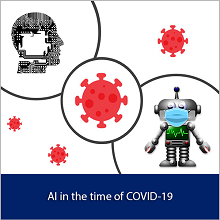 The global challenges posed by COVID-19 are immense and undeniable. Yet the concurrent acceleration of 4IR technologies has not only afforded an important tool for diagnosis and prevention of illness – not to mention providing ways to stay connected – it has also created opportunities for further applications. Ntombi Mathe reports on a webinar titled ‘Unlocking COVID-19 current realities, future opportunities: Artificial intelligence in the time of COVID-19’ which addressed the impacts of AI on our lives and society as a whole, the regulation thereof, and how we can use AI to create a better normal and address societal needs in a more equitable manner.
The global challenges posed by COVID-19 are immense and undeniable. Yet the concurrent acceleration of 4IR technologies has not only afforded an important tool for diagnosis and prevention of illness – not to mention providing ways to stay connected – it has also created opportunities for further applications. Ntombi Mathe reports on a webinar titled ‘Unlocking COVID-19 current realities, future opportunities: Artificial intelligence in the time of COVID-19’ which addressed the impacts of AI on our lives and society as a whole, the regulation thereof, and how we can use AI to create a better normal and address societal needs in a more equitable manner.
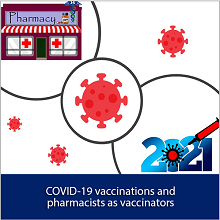 With a population of over 59 million, South Africa will need a suitably sized workforce to meet the demand of the COVID-19 vaccine roll-out. Currently in South Africa, those healthcare professionals allowed to vaccinate are doctors and nurses. According to Velisha Perumal-Pillay, South Africa should expand this workforce to include pharmacists, to be able to meet the immediate demand for vaccinators. Pharmacists in countries such as the USA, UK and Australia, have been providing vaccination services for years. The International Pharmaceutical Federation strongly promotes pharmacists as vaccinators and is advocating for countries to update their regulations. The benefit of pharmacists as vaccinators in South Africa would not only be immediate to meet demand for COVID-19 vaccination and lessen the burden on other healthcare professionals, but also long term through continuation of current immunisation services to sustain and maybe even improve vaccination coverage, which currently is poor.
With a population of over 59 million, South Africa will need a suitably sized workforce to meet the demand of the COVID-19 vaccine roll-out. Currently in South Africa, those healthcare professionals allowed to vaccinate are doctors and nurses. According to Velisha Perumal-Pillay, South Africa should expand this workforce to include pharmacists, to be able to meet the immediate demand for vaccinators. Pharmacists in countries such as the USA, UK and Australia, have been providing vaccination services for years. The International Pharmaceutical Federation strongly promotes pharmacists as vaccinators and is advocating for countries to update their regulations. The benefit of pharmacists as vaccinators in South Africa would not only be immediate to meet demand for COVID-19 vaccination and lessen the burden on other healthcare professionals, but also long term through continuation of current immunisation services to sustain and maybe even improve vaccination coverage, which currently is poor.
 The impacts experienced during recent severe weather events in southern Africa show that more needs to be done to increase weather awareness, and build disaster risk management systems, including disaster preparedness and risk reduction. Weather affects our daily lives from what we wear and our electricity consumption to the traffic we experience. Severe weather can cause damage to property, injuries and even death. Detailed and accurate weather forecasts that are issued and communicated timeously, and actioned upon, can reduce the impact of severe weather events. The South African Weather Service (SAWS) is responsible for providing forecasts nationally as well as regionally within the Southern African Development Community (SADC). Bopape and colleagues evaluated SAWS weather information using near real-time observations and models on the nowcasting to short-range forecasting timescales during two severe weather events: Idai tropical cyclone in March 2019 which impacted Mozambique, Zimbabwe and Malawi resulting in over 1000 deaths, and the floods over the KwaZulu-Natal (KZN) Province in April 2019 that caused over 70 deaths. Their results show that weather models gave an indication of these systems in advance, with warnings issued at least 2 days in advance in the case of Idai and 1 day in advance for the KZN floods. Nowcasting systems were also in place for detailed warnings to be provided as events progressed. They also found shortcomings in model simulations, in particular on locating the KZN flood event properly and over/underestimation of the event. Despite advanced warnings, the impacts experienced during the two events indicate that more needs to be done to increase weather awareness, and build disaster risk management systems, including disaster preparedness and risk reduction.
The impacts experienced during recent severe weather events in southern Africa show that more needs to be done to increase weather awareness, and build disaster risk management systems, including disaster preparedness and risk reduction. Weather affects our daily lives from what we wear and our electricity consumption to the traffic we experience. Severe weather can cause damage to property, injuries and even death. Detailed and accurate weather forecasts that are issued and communicated timeously, and actioned upon, can reduce the impact of severe weather events. The South African Weather Service (SAWS) is responsible for providing forecasts nationally as well as regionally within the Southern African Development Community (SADC). Bopape and colleagues evaluated SAWS weather information using near real-time observations and models on the nowcasting to short-range forecasting timescales during two severe weather events: Idai tropical cyclone in March 2019 which impacted Mozambique, Zimbabwe and Malawi resulting in over 1000 deaths, and the floods over the KwaZulu-Natal (KZN) Province in April 2019 that caused over 70 deaths. Their results show that weather models gave an indication of these systems in advance, with warnings issued at least 2 days in advance in the case of Idai and 1 day in advance for the KZN floods. Nowcasting systems were also in place for detailed warnings to be provided as events progressed. They also found shortcomings in model simulations, in particular on locating the KZN flood event properly and over/underestimation of the event. Despite advanced warnings, the impacts experienced during the two events indicate that more needs to be done to increase weather awareness, and build disaster risk management systems, including disaster preparedness and risk reduction.
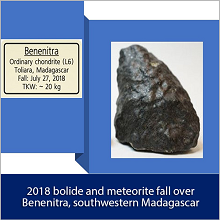 During the early evening of 27 July 2018, residents in various towns and farming settlements in southwestern Madagascar observed a rapidly moving bright light in the sky for a few seconds before it exploded into multiple smaller glowing fragments with smoke trails that descended more steeply before extinguishing. Using eyewitness reports, infrasound records, seismograph records and cosmogenic radionuclide analysis, Gibson and colleagues confirm that this event was a meteorite fall. Despite multiple stones falling in and around the town of Benenitra, no damage or injuries were reported. Petrographic and geochemical analyses of recovered stones confirm that the meteorite is an L6 ordinary chondrite. Recovery of meteorite falls is rare; this is Madagascar’s second known meteorite fall and the first that can be linked to a bolide – a bright fireball caused by the penetration of Earth’s upper atmosphere by a meteoroid travelling at hypersonic speed (>11 km/s). The bolide released an estimated 2.038 kt equivalent of energy on its transit through the upper atmosphere and final terminal burst, sufficient to be recorded by the infrasound station 542 km north-northeast of Benenitra, and by the seismograph station 77 km to the north-northwest. The reported recovered mass of stones of ~22 kg is likely to represent a small fraction of the total mass of the fall.
During the early evening of 27 July 2018, residents in various towns and farming settlements in southwestern Madagascar observed a rapidly moving bright light in the sky for a few seconds before it exploded into multiple smaller glowing fragments with smoke trails that descended more steeply before extinguishing. Using eyewitness reports, infrasound records, seismograph records and cosmogenic radionuclide analysis, Gibson and colleagues confirm that this event was a meteorite fall. Despite multiple stones falling in and around the town of Benenitra, no damage or injuries were reported. Petrographic and geochemical analyses of recovered stones confirm that the meteorite is an L6 ordinary chondrite. Recovery of meteorite falls is rare; this is Madagascar’s second known meteorite fall and the first that can be linked to a bolide – a bright fireball caused by the penetration of Earth’s upper atmosphere by a meteoroid travelling at hypersonic speed (>11 km/s). The bolide released an estimated 2.038 kt equivalent of energy on its transit through the upper atmosphere and final terminal burst, sufficient to be recorded by the infrasound station 542 km north-northeast of Benenitra, and by the seismograph station 77 km to the north-northwest. The reported recovered mass of stones of ~22 kg is likely to represent a small fraction of the total mass of the fall.
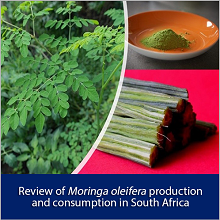 Moringa (Moringa oleifera) – a perennial, drought-tolerant and resilient crop that can survive a wide range of environmental and climatic conditions – may well be the key to malnutrition and poverty alleviation as well as climate change mitigation for marginal communities in South Africa. Considering the predicted climatic changes which are likely to have adverse consequences for farming, moringa could serve as a feasible alternative crop for rural inhabitants. Moringa is well known globally for its multitude of uses, including nutrition, medicine, livestock feed, plant growth enhancer, cosmetics, water purification and biofuel production. Almost all its parts contain nutrients such as proteins, carbohydrates, vitamins and minerals. Mashamaite and colleagues reviewed work done on moringa within a South African context. Since moringa, which is native to northern India, was introduced to rural communities in the Limpopo Province as a cultivated crop in 2006, national interest in the tree has grown, with the South African government, farmers and higher education institutions initiating moringa-oriented projects. A variety of foodstuffs is currently available: moringa spice, mahewu, tea leaves, ice tea, peanut butter, energy drinks and yoghurts. Moringa is now grown in six of South Africa’s nine provinces, although studies show that it could be grown in all nine provinces.
Moringa (Moringa oleifera) – a perennial, drought-tolerant and resilient crop that can survive a wide range of environmental and climatic conditions – may well be the key to malnutrition and poverty alleviation as well as climate change mitigation for marginal communities in South Africa. Considering the predicted climatic changes which are likely to have adverse consequences for farming, moringa could serve as a feasible alternative crop for rural inhabitants. Moringa is well known globally for its multitude of uses, including nutrition, medicine, livestock feed, plant growth enhancer, cosmetics, water purification and biofuel production. Almost all its parts contain nutrients such as proteins, carbohydrates, vitamins and minerals. Mashamaite and colleagues reviewed work done on moringa within a South African context. Since moringa, which is native to northern India, was introduced to rural communities in the Limpopo Province as a cultivated crop in 2006, national interest in the tree has grown, with the South African government, farmers and higher education institutions initiating moringa-oriented projects. A variety of foodstuffs is currently available: moringa spice, mahewu, tea leaves, ice tea, peanut butter, energy drinks and yoghurts. Moringa is now grown in six of South Africa’s nine provinces, although studies show that it could be grown in all nine provinces.
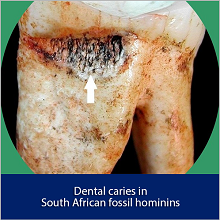 Caries (or dental decay) has been present throughout human evolution, with fossil hominins from South Africa affected by this disease. Once considered rare in fossil hominins, caries has recently been reported in several hominin species. Towle and colleagues analysed fossil tooth specimens of Homo, Homo naledi, Australopithecus sediba, Australopithecus africanus and Paranthropus robustus for caries prevalence and location. They found caries rates of 1–5% of teeth affected – similar to rates of pre-agricultural human groups. The South African fossil hominins display lesions on their posterior teeth, suggesting sugary foods were consumed. Caries tends also to be more common in the posterior teeth in modern humans. Differences in prevalence and position of caries can provide insight into dietary aspects of past populations.
Caries (or dental decay) has been present throughout human evolution, with fossil hominins from South Africa affected by this disease. Once considered rare in fossil hominins, caries has recently been reported in several hominin species. Towle and colleagues analysed fossil tooth specimens of Homo, Homo naledi, Australopithecus sediba, Australopithecus africanus and Paranthropus robustus for caries prevalence and location. They found caries rates of 1–5% of teeth affected – similar to rates of pre-agricultural human groups. The South African fossil hominins display lesions on their posterior teeth, suggesting sugary foods were consumed. Caries tends also to be more common in the posterior teeth in modern humans. Differences in prevalence and position of caries can provide insight into dietary aspects of past populations.
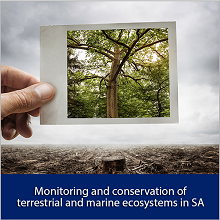
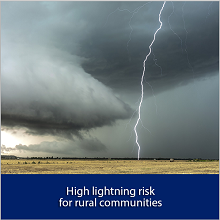 South Africa has one of the highest incidences of lightning-related injuries and deaths. People residing in South Africa’s rural areas are often outdoors due to work activities such as subsistence farming and livestock herding and, as such, are the most prone to facing lightning-related risks. Despite South Africa having one of only three ground-based lightning detection networks in the southern hemisphere, there is no dissemination of alerts at a local level and rural communities remain vulnerable to lightning – the occurrence of which is predicted to increase with climate change. Rural areas also lack lightning-safe shelters and have fewer fully enclosed metal-topped vehicles. Mahomed et al. recommend investigation of the most effective way to utilise existing monitoring networks to alert rural communities in a timeous and comprehensible manner in languages that are understood within the communities and of design guidelines for lightning-safe rural dwellings.
South Africa has one of the highest incidences of lightning-related injuries and deaths. People residing in South Africa’s rural areas are often outdoors due to work activities such as subsistence farming and livestock herding and, as such, are the most prone to facing lightning-related risks. Despite South Africa having one of only three ground-based lightning detection networks in the southern hemisphere, there is no dissemination of alerts at a local level and rural communities remain vulnerable to lightning – the occurrence of which is predicted to increase with climate change. Rural areas also lack lightning-safe shelters and have fewer fully enclosed metal-topped vehicles. Mahomed et al. recommend investigation of the most effective way to utilise existing monitoring networks to alert rural communities in a timeous and comprehensible manner in languages that are understood within the communities and of design guidelines for lightning-safe rural dwellings.
 What is the optimal offer that a bank could make to a home loan client to ensure that the bank meets the maximum profitability threshold while still taking risk into account? Verster et al. present a case study – using real data from a South African bank – to predict take-up rate of home loans using various modelling techniques. Banks could use these models to positively influence their market share and profitability as take-up rate is one of the first factors that needs to be understood to answer the question posed. Unsurprisingly, Verster et al. found that the higher the interest rate offered, the lower the take-up rate, and that the higher the loan-to-value ratio offered, the higher the take-up rate, with bank customers being less sensitive to the loan-to-value ratio than to interest rate. Image: Nick Youngson (CC BY-SA 3.0)
What is the optimal offer that a bank could make to a home loan client to ensure that the bank meets the maximum profitability threshold while still taking risk into account? Verster et al. present a case study – using real data from a South African bank – to predict take-up rate of home loans using various modelling techniques. Banks could use these models to positively influence their market share and profitability as take-up rate is one of the first factors that needs to be understood to answer the question posed. Unsurprisingly, Verster et al. found that the higher the interest rate offered, the lower the take-up rate, and that the higher the loan-to-value ratio offered, the higher the take-up rate, with bank customers being less sensitive to the loan-to-value ratio than to interest rate. Image: Nick Youngson (CC BY-SA 3.0)
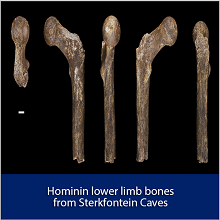 Ron Clarke, the discoverer of ‘Little Foot’ – a hominin skeleton from Sterkfontein Caves in South Africa – classified the skeleton on the basis of its unique skull morphology as Australopithecus prometheus, a species distinct from the better-known and co-occurring Australopithecus africanus. Clarke and colleagues now describe late Pliocene and early Pleistocene hominin lower limb fossils from Sterkfontein Caves, including two femoral specimens, a partial tibia and a partial fibula. The fossils are likely assignable to A. africanus and/or A. prometheus and the morphology of each corroborates previous interpretations of Sterkfontein hominins as at least facultative bipeds. When considered in a comparative context, they support the hypothesis that there was significant (probably interspecific) variation in South African hominin postcranial morphology during the late Pliocene and early Pleistocene. Caption: StW 598, a hominin left proximal femur from Sterkfontein Caves, shown in (left to right) superior, anterior, medial, posterior and lateral views (bar scale = 1 cm) (image: Pickering et al.).
Ron Clarke, the discoverer of ‘Little Foot’ – a hominin skeleton from Sterkfontein Caves in South Africa – classified the skeleton on the basis of its unique skull morphology as Australopithecus prometheus, a species distinct from the better-known and co-occurring Australopithecus africanus. Clarke and colleagues now describe late Pliocene and early Pleistocene hominin lower limb fossils from Sterkfontein Caves, including two femoral specimens, a partial tibia and a partial fibula. The fossils are likely assignable to A. africanus and/or A. prometheus and the morphology of each corroborates previous interpretations of Sterkfontein hominins as at least facultative bipeds. When considered in a comparative context, they support the hypothesis that there was significant (probably interspecific) variation in South African hominin postcranial morphology during the late Pliocene and early Pleistocene. Caption: StW 598, a hominin left proximal femur from Sterkfontein Caves, shown in (left to right) superior, anterior, medial, posterior and lateral views (bar scale = 1 cm) (image: Pickering et al.).
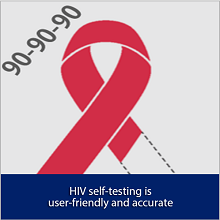 Despite significant progress made towards improving HIV testing rates in South Africa using the conventional, facility-based approach, it has been insufficient to reach the UNAIDS and World Health Organization’s (WHO) 90–90–90 goal of testing by 2020. HIV self-tests are a user-friendly and accurate testing approach to reach populations that may not have access or seek access to traditional clinic-based testing. The National Department of Health in South Africa requires HIV self-tests to be approved by the South African Health Products Regulatory Authority or be prequalified by the WHO. Majam et al. assessed four HIV self-testing devices that were not prequalified at the time. The average usability index (97.1%), sensitivity (98.2%) and specificity (99.8%) were all very high, suggesting that these HIV self-tests are appropriate for WHO prequalification, and subsequently, the South African market.
Despite significant progress made towards improving HIV testing rates in South Africa using the conventional, facility-based approach, it has been insufficient to reach the UNAIDS and World Health Organization’s (WHO) 90–90–90 goal of testing by 2020. HIV self-tests are a user-friendly and accurate testing approach to reach populations that may not have access or seek access to traditional clinic-based testing. The National Department of Health in South Africa requires HIV self-tests to be approved by the South African Health Products Regulatory Authority or be prequalified by the WHO. Majam et al. assessed four HIV self-testing devices that were not prequalified at the time. The average usability index (97.1%), sensitivity (98.2%) and specificity (99.8%) were all very high, suggesting that these HIV self-tests are appropriate for WHO prequalification, and subsequently, the South African market.
When plants get sick
Most everyone is now accustomed to wearing a face mask, sanitising their hands, and quarantining when travelling to help prevent the spread of the virus that causes COVID-19. But few of us are aware of the International Phytosanitary Measures of the International Plant Protection Convention that are in place to protect the world’s plant resources from pests and diseases. Because plants get sick too. And, like diseases that affect humans, the incidence of plants affected by pests and diseases is increasing with the expansion of global trade and travel and climate change.

And when plants get sick, it affects our health, and the health of other animals and the ecosystem in general. Plants are the source of the oxygen we breathe and the food we eat, and various other products such as medicines, shelter and wood for fuel. Pests and diseases of plants are responsible for losses of 20–40% of global food production, and trade losses of more than USD220 billion every year.
Yet despite their importance, plant health is often overlooked by the public and policymakers. By protecting plant health, we can enhance productivity and feed a growing global population to end hunger and reduce poverty, protect the environment, and boost economic development.
The United Nations declared 2020 the International Year of Plant Health to bring attention to increasing threats to plant health and the consequences thereof for food security, among others.
To commemorate the International Year of Plant Health, the South African Journal of Science invited leading plant pathologists and entomologists in South Africa to contribute to this special issue which includes the history of plant pathology in South Africa, the benefit of natural science collections, tree health, sustainable crop health, and the epidemiology and management of diseases caused by viruses, fungi and insect pests that affect some of the major crops in South Africa, namely maize, wheat, rice, potatoes, tomatoes, citrus and bananas. This wealth of the latest research and reviews will help inform not only plant pathologists and food growers, but also policymakers and the public of the importance of plant health.
Our own health depends on plants while the health of plants depends on us.
Mirko Montuori, UN Food and Agriculture Organization

The theme for Peer Review Week this year (21–25 September 2020) was “Trust in Peer Review”. Peer Review Week is celebrated globally each year to recognise the vital role that peer review plays in ensuring scientific quality. To honour this goal, this issue of the South African Journal of Science includes a series of articles – published during Peer Review Week – on the role of peer review in journals, of journals and of researchers.
Despite the Pandora’s box associated with peer review, including bias, gatekeeping and the lack of recognition, it is still overwhelmingly considered to be the best approach in assessing and upholding quality. Perhaps the most visible recent demonstration of the importance of the role of peer review has been the negative outcomes that have resulted from circumvention or disruption of the peer review process during the COVID-19 pandemic.
So can we trust in peer review? Yes! As Tomaselli summarises in his Commentary: ‘For science, peer review is the fuel that drives the system. For authors, peer review is quality control, and for readers, the practice is an assurance of reasonable validity. For the public, peer review, especially in the medical sciences, could be the difference between life and death.’
 There is a general perception that ruminants produce large quantities of greenhouse gases (GHGs) that contribute to global warming. Scholtz and colleagues debunk this perception, estimating that livestock are responsible for only 4% of the world’s GHG through methane production during enteric fermentation. In the developing world, millions of children experience impaired cognitive development as a result of poor nutrition due to the insufficient consumption of livestock-source foods. Only ruminants can utilise areas of non-arable land where vegetation is rich in fibre and convert this fibre into high-quality nutrients for human consumption. Without ruminants to eat this vegetation, what would happen to it? It might be consumed by wild animals that would also produce methane. It could be burned in wildfires, resulting in the emission of carbon dioxide (also a GHG) which has an atmospheric lifetime of 100–200 years, compared with 12 years for methane. Or it could rot, producing nitrous oxide (another GHG) which has a global warming potential almost 300 times more than that of carbon dioxide, compared with methane’s 20-fold higher global warming potential.
There is a general perception that ruminants produce large quantities of greenhouse gases (GHGs) that contribute to global warming. Scholtz and colleagues debunk this perception, estimating that livestock are responsible for only 4% of the world’s GHG through methane production during enteric fermentation. In the developing world, millions of children experience impaired cognitive development as a result of poor nutrition due to the insufficient consumption of livestock-source foods. Only ruminants can utilise areas of non-arable land where vegetation is rich in fibre and convert this fibre into high-quality nutrients for human consumption. Without ruminants to eat this vegetation, what would happen to it? It might be consumed by wild animals that would also produce methane. It could be burned in wildfires, resulting in the emission of carbon dioxide (also a GHG) which has an atmospheric lifetime of 100–200 years, compared with 12 years for methane. Or it could rot, producing nitrous oxide (another GHG) which has a global warming potential almost 300 times more than that of carbon dioxide, compared with methane’s 20-fold higher global warming potential.

Human germline editing holds much promise for improving people’s lives, but at the same time this highly contentious novel biotechnology raises ethical and legal questions and carries as yet unknown possible genetic risks and consequences for future generations. Germline editing is the modification of the genome of germline cells (such as eggs and sperm) and is more controversial than is the editing of somatic cells because the modification is heritable. Thaldar and colleagues explore South Africa’s current position in terms of legal and ethical regulation of human germline editing and consider what the country’s position should be in light of our Constitution. They propose five principles that are aligned with the values of the Constitution to guide much needed ethical and legal policy reform regarding human germline editing in South Africa.
 Statistical learning techniques could be used to identify electricity fraud in South Africa. South Africa’s power supply is under pressure. A steady supply of power is further compromised by revenue loss as a result of electricity theft through bypassing or tampering with meters. Eskom – which generates 95% of South Africa’s energy – lost about R5 billion (USD300 million) in 2016 as a consequence of electricity theft. Pazi and colleagues compared the performance of three algorithms in terms of accuracy, precision, detection rate and true negative rate using Nelson Mandela Bay municipality as a case study, to provide data analysts with a procedure for detecting abnormal electricity consumption. Using fraud detection systems that have been used in the finance, banking and insurance sectors, can allow municipalities to target potentially fraudulent users more expeditiously than through on-site inspections.
Statistical learning techniques could be used to identify electricity fraud in South Africa. South Africa’s power supply is under pressure. A steady supply of power is further compromised by revenue loss as a result of electricity theft through bypassing or tampering with meters. Eskom – which generates 95% of South Africa’s energy – lost about R5 billion (USD300 million) in 2016 as a consequence of electricity theft. Pazi and colleagues compared the performance of three algorithms in terms of accuracy, precision, detection rate and true negative rate using Nelson Mandela Bay municipality as a case study, to provide data analysts with a procedure for detecting abnormal electricity consumption. Using fraud detection systems that have been used in the finance, banking and insurance sectors, can allow municipalities to target potentially fraudulent users more expeditiously than through on-site inspections.
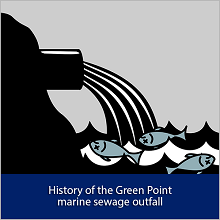 The City of Cape Town pumps 40 million litres of untreated sewage into the Atlantic Ocean from the Green Point outfall pipeline every day. Despite a long history of opposition from citizens and scientists, repeated instances of pollution and ill-health, and expensive maintenance, the City of Cape Town has remained committed to the Green Point outfall. Overy explores how the decision to build this marine outfall was reached in 1895. The story of the Green Point outfall is one in which short-term monetary thinking has thwarted the search for an ecologically and hydrologically sustainable alternative means of sewage disposal – a legacy the City’s residents and the oceans that surround it live with today.
The City of Cape Town pumps 40 million litres of untreated sewage into the Atlantic Ocean from the Green Point outfall pipeline every day. Despite a long history of opposition from citizens and scientists, repeated instances of pollution and ill-health, and expensive maintenance, the City of Cape Town has remained committed to the Green Point outfall. Overy explores how the decision to build this marine outfall was reached in 1895. The story of the Green Point outfall is one in which short-term monetary thinking has thwarted the search for an ecologically and hydrologically sustainable alternative means of sewage disposal – a legacy the City’s residents and the oceans that surround it live with today.
 Newly identified hominin tracksites are evidence that hominin tracks are more common in southern Africa than was previously supposed. Helm and colleagues have identified three new Pleistocene hominin tracksites on the Cape south coast of South Africa – one in the Garden Route National Park and two in the Goukamma Nature Reserve. Southern Africa now boasts six hominin tracksites, which are collectively the oldest sites in the world that are attributed to Homo sapiens. Tracks of varying size were present, indicating the presence of more than one trackmaker and raising the possibility of family groups. The tracks were made by early humans on dune surfaces, and have been preserved in aeolianites (cemented dune deposits), thus providing a record of their occurrence.
Newly identified hominin tracksites are evidence that hominin tracks are more common in southern Africa than was previously supposed. Helm and colleagues have identified three new Pleistocene hominin tracksites on the Cape south coast of South Africa – one in the Garden Route National Park and two in the Goukamma Nature Reserve. Southern Africa now boasts six hominin tracksites, which are collectively the oldest sites in the world that are attributed to Homo sapiens. Tracks of varying size were present, indicating the presence of more than one trackmaker and raising the possibility of family groups. The tracks were made by early humans on dune surfaces, and have been preserved in aeolianites (cemented dune deposits), thus providing a record of their occurrence.
In an article published in the South African Journal of Science in 1990 (vol 86(4):182–186), renowned UCT virologist Edward Rybicki described viruses as ‘organisms at the edge of life’. There, he explained how much humanity still needed to learn about these, often lethal, organisms that spread and mutate in many different environments.
 Our globalised world has seen saturated media coverage of the COVID-19 pandemic. The medical community has not yet been able to understand fully the origins or trajectory of the SARS-CoV-2 virus, and an enormous amount of biological research into a vaccination and potential cure lies ahead. However, the pandemic has already bared the fragile and unequal social and economic structures underlying South Africa, and in this issue of the Journal we foreground what contributions the humanities and social sciences can make to charting a path into an improved future. This series of invited contributions – entitled ‘More eyes on COVID-19’ – from experts in diverse disciplines in the humanities and social sciences will have lasting value for our country in the difficult period that lies ahead. The need for ‘more eyes on the problem’ from a wide range of disciplines is echoed in ASSAf’s Public Statement calling for government to draw on a broad range of expertise for its advisory structures.
Our globalised world has seen saturated media coverage of the COVID-19 pandemic. The medical community has not yet been able to understand fully the origins or trajectory of the SARS-CoV-2 virus, and an enormous amount of biological research into a vaccination and potential cure lies ahead. However, the pandemic has already bared the fragile and unequal social and economic structures underlying South Africa, and in this issue of the Journal we foreground what contributions the humanities and social sciences can make to charting a path into an improved future. This series of invited contributions – entitled ‘More eyes on COVID-19’ – from experts in diverse disciplines in the humanities and social sciences will have lasting value for our country in the difficult period that lies ahead. The need for ‘more eyes on the problem’ from a wide range of disciplines is echoed in ASSAf’s Public Statement calling for government to draw on a broad range of expertise for its advisory structures.
That the pandemic is not simply a medical problem but a social problem is further evidenced by contributions in this issue by Hedding and colleagues on the effects on higher education and research and by Walwyn who reports on ASSAf’s recent Presidential Roundtable on the future of universities in a post-COVID-19 world.
Besides the direct health effects, there will be indirect health effects from the pandemic. Chetty and co-authors report on the potential public health risk of extended electronic device use during the pandemic, including impairments to vision, the musculoskeletal system and sleep, while ASSAf’s Standing Committee on Health recently released a Statement on the unanticipated costs of COVID-19 to South Africa’s quadruple disease burden. The Statement advocates for careful priority setting that takes into consideration basic health interventions and services, while simultaneously addressing the COVID-19 pandemic.
ASSAf’s Public Statement on COVID-19 also recognises the connection between science and credibility and public trust. Joubert analyses the role of Professor Salim Abdool Karim, prominent South African epidemiologist, as the visible and trusted public scientific voice during this pandemic. Joubert dissects the traits that distinguish Abdool Karim’s effective policy interventions, linking them to his willingness to engage with government, the media and the public.
‘Preventing the next pandemic’ is on everyone’s minds and is the title of the scientific assessment on zoonotic diseases released this month by the United Nations Environment Programme and International Livestock Research Institute. Wernecke and co-authors reflect on the findings of this report as they might apply in South Africa.
 Information obtained from the tree rings of 1000-year-old baobabs in Pafuri provided the first identification of prominent solar cycles in southern Africa using carbon isotope data. The sun is a variable star that exhibits changes on multiple spatial and temporal scales, and is the most important source of energy for the earth’s climate system. Thus, weather and climate are influenced by solar activity. Solar activity is characterised by periodicities and cycles that vary on a variety of timescales. The most important periodicities are the ~11-year sunspot cycle (also known as the Schwabe cycle), the ~22-year magnetic cycle (also known as the Hale cycle), the 80–110-year Gleissberg cycle and the ~205–year De Vries cycle. Kotzé used annual carbon isotope (δ13C) data obtained from baobab trees (Adansonia digitata L.) for the period 1600 AD – 2000 AD. The data show clear evidence of the presence of characteristic solar periodicities including the ~11-year Schwabe cycle, the ~22-year Hale cycle and the 80–110-year Gleissberg cycle.
Information obtained from the tree rings of 1000-year-old baobabs in Pafuri provided the first identification of prominent solar cycles in southern Africa using carbon isotope data. The sun is a variable star that exhibits changes on multiple spatial and temporal scales, and is the most important source of energy for the earth’s climate system. Thus, weather and climate are influenced by solar activity. Solar activity is characterised by periodicities and cycles that vary on a variety of timescales. The most important periodicities are the ~11-year sunspot cycle (also known as the Schwabe cycle), the ~22-year magnetic cycle (also known as the Hale cycle), the 80–110-year Gleissberg cycle and the ~205–year De Vries cycle. Kotzé used annual carbon isotope (δ13C) data obtained from baobab trees (Adansonia digitata L.) for the period 1600 AD – 2000 AD. The data show clear evidence of the presence of characteristic solar periodicities including the ~11-year Schwabe cycle, the ~22-year Hale cycle and the 80–110-year Gleissberg cycle.
 Allergic respiratory diseases affect 20 million South Africans, with pollen and fungal spores (aerospora) amongst the leading triggers. Asthma triggered by aerospora can be life threatening, and allergic rhinitis causes considerable morbidity and carries financial implications for individuals and health systems. Cases of allergic rhinitis are globally increasing due to climate change. Effective diagnosis and treatment of allergies requires knowledge of geographical variation, seasonal timing and annual aerospora fluctuations in South Africa, where climate and vegetation are exceptionally diverse. Ajikah and colleagues introduce SAPNET – the South African Pollen Network – which was launched in August 2019. Spore traps in seven major South African cities (Bloemfontein, Cape Town, Durban, Johannesburg, Kimberley, Port Elizabeth, Pretoria) monitor weekly variations in aerospora. Such data provide insight into the high–low risk periods for sensitised individuals through weekly online updates (on www.pollencount.co.za), and provide for the development of updated pollen calendars for major cities and provinces spanning different biomes. Information on allergenic aerospora assists health-care providers to make clinical diagnoses and decisions and pollen allergy sufferers to identify plants which have the tendency to produce allergenic pollen in their environment and adopt prophylactic measures
Allergic respiratory diseases affect 20 million South Africans, with pollen and fungal spores (aerospora) amongst the leading triggers. Asthma triggered by aerospora can be life threatening, and allergic rhinitis causes considerable morbidity and carries financial implications for individuals and health systems. Cases of allergic rhinitis are globally increasing due to climate change. Effective diagnosis and treatment of allergies requires knowledge of geographical variation, seasonal timing and annual aerospora fluctuations in South Africa, where climate and vegetation are exceptionally diverse. Ajikah and colleagues introduce SAPNET – the South African Pollen Network – which was launched in August 2019. Spore traps in seven major South African cities (Bloemfontein, Cape Town, Durban, Johannesburg, Kimberley, Port Elizabeth, Pretoria) monitor weekly variations in aerospora. Such data provide insight into the high–low risk periods for sensitised individuals through weekly online updates (on www.pollencount.co.za), and provide for the development of updated pollen calendars for major cities and provinces spanning different biomes. Information on allergenic aerospora assists health-care providers to make clinical diagnoses and decisions and pollen allergy sufferers to identify plants which have the tendency to produce allergenic pollen in their environment and adopt prophylactic measures
 Sufficient local log resource options exist to realise a sustainable all-wood residential construction market in South Africa. Timber is not only renewable but is also the best performer across most environmental impact factors when compared to building materials such as steel and concrete, with particularly good performance in terms of greenhouse gas emissions. But only 1% of new residential housing structures in South Africa are wood based. Crafford and Wessels investigated the South African log resource availability and the potential global warming impact of an increasing wood-based residential building market. They show that, with the use of wood resources currently exported as chips and by planting trees in areas that have been earmarked for afforestation, a sustainable wood-based residential building market is possible. Their basic modelling analyses show that if the market share of wood-based buildings increases to 20% of new constructions, the embodied energy and global warming potential of the residential building sector could decrease by 4.9%. If all new constructions were wood based, the total embodied energy and global warming potential of the residential building sector could decrease by up to 30%.
Sufficient local log resource options exist to realise a sustainable all-wood residential construction market in South Africa. Timber is not only renewable but is also the best performer across most environmental impact factors when compared to building materials such as steel and concrete, with particularly good performance in terms of greenhouse gas emissions. But only 1% of new residential housing structures in South Africa are wood based. Crafford and Wessels investigated the South African log resource availability and the potential global warming impact of an increasing wood-based residential building market. They show that, with the use of wood resources currently exported as chips and by planting trees in areas that have been earmarked for afforestation, a sustainable wood-based residential building market is possible. Their basic modelling analyses show that if the market share of wood-based buildings increases to 20% of new constructions, the embodied energy and global warming potential of the residential building sector could decrease by 4.9%. If all new constructions were wood based, the total embodied energy and global warming potential of the residential building sector could decrease by up to 30%.
Marine plastic debris in South Africa: From sources to solutions
Major data gaps have led to miscalculations and uncertainties about South Africa’s contribution to marine plastic debris. An important series of reviews on marine plastic debris in South Africa in this issue provides the latest information on the sources, pathways and impacts of marine plastic debris, as well as monitoring of mitigation measures.
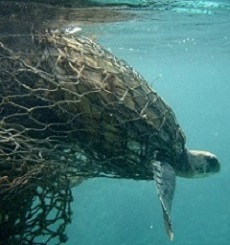 Despite global concern and decades of research on marine plastics, there is still a significant lack of research regarding the impacts of marine plastic debris on ecosystem services and on the economy in South Africa, according to the review by Arabi and Nahman. More insight into the economic impacts would help to inform an appropriate policy response.
Despite global concern and decades of research on marine plastics, there is still a significant lack of research regarding the impacts of marine plastic debris on ecosystem services and on the economy in South Africa, according to the review by Arabi and Nahman. More insight into the economic impacts would help to inform an appropriate policy response.
Better infrastructure is needed to improve monitoring and research on the effects of marine debris in South Africa. Naidoo and colleagues review the effects on marine biota and human health. Marine biota are affected through entanglement with macroplastics (>5 mm) and ingestion of microplastics (≤5 mm). Effects on human health are largely unknown, but shellfish ingestion is a potential source of microplastics for humans, and plastic additives can pose a threat.
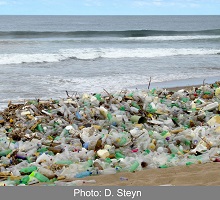 Ryan and colleagues report that the monitoring of plastic from land-based sources is best addressed on land (e.g. in storm drains and river run-off) before the plastic reaches the sea. High densities of waste plastic around urban centres indicate that most plastic comes from local, land-based sources and does not disperse far at sea. Beach clean-ups remove up to 90% of the mass of stranded plastic, which is largely found in macroplastic items (>25 mm).
Ryan and colleagues report that the monitoring of plastic from land-based sources is best addressed on land (e.g. in storm drains and river run-off) before the plastic reaches the sea. High densities of waste plastic around urban centres indicate that most plastic comes from local, land-based sources and does not disperse far at sea. Beach clean-ups remove up to 90% of the mass of stranded plastic, which is largely found in macroplastic items (>25 mm).
The global model prediction of plastic leakage from South Africa into the sea is probably a gross overestimate. Verster and Bouwman report that more accurate and recent data yield a contribution of between 15 000 to 40 000 tonnes of plastic per year carried to the oceans from South Africa – six-fold less than the widely used previous estimate. The seabed is a long-term sink for marine plastics, but densities of plastic on the seabed around South Africa are still modest.
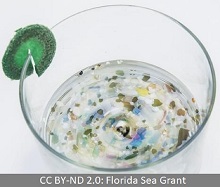 Microplastics can also enter the marine environment through inadequately treated waste-water effluent discharged into the ocean. Although waste-water treatment plants are reported to remove most plastic from waste water, the state of waste-water treatment plants in South Africa is a key concern: up to 40% of the country’s waste water is untreated. Microplastics can also enter the drinking water value chain through this route. Ubomba-Jaswa and Kalebaila report on a study commissioned by the Water Research Commission in which microplastics were found in drinking water in South Africa.
Microplastics can also enter the marine environment through inadequately treated waste-water effluent discharged into the ocean. Although waste-water treatment plants are reported to remove most plastic from waste water, the state of waste-water treatment plants in South Africa is a key concern: up to 40% of the country’s waste water is untreated. Microplastics can also enter the drinking water value chain through this route. Ubomba-Jaswa and Kalebaila report on a study commissioned by the Water Research Commission in which microplastics were found in drinking water in South Africa.
Marine plastic debris in South Africa: What is being done?
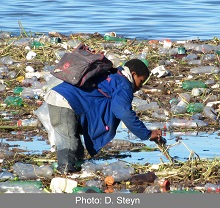 Marlin and Ribbink report on the African Marine Waste Network (AMWN) and its aim to achieve ‘Zero Plastics to the Seas of Africa’. The AMWN was launched in 2016 as the main programme of the Sustainable Seas Trust and works with all 54 African countries to reduce the amount of plastic entering the sea. Africa faces many waste-management challenges, together with high population growth, rapid urbanisation, high poverty and increasing consumption, which are collectively contributing to Africa becoming the most plastic polluted continent. Hanekom describes the ‘South African Initiative to End Plastic Pollution in the Environment’. This Initiative was formed in 2019 in recognition of the need to develop a workable local plan that fits the South African context and addresses our unique environmental, social, economic and political issues. Six working groups address different aspects of the Initiative: (1) technology, innovation and design, (2) infrastructure, (3) bioplastics and alternatives, (4) education and awareness, (5) standards and compliance and (6) integrating waste pickers into the circular economy. The circular economy concept provides a solution to the plastic pollution quandary by providing a way forward to decouple material consumption from economic growth and increase the value of secondary material, thus ultimately decreasing waste and pollution. The circular economy response to plastic pollution is detailed by De Kock and colleagues.
Marlin and Ribbink report on the African Marine Waste Network (AMWN) and its aim to achieve ‘Zero Plastics to the Seas of Africa’. The AMWN was launched in 2016 as the main programme of the Sustainable Seas Trust and works with all 54 African countries to reduce the amount of plastic entering the sea. Africa faces many waste-management challenges, together with high population growth, rapid urbanisation, high poverty and increasing consumption, which are collectively contributing to Africa becoming the most plastic polluted continent. Hanekom describes the ‘South African Initiative to End Plastic Pollution in the Environment’. This Initiative was formed in 2019 in recognition of the need to develop a workable local plan that fits the South African context and addresses our unique environmental, social, economic and political issues. Six working groups address different aspects of the Initiative: (1) technology, innovation and design, (2) infrastructure, (3) bioplastics and alternatives, (4) education and awareness, (5) standards and compliance and (6) integrating waste pickers into the circular economy. The circular economy concept provides a solution to the plastic pollution quandary by providing a way forward to decouple material consumption from economic growth and increase the value of secondary material, thus ultimately decreasing waste and pollution. The circular economy response to plastic pollution is detailed by De Kock and colleagues.
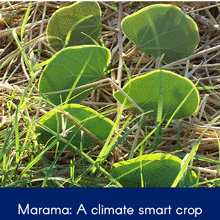 Marama (Tylosema esculentum) is a climate smart crop with potential for contributing to food security in arid regions. Starch is a major dietary source of energy for humans and accounts for 90% of caloric intake in developing countries. Both the seeds and storage root of marama have a high nutrient value and are consumed as food. The desired functional properties of the marama storage root can be achieved by controlling growth time. Hamunyela and colleagues determined the most suitable time for harvesting marama root, finding that the optimum time for harvesting as a root vegetable is at 4 months and for its starch content at 8 months post-planting; highest crude protein was found at 2 months. Planting should be undertaken at the beginning of summer to allow harvesting before the plants’ reserves are depleted during winter. Marama is a wild-growing and drought-tolerant legume, native to the arid and semi-arid regions of southern Africa. Marama grows naturally in poor soil and thrives in arid conditions in which few conventional crops can survive.
Marama (Tylosema esculentum) is a climate smart crop with potential for contributing to food security in arid regions. Starch is a major dietary source of energy for humans and accounts for 90% of caloric intake in developing countries. Both the seeds and storage root of marama have a high nutrient value and are consumed as food. The desired functional properties of the marama storage root can be achieved by controlling growth time. Hamunyela and colleagues determined the most suitable time for harvesting marama root, finding that the optimum time for harvesting as a root vegetable is at 4 months and for its starch content at 8 months post-planting; highest crude protein was found at 2 months. Planting should be undertaken at the beginning of summer to allow harvesting before the plants’ reserves are depleted during winter. Marama is a wild-growing and drought-tolerant legume, native to the arid and semi-arid regions of southern Africa. Marama grows naturally in poor soil and thrives in arid conditions in which few conventional crops can survive.
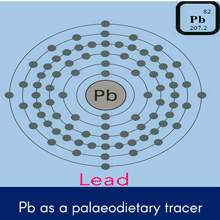 Scott and colleagues have demonstrated the considerable potential of lead isotopes for use as a dietary and palaeodietary tracer in near-coastal systems in fields as diverse as archaeology, palaeontology, wildlife ecology and forensics. Scott and colleagues examined strontium and lead isotopes as biogeochemical tracers for studying diet and landscape usage in southwestern South Africa in both contemporary and ancient contexts – the first-ever investigation of lead isotopes for this purpose. Consumer body tissues record the isotopic composition of food and water ingested in life, and because isotopes vary across landscapes, they provide a natural tracer of diet and migration. Geologically recent sediments of marine origin in near-coastal environments could be distinguished from older geologies further inland using strontium isotopes, but Cape granites could only be distinguished using lead isotopes. Unlike strontium, lead isotopic ratios are not influenced by marine input because of the low concentration of lead in seawater. A combination of strontium and lead isotope data can therefore be valuable in coastal terrestrial environments to trace migration and landscape usage.
Scott and colleagues have demonstrated the considerable potential of lead isotopes for use as a dietary and palaeodietary tracer in near-coastal systems in fields as diverse as archaeology, palaeontology, wildlife ecology and forensics. Scott and colleagues examined strontium and lead isotopes as biogeochemical tracers for studying diet and landscape usage in southwestern South Africa in both contemporary and ancient contexts – the first-ever investigation of lead isotopes for this purpose. Consumer body tissues record the isotopic composition of food and water ingested in life, and because isotopes vary across landscapes, they provide a natural tracer of diet and migration. Geologically recent sediments of marine origin in near-coastal environments could be distinguished from older geologies further inland using strontium isotopes, but Cape granites could only be distinguished using lead isotopes. Unlike strontium, lead isotopic ratios are not influenced by marine input because of the low concentration of lead in seawater. A combination of strontium and lead isotope data can therefore be valuable in coastal terrestrial environments to trace migration and landscape usage.
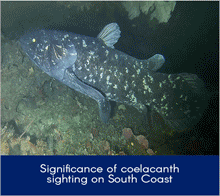 This single coelacanth was sighted at about 09:00 on 22 November 2019 by a team of divers on the South Coast of KwaZulu-Natal, South Africa. The dive team, together with Mike Bruton, describe the sighting and its significance. Despite the attention of the divers and their strobe lights, the coelacanth remained relatively motionless. At an estimated 180–200 cm and 100 kg, it almost certainly is a female individual as male coelacanths rarely exceed 150 cm in length. This estimated size is comparable to the largest coelacanths on record according to the Coelacanth Conservation Council. The sighting is significant for a number of reasons. The location indicates that coelacanths live further south along our coast than previously believed. The depth of the sighting (69 m) suggests that they may live in shallower waters than thought, at least at the southern end of their range. This in itself is significant because it means that they may be more accessible for study to mixed-gas divers and shallow-water remotely operated vehicles and submersibles. The discovery also reveals how little we know about our marine life. That coelacanths may have been living undiscovered off the heavily fished south coast of KwaZulu-Natal, despite their high profile, suggests that many remarkable discoveries remain to be made in our oceans.
This single coelacanth was sighted at about 09:00 on 22 November 2019 by a team of divers on the South Coast of KwaZulu-Natal, South Africa. The dive team, together with Mike Bruton, describe the sighting and its significance. Despite the attention of the divers and their strobe lights, the coelacanth remained relatively motionless. At an estimated 180–200 cm and 100 kg, it almost certainly is a female individual as male coelacanths rarely exceed 150 cm in length. This estimated size is comparable to the largest coelacanths on record according to the Coelacanth Conservation Council. The sighting is significant for a number of reasons. The location indicates that coelacanths live further south along our coast than previously believed. The depth of the sighting (69 m) suggests that they may live in shallower waters than thought, at least at the southern end of their range. This in itself is significant because it means that they may be more accessible for study to mixed-gas divers and shallow-water remotely operated vehicles and submersibles. The discovery also reveals how little we know about our marine life. That coelacanths may have been living undiscovered off the heavily fished south coast of KwaZulu-Natal, despite their high profile, suggests that many remarkable discoveries remain to be made in our oceans.
Image: Coelacanth off Pumula on the KwaZulu-Natal South Coast, South Africa, on 22 November 2019 (photo: Bruce Henderson)
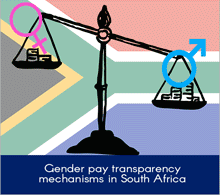 Despite an enviable Constitution that protects against discrimination on the basis of gender, South Africa still experiences a gender pay gap of 23–35%. That is, women in South Africa are paid one-quarter to one-third less than their male counterparts. Although South Africa is doing comparatively well – 1st in Africa and 19th globally – the effects of the gender wage gap are even broader when it is considered that almost 40% of South African households are headed by women and half of those support extended family members – and that these households are 40% poorer than those headed by men. Bosch and Barit review and compare global and national mechanisms of pay transparency and propose a way forward for South Africa. The World Economic Forum has estimated that closing the gender economic gap may take another 202 years! The need to prioritise transparency in gender wage equality is clear.
Despite an enviable Constitution that protects against discrimination on the basis of gender, South Africa still experiences a gender pay gap of 23–35%. That is, women in South Africa are paid one-quarter to one-third less than their male counterparts. Although South Africa is doing comparatively well – 1st in Africa and 19th globally – the effects of the gender wage gap are even broader when it is considered that almost 40% of South African households are headed by women and half of those support extended family members – and that these households are 40% poorer than those headed by men. Bosch and Barit review and compare global and national mechanisms of pay transparency and propose a way forward for South Africa. The World Economic Forum has estimated that closing the gender economic gap may take another 202 years! The need to prioritise transparency in gender wage equality is clear.
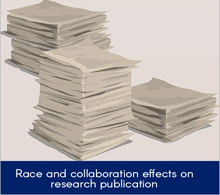 Research productivity is influenced by a combination of factors that include age, gender, rank, experience and qualifications, discipline, and collaboration and co-authorship. Two– race and co-authorship – are examined in this issue. Sooryamoorthy and Mtshali examined the inter-relationship between race and research productivity of scholars in 22 science departments in KwaZulu-Natal, South Africa, and found notable differences. African respondents had lower than average productivity (measured by the number of research publications) in 2008, but higher than average productivity in 2014. Although this increase may indicate a positive change as a measure of transformation in higher education in South Africa, a significant proportion of the African respondents were foreign nationals who had moved to South Africa. De Jager and colleagues examined the relationship between collaboration and citations of health science publications from the University of Cape Town. They found not only that the relative citation rate was higher for publications that were co-authored by international co-authors, but that the publications with the highest relative citation rates were those driven by authors from foreign institutions. They conclude that this apparent influence of, and possible dependence on, foreign drivers for high citation impact holds risk for South African science.
Research productivity is influenced by a combination of factors that include age, gender, rank, experience and qualifications, discipline, and collaboration and co-authorship. Two– race and co-authorship – are examined in this issue. Sooryamoorthy and Mtshali examined the inter-relationship between race and research productivity of scholars in 22 science departments in KwaZulu-Natal, South Africa, and found notable differences. African respondents had lower than average productivity (measured by the number of research publications) in 2008, but higher than average productivity in 2014. Although this increase may indicate a positive change as a measure of transformation in higher education in South Africa, a significant proportion of the African respondents were foreign nationals who had moved to South Africa. De Jager and colleagues examined the relationship between collaboration and citations of health science publications from the University of Cape Town. They found not only that the relative citation rate was higher for publications that were co-authored by international co-authors, but that the publications with the highest relative citation rates were those driven by authors from foreign institutions. They conclude that this apparent influence of, and possible dependence on, foreign drivers for high citation impact holds risk for South African science.
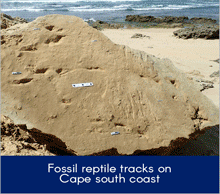 Helm and colleagues have discovered fossil tracks, including probable swim traces, on the Cape south coast that were likely made by large reptiles living in the Pleistocene. Theirs is the first report of reptile swim traces in Africa. The tracks appear to have been made by more than one reptile species, but no reptiles of comparable size are found in the region today. The tracksites lie within the Wilderness Embayment of the Garden Route National Park and none of the tracksites found was in situ. There were 14 surfaces with tracksites identified. One of the larger surfaces described has since been buried by a landslide that occurred earlier this year – signifying the importance of early detection and documentation of newly exposed tracksites.
Helm and colleagues have discovered fossil tracks, including probable swim traces, on the Cape south coast that were likely made by large reptiles living in the Pleistocene. Theirs is the first report of reptile swim traces in Africa. The tracks appear to have been made by more than one reptile species, but no reptiles of comparable size are found in the region today. The tracksites lie within the Wilderness Embayment of the Garden Route National Park and none of the tracksites found was in situ. There were 14 surfaces with tracksites identified. One of the larger surfaces described has since been buried by a landslide that occurred earlier this year – signifying the importance of early detection and documentation of newly exposed tracksites.
Image: A rock surface showing fossil large reptile tracks. This surface has since been buried. Photo: Helm et al.
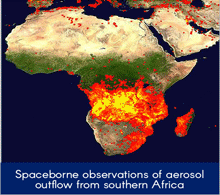 Reports of the spread of aerosols from the recent and devastating Australian bushfires extending across the South Pacific Ocean as far as Chile and Argentina are well known. What is generally less well known is that aerosols from biomass burning in southern Africa are also transported as far as Australia and South America. Although the transport of aerosols from southern Africa over the Indian Ocean towards Australia has been postulated for over 25 years, McGill and colleagues present the first observations that can support the modelled predictions. Using the Cloud-Aerosol Transport System (CATS) instrument onboard the International Space Station, which has the sensitivity to detect aerosol transport, McGill and colleagues report that transport from Africa to Australia generally took 5 to 7 days.
Reports of the spread of aerosols from the recent and devastating Australian bushfires extending across the South Pacific Ocean as far as Chile and Argentina are well known. What is generally less well known is that aerosols from biomass burning in southern Africa are also transported as far as Australia and South America. Although the transport of aerosols from southern Africa over the Indian Ocean towards Australia has been postulated for over 25 years, McGill and colleagues present the first observations that can support the modelled predictions. Using the Cloud-Aerosol Transport System (CATS) instrument onboard the International Space Station, which has the sensitivity to detect aerosol transport, McGill and colleagues report that transport from Africa to Australia generally took 5 to 7 days.
 The complex nature of the chemical bond gives rise to the amazing variety of materials that are available in the world today. And the discovery of new materials is sure to drive the technologies of the future. In this endeavour, South Africa – which is rich in mineral resources – is at an advantage. Our country’s natural resources should, however, be used wisely and in a manner that builds strong beneficiation industries as well as human capital, advises Alexander Quandt. Quandt is the recipient of the 2018/2019 NSTF-South 32 Special Annual Theme Award to mark the International Year of the Periodic Table of Chemical Elements. The discovery of the chemical elements that fill the periodic table was the beginning of the journey into materials science. Quandt shares highlights of his journey in materials science in an Invited Commentary.
The complex nature of the chemical bond gives rise to the amazing variety of materials that are available in the world today. And the discovery of new materials is sure to drive the technologies of the future. In this endeavour, South Africa – which is rich in mineral resources – is at an advantage. Our country’s natural resources should, however, be used wisely and in a manner that builds strong beneficiation industries as well as human capital, advises Alexander Quandt. Quandt is the recipient of the 2018/2019 NSTF-South 32 Special Annual Theme Award to mark the International Year of the Periodic Table of Chemical Elements. The discovery of the chemical elements that fill the periodic table was the beginning of the journey into materials science. Quandt shares highlights of his journey in materials science in an Invited Commentary.
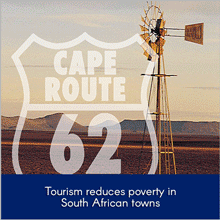 Tourism drives prosperity and reduces poverty in South African towns and should be strongly supported. Communities in towns with more tourist and hospitality enterprises are wealthier. Debates on pro-poor tourism have tended to focus on individual poverty, but they should include impacts on community wealth/poverty. Toerien explored the links between tourism and community poverty in 38 rural South African towns using the enterprise dependency index (population/number of enterprises) as a measure of community wealth. Residents of smaller towns were more dependent on tourism than those of larger towns. Leadership provided by individuals in some towns as well as the location of other towns – being on the N1 or Route 62 or close to attractions like an astronomical observatory (Sutherland) or affiliation with well-known figures like Athol Fugard (Nieu-Bethesda) and Deon Meyer (Loxton) – contribute to the success of tourism in those towns.
Tourism drives prosperity and reduces poverty in South African towns and should be strongly supported. Communities in towns with more tourist and hospitality enterprises are wealthier. Debates on pro-poor tourism have tended to focus on individual poverty, but they should include impacts on community wealth/poverty. Toerien explored the links between tourism and community poverty in 38 rural South African towns using the enterprise dependency index (population/number of enterprises) as a measure of community wealth. Residents of smaller towns were more dependent on tourism than those of larger towns. Leadership provided by individuals in some towns as well as the location of other towns – being on the N1 or Route 62 or close to attractions like an astronomical observatory (Sutherland) or affiliation with well-known figures like Athol Fugard (Nieu-Bethesda) and Deon Meyer (Loxton) – contribute to the success of tourism in those towns.
Image: A windmill in the Karoo, South Africa (image CC-BY 2.0: South African Tourism)
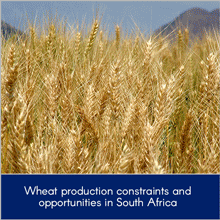 Amid the wheat production crisis that South Africa faces, there is a misalignment between current research efforts and farmer priorities. The continual decline in the national yield of wheat has drawn the attention of both policymakers and researchers. Like other developing countries, South Africa has the challenge of an increasing population and food insecurity, and decreasing wheat yields suggests that current policies, research and development projects may not be well aligned to farmer priorities. Dube and colleagues identified the dominant constraint to irrigation wheat yield as the low market price for grain, which makes farmers reluctant to invest in inputs for increasing yield. Farmers attributed water problems during peak demand as the main cause of low yields. The perceptions of researchers regarding the major constraints were different from those of the farmers, indicating that researchers must work more closely with farmers. When breeding cultivars, the focus should not just be yield, but also water and fertiliser efficiency. There is also a need for more government resources and policies to support wheat farmers.
Amid the wheat production crisis that South Africa faces, there is a misalignment between current research efforts and farmer priorities. The continual decline in the national yield of wheat has drawn the attention of both policymakers and researchers. Like other developing countries, South Africa has the challenge of an increasing population and food insecurity, and decreasing wheat yields suggests that current policies, research and development projects may not be well aligned to farmer priorities. Dube and colleagues identified the dominant constraint to irrigation wheat yield as the low market price for grain, which makes farmers reluctant to invest in inputs for increasing yield. Farmers attributed water problems during peak demand as the main cause of low yields. The perceptions of researchers regarding the major constraints were different from those of the farmers, indicating that researchers must work more closely with farmers. When breeding cultivars, the focus should not just be yield, but also water and fertiliser efficiency. There is also a need for more government resources and policies to support wheat farmers.
Image: A wheatfield in South Africa (image CC-BY-SA: Lotus Head)
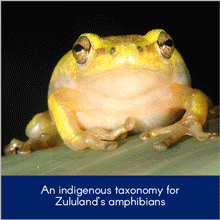 It is possible to standardise the indigenous names of South Africa’s amphibians and bridge the gap left by the standardisation of names in only two of South Africa’s official languages. In an Invited Commentary, Phaka describes a study investigating interactions between South Africa’s herpetofaunal and cultural diversity in Zululand – a region steeped in culture and rich in amphibian diversity. Zululand taxonomy’s use of single word names to group species based on their biology is in line with the International Code of Zoological Nomenclature. The similarities between indigenous and scientific taxonomy have enabled supplementation of indigenous taxonomy guidelines with their modern knowledge counterparts. These supplemented guidelines were then used to assign individual Zulu names to Zululand’s amphibian species.
It is possible to standardise the indigenous names of South Africa’s amphibians and bridge the gap left by the standardisation of names in only two of South Africa’s official languages. In an Invited Commentary, Phaka describes a study investigating interactions between South Africa’s herpetofaunal and cultural diversity in Zululand – a region steeped in culture and rich in amphibian diversity. Zululand taxonomy’s use of single word names to group species based on their biology is in line with the International Code of Zoological Nomenclature. The similarities between indigenous and scientific taxonomy have enabled supplementation of indigenous taxonomy guidelines with their modern knowledge counterparts. These supplemented guidelines were then used to assign individual Zulu names to Zululand’s amphibian species.
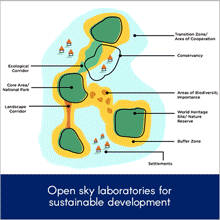 Biosphere reserves are ecological and cultural depositories in which research on the human–environment interface should be promoted and supported. Biosphere reserves – an initiative of UNESCO – are landscapes within which people and nature are linked in pursuit of development goals. Biosphere reserves have a responsibility to promote and support interdisciplinary and transdisciplinary research that is relevant to society and all are expected to have active research programmes based on sustainability science. In an Invited Commentary, Pool-Stanvliet and Coetzer present a brief overview of South African biosphere reserves, emphasising their value as scientific research arenas. South Africa has 10 biosphere reserves located in six provinces, encompassing an area of 116 000 square kilometres (9.5% of South Africa’s total land area). Although scientific outputs related to biosphere reserves have increased steadily since the mid-2000s, biosphere reserves still are underutilised as global transdisciplinary study sites.
Biosphere reserves are ecological and cultural depositories in which research on the human–environment interface should be promoted and supported. Biosphere reserves – an initiative of UNESCO – are landscapes within which people and nature are linked in pursuit of development goals. Biosphere reserves have a responsibility to promote and support interdisciplinary and transdisciplinary research that is relevant to society and all are expected to have active research programmes based on sustainability science. In an Invited Commentary, Pool-Stanvliet and Coetzer present a brief overview of South African biosphere reserves, emphasising their value as scientific research arenas. South Africa has 10 biosphere reserves located in six provinces, encompassing an area of 116 000 square kilometres (9.5% of South Africa’s total land area). Although scientific outputs related to biosphere reserves have increased steadily since the mid-2000s, biosphere reserves still are underutilised as global transdisciplinary study sites.
Image: Pool-Stanvliet & Coetzer
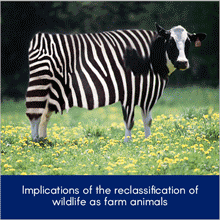 A new amendment of the Animal Improvement Act which classifies wild animal species as farm animals poses a risk to South Africa’s biodiversity heritage. Government Gazette No. 42464 dated 17 May 2019 amended Table 7 of the Animal Improvement Act (Act no. 62 of 1998), which lists breeds of animals, to include at least 32 new wild animal species, among them threatened and rare species such as cheetah, white and black rhino, and suni. Somers and colleagues argue that the main aim of this law, which is “to provide for the breeding, identification and utilisation of genetically superior animals to improve the production and performance of animals in the interest of the Republic…”, is fundamentally flawed when applied to wild animals. The genetic consequences of breeding wildlife species are negative and considerable. A logical endpoint of this amendment is two populations of each species: one wild and one domesticated. Maintaining this distinction will be expensive, if at all possible. Domesticated varieties of wildlife will represent a novel, genetic pollution threat to South Africa’s indigenous wildlife that will be virtually impossible to prevent or reverse.
A new amendment of the Animal Improvement Act which classifies wild animal species as farm animals poses a risk to South Africa’s biodiversity heritage. Government Gazette No. 42464 dated 17 May 2019 amended Table 7 of the Animal Improvement Act (Act no. 62 of 1998), which lists breeds of animals, to include at least 32 new wild animal species, among them threatened and rare species such as cheetah, white and black rhino, and suni. Somers and colleagues argue that the main aim of this law, which is “to provide for the breeding, identification and utilisation of genetically superior animals to improve the production and performance of animals in the interest of the Republic…”, is fundamentally flawed when applied to wild animals. The genetic consequences of breeding wildlife species are negative and considerable. A logical endpoint of this amendment is two populations of each species: one wild and one domesticated. Maintaining this distinction will be expensive, if at all possible. Domesticated varieties of wildlife will represent a novel, genetic pollution threat to South Africa’s indigenous wildlife that will be virtually impossible to prevent or reverse.
On the cover: From predators in the ocean to predators in academia…
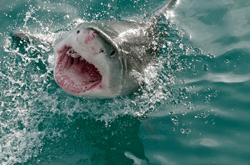
A white shark (Carcharodon carcharias). Gennari, Morse and colleagues investigated the antibiotic sensitivity of bacteria isolated from the oral cavities of white sharks. White sharks account for almost half of all shark-related injuries in South Africa, which has the third highest incidence of human–shark encounters worldwide. Their findings will assist in the treatment of shark bites.
In this issue, the focus is on a different kind of predator – an academic predator. These predators take various forms – plagiarism, cheating, sexual favours and unethical publishing practices. Their prevalence seems to be increasing globally, and they are a threat to the survival of academic integrity.
…and Promoting Academic Integrity
The theme of this SAJS issue is ‘Promoting Academic Integrity’. The theme emanates from and emulates that of the Council on Higher Education (CHE)’s Quality Promotion Conference held in February this year: Promoting Academic Integrity in Higher Education. The goal of the 2019 CHE conference was to provide a platform for sharing experiences, lessons and good practices in combating academic dishonesty. The participants – about 200 – were from higher education institutions, quality assurance agencies, professional bodies and government departments from South Africa and other African countries: Botswana, Malawi, Seychelles, Tanzania, Uganda, Zambia and Zimbabwe. Saidi provides a synopsis of the Conference in a Commentary in this issue in which he attests: ‘Participants spoke with one voice in condemning acts of academic dishonesty in higher education institutions.’
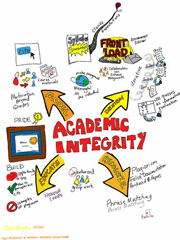
Selected papers presented at the Conference were submitted for publication in this themed issue, and address different aspects of academic dishonesty and the promotion of academic integrity. Singh and Baijnath examine the impact of the global scourge of cheating, as a symptom of ‘a moral decay that is beginning to manifest in society globally’. Whilst acknowledging technology as a significant enabler, they challenge universities to address the issue of cheating in exams openly and proactively. Failure to do so constitutes a fraud on society. Universities are also urged to develop, implement and follow through on policies related to sexual conduct, specifically that between lecturers and students. Ncube explored the prevalence of the ‘sexually transmitted marks’ phenomenon in higher education. Despite the perception that this form of academic misconduct is initiated by lecturers, Ncube reports that students are often also the instigator, and thus ‘efforts to eliminate this threat to academic integrity should not only focus on lecturers, but also be extended to students’. Another aspect of academic dishonesty which manifests in students is that of plagiarism. Mahabeer and Pirtheepal discuss plagiarism and the quality of teaching and assessment within the context of the massification of higher education. Within this context, they advocate for ‘a serious rethink of assessment strategies to deter academic dishonesty’.
Although there are policies in place in universities which address plagiarism, cheating and sexual harassment, the indications from these studies are that there is a lack of enforcement which perpetuates a culture of acceptance – ‘because everyone is doing it’. Upholding academic integrity is the responsibility of all actors.
Garwe explored the role of quality assurance agencies in academic integrity and found that, ‘by assuming an innovative and transformational leadership role in instilling a culture of self-evaluation, as well as maintaining its own integrity, an external quality assurance agency can improve academic integrity’.
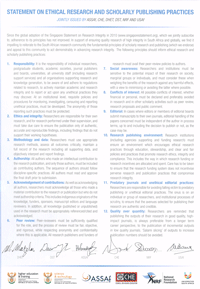
According to Pillay, of the South African National Research Foundation (NRF), upholding research integrity is no longer a simple task, but one that requires innovative, collaborative and coordinated approaches.
With this goal in mind, the NRF spearheaded the formulation of the joint Statement on Ethical Research and Scholarly Publishing Practices that sets out a national position on the issue of research ethics and scholarly publishing. The NRF, together with the other signatories to the Statement – CHE, Academy of Science of South Africa (ASSAf), Department of Higher Education and Training (DHET) and Universities South Africa (USAf) – as key national agencies, outline in Commentaries in this issue how they individually and collectively will be ‘putting the Statement into practice’.
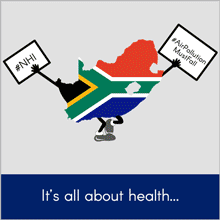 Human health and well-being are the focus of a number of articles in this issue. Sustainable Development Goal (SDG) 3 – Good Health and Well-being – has 13 targets which address all major health priorities, including communicable, non-communicable and environmental diseases, and universal health coverage. The contribution that the private sector can make to achieving SDG 3 – through financial, technological, research and corporate social investments – is being recognised, yet businesses are not reporting on these contributions in the public domain. Haywood and Wright examined the financial reports of 88 JSE-listed companies for 2016–2018 and found that only eight reports specifically mentioned contributions to SDG 3 in 2016. Although this number increased to 20 in 2018, the overall proportion is still low. Perhaps not surprisingly, the mining sector reported the most contributions to SDG 3. Even if driving SDGs is principally the responsibility of government, it is important that businesses recognise the role they can play in achieving SDG 3. One governmental initiative toward achieving SDG 3 Target 3.8 – universal health coverage – is National Health Insurance. Wright and colleagues explore how the effects of climate change will impact NHI, including its impact on disease prevention – a fundamental principle of NHI. South Africa ranks third worst in sub-Saharan Africa for mortality rate attributed to cardiovascular disease, cancer, diabetes and chronic respiratory disease. Despite this statistic and legislation in place to reduce air pollution in South Africa – and thus respiratory diseases – the objectives for reduction have not been met. According to Tshehla and Wright, the introduction of new small industries and failure to effectively reduce pollution from domestic burning, waste burning, biomass burning, vehicle emissions and mining activities within air pollution hotspots, make it impossible to achieve the desired air pollution reduction. Tshehla and Wright also recognise a gap between science and policy in air pollution reduction. In an effort to reduce this gap, a science–policy statement on air pollution and health was presented to senior UN representatives and high-level diplomats in July this year by the science academies of South Africa, Germany and Brazil and the US academies of medicine and science.
Human health and well-being are the focus of a number of articles in this issue. Sustainable Development Goal (SDG) 3 – Good Health and Well-being – has 13 targets which address all major health priorities, including communicable, non-communicable and environmental diseases, and universal health coverage. The contribution that the private sector can make to achieving SDG 3 – through financial, technological, research and corporate social investments – is being recognised, yet businesses are not reporting on these contributions in the public domain. Haywood and Wright examined the financial reports of 88 JSE-listed companies for 2016–2018 and found that only eight reports specifically mentioned contributions to SDG 3 in 2016. Although this number increased to 20 in 2018, the overall proportion is still low. Perhaps not surprisingly, the mining sector reported the most contributions to SDG 3. Even if driving SDGs is principally the responsibility of government, it is important that businesses recognise the role they can play in achieving SDG 3. One governmental initiative toward achieving SDG 3 Target 3.8 – universal health coverage – is National Health Insurance. Wright and colleagues explore how the effects of climate change will impact NHI, including its impact on disease prevention – a fundamental principle of NHI. South Africa ranks third worst in sub-Saharan Africa for mortality rate attributed to cardiovascular disease, cancer, diabetes and chronic respiratory disease. Despite this statistic and legislation in place to reduce air pollution in South Africa – and thus respiratory diseases – the objectives for reduction have not been met. According to Tshehla and Wright, the introduction of new small industries and failure to effectively reduce pollution from domestic burning, waste burning, biomass burning, vehicle emissions and mining activities within air pollution hotspots, make it impossible to achieve the desired air pollution reduction. Tshehla and Wright also recognise a gap between science and policy in air pollution reduction. In an effort to reduce this gap, a science–policy statement on air pollution and health was presented to senior UN representatives and high-level diplomats in July this year by the science academies of South Africa, Germany and Brazil and the US academies of medicine and science.
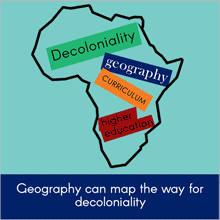
South African geography as a discipline – with its colonial roots – has the potential to bring to the fore the call for decoloniality. As Long and colleagues argue, geography, being deeply entrenched in the Western imperial canon, needs to engage with post-colonial theory and the efforts being made to decolonise the curriculum. However, the question of who should be allowed to speak on issues of decoloniality remains pertinent. Long et al. posit that the most highly ranked South African universities are too entrenched in their colonial pasts to voice the African experience and African theory. They propose that these universities should partner with other universities that have students and academics who are truly able to be the African voice that can speak back to the colonial curriculum.
 This year marks the 150th anniversary of the periodic table. Skotnes-Brown outlines the history of the periodic table, equating it to chemistry as Darwin’s theory of natural selection is to biology. But the modern periodic table we all recognise and take for granted, is not just an organisational and educational tool – it is also a highly mediated record of the history of chemistry and a means of ‘predicting’ future elements. Dmitri Mendeleev is credited as the ‘discoverer’ of the periodic system, but there were at least six such ‘discoveries’ during the 1860s – some were in tabular form, others three-dimensional, spiral or even in the arrangement of a musical scale organised in a ‘law of octaves’. The ultimate success of Mendeleev’s periodic table was his treatment of time and his capacity to speculate: he left gaps which could be filled with elements yet to be discovered.
This year marks the 150th anniversary of the periodic table. Skotnes-Brown outlines the history of the periodic table, equating it to chemistry as Darwin’s theory of natural selection is to biology. But the modern periodic table we all recognise and take for granted, is not just an organisational and educational tool – it is also a highly mediated record of the history of chemistry and a means of ‘predicting’ future elements. Dmitri Mendeleev is credited as the ‘discoverer’ of the periodic system, but there were at least six such ‘discoveries’ during the 1860s – some were in tabular form, others three-dimensional, spiral or even in the arrangement of a musical scale organised in a ‘law of octaves’. The ultimate success of Mendeleev’s periodic table was his treatment of time and his capacity to speculate: he left gaps which could be filled with elements yet to be discovered.
Image: Cape Town Science Centre
 Internationally renowned for centuries for its scientific interest and beauty, South Africa’s Cape Floristic Region – a World Heritage Site and unique biodiversity hotspot – requires ongoing research and management. As one of the planet’s five Mediterranean Type Ecosystems, well-grounded research priorities are critically important to its conservation. To be effective in countering anthropogenic drivers of change, research must be responsive to the concerns of the wider community, not only those of specialists. Allsopp and colleagues surveyed a variety of stakeholders and interested parties and found that the Cape Floristic Region conservation community implicitly recognises that in order to be effective in this landscape, conservation research must move towards multi- and interdisciplinarity (including the human and social sciences) and initiate a broader research agenda.
Internationally renowned for centuries for its scientific interest and beauty, South Africa’s Cape Floristic Region – a World Heritage Site and unique biodiversity hotspot – requires ongoing research and management. As one of the planet’s five Mediterranean Type Ecosystems, well-grounded research priorities are critically important to its conservation. To be effective in countering anthropogenic drivers of change, research must be responsive to the concerns of the wider community, not only those of specialists. Allsopp and colleagues surveyed a variety of stakeholders and interested parties and found that the Cape Floristic Region conservation community implicitly recognises that in order to be effective in this landscape, conservation research must move towards multi- and interdisciplinarity (including the human and social sciences) and initiate a broader research agenda.
Image: CC-BY-SA: Rialfver, Wikimedia Commons
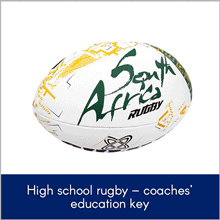 This month sees the start of the 2019 Rugby World Cup in Japan. The captain of the South African team, Siya Kolisi, is the first black player to skipper South Africa at a World Cup event. Yet black players are still underrepresented in elite rugby. Development of underrepresented players needs to begin from grassroots to ensure these players can fulfil their potential and reach the highest level of the sport. According to a study conducted by Robinson and colleagues, education of coaches, especially those at underprivileged schools, is key to implementing strength and conditioning practices that are on par with those of the top 100 rugby playing schools in South Africa. Robinson and colleagues examined the strength and conditioning practices employed by coaches of high school boy rugby teams in South Africa and compared practices between schools of different socio-economic status. Coaches at schools in the top 100 rugby playing schools in the country implement similar strength and conditioning practices to the best-known international practices
This month sees the start of the 2019 Rugby World Cup in Japan. The captain of the South African team, Siya Kolisi, is the first black player to skipper South Africa at a World Cup event. Yet black players are still underrepresented in elite rugby. Development of underrepresented players needs to begin from grassroots to ensure these players can fulfil their potential and reach the highest level of the sport. According to a study conducted by Robinson and colleagues, education of coaches, especially those at underprivileged schools, is key to implementing strength and conditioning practices that are on par with those of the top 100 rugby playing schools in South Africa. Robinson and colleagues examined the strength and conditioning practices employed by coaches of high school boy rugby teams in South Africa and compared practices between schools of different socio-economic status. Coaches at schools in the top 100 rugby playing schools in the country implement similar strength and conditioning practices to the best-known international practices
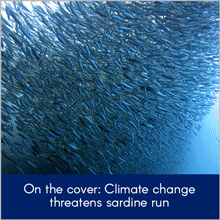 The sardine run – the annual migration of sardines along South Africa's east coast – is occurring later each year. In recent years, it has even failed to take place. Any delay has significant implications for fisheries and tourism as the associated dolphin, whale and shark sightings are an important tourist attraction. Fitchett and colleagues explored changes in the timing of the sardine run over the period 1946–2012 and found that the delay – 1.3 days per decade – is related to regional sea surface warming, ENSO conditions, and a reduced frequency of tropical cyclones, all factors of a changing climate. Shifts in the timing of phenological events (annually recurrent biological events) are considered highly sensitive biological indicatorsof climate change and they are driven by seasonal changes in climate. The delayed timing of the sardine run is of concern at the ecosystem scale because of the predator–prey mismatches that may ensue.
The sardine run – the annual migration of sardines along South Africa's east coast – is occurring later each year. In recent years, it has even failed to take place. Any delay has significant implications for fisheries and tourism as the associated dolphin, whale and shark sightings are an important tourist attraction. Fitchett and colleagues explored changes in the timing of the sardine run over the period 1946–2012 and found that the delay – 1.3 days per decade – is related to regional sea surface warming, ENSO conditions, and a reduced frequency of tropical cyclones, all factors of a changing climate. Shifts in the timing of phenological events (annually recurrent biological events) are considered highly sensitive biological indicatorsof climate change and they are driven by seasonal changes in climate. The delayed timing of the sardine run is of concern at the ecosystem scale because of the predator–prey mismatches that may ensue.
Image: flickr CC-BY: Lakshmi Sawitri
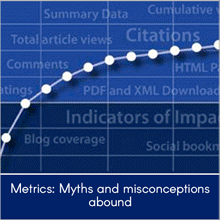
On 20 June 2019, Clarivate Analytics released the latest Journal Citation Reports® including impact factors for journals on Web of Science. (The South African Journal of Science impact factor is 1.35.) Despite immense criticism of the misrepresentation of a journal impact factor as an indicator of quality, and initiatives such as DORA (the San Francisco Declaration on Research Assessment) and the Leiden Manifesto, the impact factor remains supreme in the minds and in the publishing practices of academics. In the current ‘publish or perish’ climate, reliance on citation-based metrics may lead to the manipulation of these metrics, as Crous cautions in a Commentary in this issue. Crous describes four possible scenarios in which authors may actively manage (or mismanage) their metrics. The conclusion is that ‘we should consider eliminating quantitative performance measures altogether’. However, some objective evaluation of impact – whether individually or collectively – is an important measure of the value of the work of an individual, journal, or institution. In a Research Article in this issue, Kerchhoff and colleagues evaluated 20 years (1995–2015) of research output of the Institute for Poverty, Land and Agrarian Studies (PLAAS) using bibliometrics and altmetrics, and concluded that these analyses ‘can yield a rich picture of output and significance, providing insight into the patterns of scholarly communication’. Also in this issue, Raju and colleagues report on a multiple metrics analysis of discoverability and accessibility of scholarship in the South African Journal of Library and Information Science (2012–2017) and emphasise ‘the need to use multiple metrics for objective evaluation of the discoverability and accessibility of the scholarly content of a journal’. Although the global trend has become a suite of metrics, rather than a single measure, there will never be a metric that is not open to misuse. As proposed in a recent comment in Nature (2019;569:622), it is the responsibility of all to ensure the justification and contextualisation of any indicator and education on the use thereof.
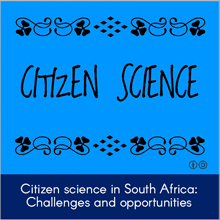 Opportunity exists in South Africa to initiate citizen science projects and to encourage increased support for the establishment and sustainability of these projects. There is growing recognition of the power of citizen science as a research approach. ‘Citizen science’ is the term for research that engages non-scientists in the collection and generation of data, be it for research or educational purposes. Hulbert and colleagues, themselves practitioners of citizen science programmes, share their perspectives on challenges and solutions to establishing and sustaining citizen science projects in South Africa, using three citizen science projects as case studies. They provide recommendations for others interested in initiating citizen science projects in South Africa and invite additional dialogue through an online community group.
Opportunity exists in South Africa to initiate citizen science projects and to encourage increased support for the establishment and sustainability of these projects. There is growing recognition of the power of citizen science as a research approach. ‘Citizen science’ is the term for research that engages non-scientists in the collection and generation of data, be it for research or educational purposes. Hulbert and colleagues, themselves practitioners of citizen science programmes, share their perspectives on challenges and solutions to establishing and sustaining citizen science projects in South Africa, using three citizen science projects as case studies. They provide recommendations for others interested in initiating citizen science projects in South Africa and invite additional dialogue through an online community group.
An estimated R166 billion is spent annually in South Africa to combat or prevent corrosion. About 15–35% of this cost might be saved through effective preventation. Janse van Rensburg and colleagues present a new corrosion map of South Africa’s inland and coastal areas. The map facilitates the identification of South Africa’s least to most corrosive environments, enabling the selection of more appropriate corrosion protection solutions for general, business, mining and industrial installations.
 Although rooibos has been shown to confer cardioprotection in diabetic cardiomyopathy and myocardial ischaemic injury, as well as to reduce the risk of cardiovascular disease, it is not yet recognised as a treatment for cardiac disease. This is mainly because the underlying mechanisms for rooibos-induced cardioprotection have not been fully elucidated. Maarman reviews the literature and postulates a potential mechanism of action.
Although rooibos has been shown to confer cardioprotection in diabetic cardiomyopathy and myocardial ischaemic injury, as well as to reduce the risk of cardiovascular disease, it is not yet recognised as a treatment for cardiac disease. This is mainly because the underlying mechanisms for rooibos-induced cardioprotection have not been fully elucidated. Maarman reviews the literature and postulates a potential mechanism of action.
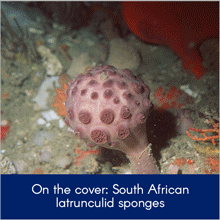 Marine sponges are the source of a diverse array of organic chemical compounds. A small number of sponge natural products has shown potential as new pharmaceuticals such as novel anti-cancer drugs. South Africa is a global hotspot of latrunculid sponge biodiversity. Research into the taxonomy, chemistry and microbiology of latrunculid sponges is the most comprehensive and multidisciplinary investigation of any group of African marine sponges. Davies-Coleman and colleagues review the multidisciplinary latrunculid sponge research undertaken unabated for more than a quarter of a century by Rhodes University, the Department of Environmental Affairs and the University of the Western Cape, as part of a collaborative marine biodiscovery programme. Their review highlights the importance of conserving and protecting South Africa’s unique marine invertebrate resources.
Marine sponges are the source of a diverse array of organic chemical compounds. A small number of sponge natural products has shown potential as new pharmaceuticals such as novel anti-cancer drugs. South Africa is a global hotspot of latrunculid sponge biodiversity. Research into the taxonomy, chemistry and microbiology of latrunculid sponges is the most comprehensive and multidisciplinary investigation of any group of African marine sponges. Davies-Coleman and colleagues review the multidisciplinary latrunculid sponge research undertaken unabated for more than a quarter of a century by Rhodes University, the Department of Environmental Affairs and the University of the Western Cape, as part of a collaborative marine biodiscovery programme. Their review highlights the importance of conserving and protecting South Africa’s unique marine invertebrate resources.
Caption: Tsitsikamma pedunculata – a South African latrunculid marine sponge species (image: Patrick L. Colin and
Lori Jane Bell Colin, Coral Reef Research Foundation).
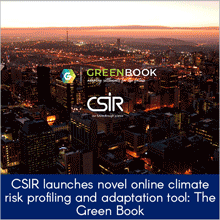 The Green Book – a free online climate risk profiling and adaptation tool – provides scientific evidence in an accessible format to local governments in South Africa to aid long-term planning towards more climate-resilient human settlements. Knowing what climate impacts to expect in future, and how to adapt for them, is of critical importance to decision-makers in this field. More than 50 researchers collaborated in developing the Green Book, which is the first of its kind for Africa. Recently launched by the CSIR, the Green Book provides information to all South African municipalities about their current and future climate change risks, and offers solutions in adapting settlements to the impacts of climate change. Water receives special attention, because it is both a scarce resource and a hazard that threatens settlements. The Green Book is available at www.greenbook.co.za.
The Green Book – a free online climate risk profiling and adaptation tool – provides scientific evidence in an accessible format to local governments in South Africa to aid long-term planning towards more climate-resilient human settlements. Knowing what climate impacts to expect in future, and how to adapt for them, is of critical importance to decision-makers in this field. More than 50 researchers collaborated in developing the Green Book, which is the first of its kind for Africa. Recently launched by the CSIR, the Green Book provides information to all South African municipalities about their current and future climate change risks, and offers solutions in adapting settlements to the impacts of climate change. Water receives special attention, because it is both a scarce resource and a hazard that threatens settlements. The Green Book is available at www.greenbook.co.za.
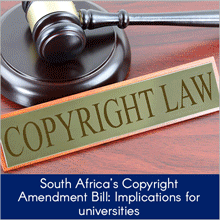 Who benefits from the Copyright Amendment Bill? Big tech? Students, universities, publishers or the national economy? In the wake of South Africa’s National Council of Provinces approval of the Copyright Amendment Bill (2018), Tomaselli examined the implications of the Bill for academics and universities, in the context of research, plagiarism and publication funding. He argues that the Bill’s extended version of fair use over-balances users’ rights in comparison with authors’ rights: scholarly works and textbooks may be freely copied, digitised, posted online and widely distributed without either the authors’ or publisher’s permission. Moreover, users may also change copied material to create new work of their own. When this happens, it is the author, not the reader, who pays the price. New legislation is often introduced with good intentions, but then becomes waylaid, as was the case with the Protection of State Information Bill. Intended to consolidate existing legislation into a single omnibus compilation, it became a ‘Secrecy Bill’ and was never implemented.
Who benefits from the Copyright Amendment Bill? Big tech? Students, universities, publishers or the national economy? In the wake of South Africa’s National Council of Provinces approval of the Copyright Amendment Bill (2018), Tomaselli examined the implications of the Bill for academics and universities, in the context of research, plagiarism and publication funding. He argues that the Bill’s extended version of fair use over-balances users’ rights in comparison with authors’ rights: scholarly works and textbooks may be freely copied, digitised, posted online and widely distributed without either the authors’ or publisher’s permission. Moreover, users may also change copied material to create new work of their own. When this happens, it is the author, not the reader, who pays the price. New legislation is often introduced with good intentions, but then becomes waylaid, as was the case with the Protection of State Information Bill. Intended to consolidate existing legislation into a single omnibus compilation, it became a ‘Secrecy Bill’ and was never implemented.
Caption: Nick Youngson CC BY-SA 3.0 Alpha Stock Images
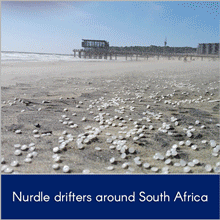 Microplastics are increasingly recognised as a major threat to life and ecological integrity in the world’s oceans, with a focus on understanding plastic input, breakdown effects and distribution pathways. A major spill of nurdles in Durban Harbour in October 2017 provided an unexpected opportunity to track billions of these flat 5-mm discs made of plastic. The event was recognised to be a major pollution incident, but despite extensive efforts made to collect the nurdles, 9 months later less than 20% of them had been recovered. Assisted by the strongly flowing Agulhas Current, within a mere 2 months, the nurdles dispersed along more than 2000 km of coastline where they washed up on beaches and were reported by the public. Schumann and colleagues reconstructed the conditions and factors in this dispersal over such a distance in a relatively short period. They found that the nurdles were entrained in certain coastal areas for long periods but were rapidly transported farther afield when sustained winds blew Theses findings have important implications for the dispersal behaviours and strategies that are adopted by larval stages of marine organisms, and provide important insights into population connectivity.
Microplastics are increasingly recognised as a major threat to life and ecological integrity in the world’s oceans, with a focus on understanding plastic input, breakdown effects and distribution pathways. A major spill of nurdles in Durban Harbour in October 2017 provided an unexpected opportunity to track billions of these flat 5-mm discs made of plastic. The event was recognised to be a major pollution incident, but despite extensive efforts made to collect the nurdles, 9 months later less than 20% of them had been recovered. Assisted by the strongly flowing Agulhas Current, within a mere 2 months, the nurdles dispersed along more than 2000 km of coastline where they washed up on beaches and were reported by the public. Schumann and colleagues reconstructed the conditions and factors in this dispersal over such a distance in a relatively short period. They found that the nurdles were entrained in certain coastal areas for long periods but were rapidly transported farther afield when sustained winds blew Theses findings have important implications for the dispersal behaviours and strategies that are adopted by larval stages of marine organisms, and provide important insights into population connectivity.
Caption: Nurdles on South Beach, Durban, South Africa (photo: Omar Parak)
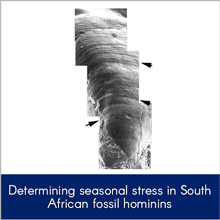 Two South African fossil hominin species – Homo naledi and Australopithecus africanus – both show signs of having experienced semi-annual seasonal stress, possibly attributed to disease and malnutrition. Physiological stress experienced in childhood can be evidenced as visible furrows in teeth, which are preserved in fossil teeth, and dated with a precision of about 1 week because of the way that tooth enamel is deposited. Skinner reconstructed the timing of this stress in fossil teeth of H. naledi and A. africanus using high-resolution scanning electron microscopy of the outer enamel surface. Homo naledi, a mid-Pleistocene hominin, and Late Pliocene Australopithecus africanus were discovered in the same geographical area, thus allowing for comparison of the timing of their developmental stress. Surprisingly, as this area shows strong seasonality with a single annual moisture cycle, stress in these individuals recurred on average semi-annually. Skinner tentatively attributes this finding to two independent annual cycles, possibly disease and malnutrition.
Two South African fossil hominin species – Homo naledi and Australopithecus africanus – both show signs of having experienced semi-annual seasonal stress, possibly attributed to disease and malnutrition. Physiological stress experienced in childhood can be evidenced as visible furrows in teeth, which are preserved in fossil teeth, and dated with a precision of about 1 week because of the way that tooth enamel is deposited. Skinner reconstructed the timing of this stress in fossil teeth of H. naledi and A. africanus using high-resolution scanning electron microscopy of the outer enamel surface. Homo naledi, a mid-Pleistocene hominin, and Late Pliocene Australopithecus africanus were discovered in the same geographical area, thus allowing for comparison of the timing of their developmental stress. Surprisingly, as this area shows strong seasonality with a single annual moisture cycle, stress in these individuals recurred on average semi-annually. Skinner tentatively attributes this finding to two independent annual cycles, possibly disease and malnutrition.
Caption: Upper right lateral incisor of Australopithecus africanus showing normal enamel increments and three pronounced furrows (arrows) attributed to developmental stress.
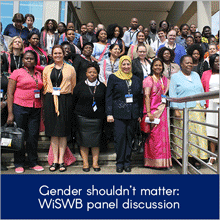
The theme of this issue of the South African Journal of Science is ‘Women in Science’ and emanates from the Second International Women in Science Without Borders (WiSWB) conference held in Johannesburg in March 2018. The aim of this annual conference is to highlight research done by women, and particularly to emphasise the contributions of women within the science, technology, engineering, mathematics, medicine and innovation (STEMMI) ecosystem to effect positive outcomes. The 2018 WiSWB conference – the title of which was ‘Resilience in Diversity – was also an opportunity to focus on transdisciplinary issues with an Africa-wide urgency, among them, institutional capacity development, inclusive sustainable growth, and regional integration. The conference submissions were divided into interdisciplinary categories and were wide-ranging: Clean Energy, Climate Change, Digital Revolution, Disaster Management, Education and Outreach, Food Security, Gender Studies, Health, Industrialisation, Science Diplomacy, Smart Cities, and Water.

In this issue, the submission data analysed by John and Das demonstrate that more than half (53%) of authors who submitted conference abstracts were from Nigeria and, although the conference was gender-inclusive, most of the first authors were women. Their analysis also shows that most of the authors, as well as most of the female authors, had a postgraduate qualification and fell within the age cohort 30–45. Health had the largest number of conference submissions (26%), followed by Food Security (17%). These two issues were addressed by half of the 27 countries represented – an indication of the urgency of these topics for our continent. The trend in South African papers was similar, although Clean Energy was more prevalent with Food Security less so.
One South African submission relating to health – the full paper of which is published in this issue – is that by Grant and colleagues. They studied the combination of immunohistochemistry and microarray gene profiling for subtyping breast cancers in order to optimise individualised treatment. Another submission from South Africa, also published in this issue, deals with the critical topic of water. Nibamureke and colleagues assessed the potential effects on the growth of fish from nevirapine (an HIV antiretroviral) that ends up in surface water in South Africa.
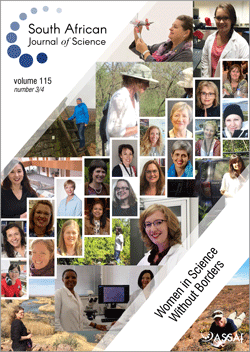
Despite the gains of the conference, the low participation of women in many fields of science remains a subject of global concern. Gledhill and colleagues report on the Gender Gap project, which was initiated in 2016 and will conclude this year. The aim of the project is to provide a global data set on the experiences of both women and men in science, on which, it is hoped, positive interventions can be based. As Prozesky and Mouton’s paper shows, the experiences of women scientists are different from what might be expected. Contrary to expectations, in a web-based survey of 5000 scientists born and living in Africa, Prozesky and Mouton found that women do not report experiencing career challenges to any greater extent than do men. The work shows that the priority should be on addressing the conflict between the roles of work and family, because this is the sole challenge women are more likely to have experienced than men, and the one most frequently experienced by women. Moreover, because this challenge is rooted in systemic social inequities it cannot be addressed through providing material resources alone.
There are other social and cultural gender inequities. Van Staden and colleagues highlight the gender wage gap, the need for encouragement and, importantly, the need to have women in science.
In keeping with the theme, an Invited Commentary is on the history of mathematics, contributed by Tomoko Kitigawa, who, in 2015, was voted ‘one of the most amazing women in Japan’.
Of the authors of all the research papers published in this SAJS issue, 58% are women. They can all be seen on the cover of this issue.
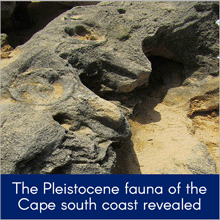
East of Still Bay on the Cape south coast of South Africa lies a rugged, remote stretch of sea cliffs that expose Late Pleistocene aeolianites (or cemented dunes). The first South African record of elephant tracks, the first rhinoceros tracks, and the first giant Cape horse tracks were recorded from two rocks in this area: Roberts Rock and Megafauna Rock. Among the fossil tracks on these rocks, Helm and colleagues have recorded track evidence of the long-horned buffalo and smaller species. Two of the species recorded are now extinct (the giant Cape horse and long-horned buffalo). These rocks provide a glimpse into Late Pleistocene dune life, and suggest an area that was teeming with large mammals. Roberts Rock has since slumped into the ocean and disintegrated – the fate of many exposed tracksites. For this reason, and because new sites frequently become exposed, regular surveying of this track-rich coastline is necessary.
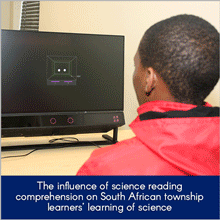 Interventions aimed at improving science knowledge of learners in South Africa will continue to fail if their reading comprehension skills are under-developed. In an attempt to understand why previous science interventions for township learners had helped only some learners, Stott and Beelders assessed the relationships between learners’ reading comprehension and their Natural Science marks and improvement from intervention programmes. Using an eye tracker to observe the eye movements of learners engaging with science software, Stott and Beelder observed that the majority of learners guessed at least some answers without reading, with some avoiding any, or much, of the required reading. They found moderate to strong correlations between the learners’ inferred ability to read science texts with comprehension and both their Natural Science marks and the benefit they gained from previous interventions. The findings suggest that only top achieving township learners possess the reading comprehension skills to benefit from interventions which rely on text usage.
Interventions aimed at improving science knowledge of learners in South Africa will continue to fail if their reading comprehension skills are under-developed. In an attempt to understand why previous science interventions for township learners had helped only some learners, Stott and Beelders assessed the relationships between learners’ reading comprehension and their Natural Science marks and improvement from intervention programmes. Using an eye tracker to observe the eye movements of learners engaging with science software, Stott and Beelder observed that the majority of learners guessed at least some answers without reading, with some avoiding any, or much, of the required reading. They found moderate to strong correlations between the learners’ inferred ability to read science texts with comprehension and both their Natural Science marks and the benefit they gained from previous interventions. The findings suggest that only top achieving township learners possess the reading comprehension skills to benefit from interventions which rely on text usage.
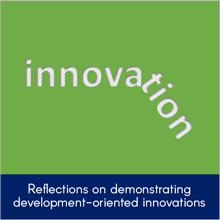 South Africa is intent on promoting its science, technology and innovation (STI) capabilities to achieve improved socio-economic development outcomes. Recent practical work has included the demonstration of innovations in relatively remote rural areas to encourage inclusive development in line with the National Development Plan. These innovations include water, sanitation and energy technologies, often combined with information and communication technologies (ICT). Drawing on the experiences of the multiple actors involved, Hart and colleagues identified key challenges in the demonstration process as limited beneficiary participation; haphazard needs assessments; top-down beneficiary, site and technology selection; and a lack of necessary ICT infrastructure. The process was further complicated by different priorities of national and local stakeholders, and vast distances that personnel and materials had to travel. A well-considered process of demonstration planning and implementation could reduce some of these challenges. Innovation demonstrations are an important means of first-time testing and fine-tuning innovations outside of the laboratory through which the focus is shifted from research to acceptability, usability and value. Usefulness will not simply follow because the technical aspects of the innovation have been met.
South Africa is intent on promoting its science, technology and innovation (STI) capabilities to achieve improved socio-economic development outcomes. Recent practical work has included the demonstration of innovations in relatively remote rural areas to encourage inclusive development in line with the National Development Plan. These innovations include water, sanitation and energy technologies, often combined with information and communication technologies (ICT). Drawing on the experiences of the multiple actors involved, Hart and colleagues identified key challenges in the demonstration process as limited beneficiary participation; haphazard needs assessments; top-down beneficiary, site and technology selection; and a lack of necessary ICT infrastructure. The process was further complicated by different priorities of national and local stakeholders, and vast distances that personnel and materials had to travel. A well-considered process of demonstration planning and implementation could reduce some of these challenges. Innovation demonstrations are an important means of first-time testing and fine-tuning innovations outside of the laboratory through which the focus is shifted from research to acceptability, usability and value. Usefulness will not simply follow because the technical aspects of the innovation have been met.
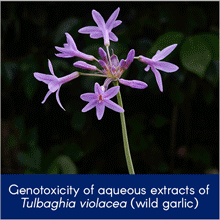 Traditional medicines should undergo testing before they are administered to patients. Traditional healing is now legally recognised in South Africa and the safety of traditional medicines is thus a priority. Madike and colleagues tested aqueous extracts of wild garlic (Tulbaghia violacea) – a common plant used by traditional health practitioners to treat various ailments – and found negative effects on cell division and growth. Information about the healing properties of T. violacea is usually passed on from one generation to the next without any scientific evidence available on this plant and its potential dangers. Madike and colleagues obtained extracts from the leaves, stems and roots of T. violacea and tested the effects of different concentrations on the growth of onion cells. The effect of these extracts on onion cells is similar to what would occur in human cells. They found that high concentrations of plant extracts caused damage to the chromosomes of cells.
Traditional medicines should undergo testing before they are administered to patients. Traditional healing is now legally recognised in South Africa and the safety of traditional medicines is thus a priority. Madike and colleagues tested aqueous extracts of wild garlic (Tulbaghia violacea) – a common plant used by traditional health practitioners to treat various ailments – and found negative effects on cell division and growth. Information about the healing properties of T. violacea is usually passed on from one generation to the next without any scientific evidence available on this plant and its potential dangers. Madike and colleagues obtained extracts from the leaves, stems and roots of T. violacea and tested the effects of different concentrations on the growth of onion cells. The effect of these extracts on onion cells is similar to what would occur in human cells. They found that high concentrations of plant extracts caused damage to the chromosomes of cells.
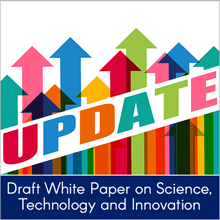 South Africa’s science, technology and innovation policy is being updated at a time when the need to provide economic leadership is a critical imperative. The 2018 White Paper on Science, Technology and Innovation sets out the principles for the institutional, regulatory and financial architecture of the future science, technology and innovation system within South Africa. The draft document is clear on its intent: it seeks a system which is bigger, more inclusive and has greater economic impact. None of these objectives is new or controversial; the problem has been the achievement thereof. Walwyn and Cloete argue that South Africa is likely to continue to fail in these objectives unless more emphasis is placed on human capability, institutional reform, sustainability and policy experimentation. Moreover, a more convincing theory of change is needed that will persuade politicians and the public of the urgency for increased spending on research and development as a means of lifting the country out of its economic depression.
South Africa’s science, technology and innovation policy is being updated at a time when the need to provide economic leadership is a critical imperative. The 2018 White Paper on Science, Technology and Innovation sets out the principles for the institutional, regulatory and financial architecture of the future science, technology and innovation system within South Africa. The draft document is clear on its intent: it seeks a system which is bigger, more inclusive and has greater economic impact. None of these objectives is new or controversial; the problem has been the achievement thereof. Walwyn and Cloete argue that South Africa is likely to continue to fail in these objectives unless more emphasis is placed on human capability, institutional reform, sustainability and policy experimentation. Moreover, a more convincing theory of change is needed that will persuade politicians and the public of the urgency for increased spending on research and development as a means of lifting the country out of its economic depression.
 How can innovative development pathways reduce inequality and greenhouse gas emissions? Reducing inequality is our top priority in national development, while climate change is the foremost global challenge of this century. Winkler proposes that a comprehensive theoretical framework is needed to lead the way to a low-carbon high-equity future. Charting innovative development pathways requires changes in policy, technology and investment. But perhaps more fundamentally, it requires an understanding of the complex determinants and agents of change, followed by adaptive management of complex systems. Such complexity requires radically inter- and trans-disciplinary research, to inform adaptive management. Co-production of knowledge and learning by doing will be important. Young people need key skills in thinking about intervening in systems: complex problem-solving, critical thinking and creativity. What is needed is a new social contract, in which the rich live better with less, the poor are lifted out of poverty, and middle-class aspirations shift from having more to living well.
How can innovative development pathways reduce inequality and greenhouse gas emissions? Reducing inequality is our top priority in national development, while climate change is the foremost global challenge of this century. Winkler proposes that a comprehensive theoretical framework is needed to lead the way to a low-carbon high-equity future. Charting innovative development pathways requires changes in policy, technology and investment. But perhaps more fundamentally, it requires an understanding of the complex determinants and agents of change, followed by adaptive management of complex systems. Such complexity requires radically inter- and trans-disciplinary research, to inform adaptive management. Co-production of knowledge and learning by doing will be important. Young people need key skills in thinking about intervening in systems: complex problem-solving, critical thinking and creativity. What is needed is a new social contract, in which the rich live better with less, the poor are lifted out of poverty, and middle-class aspirations shift from having more to living well.
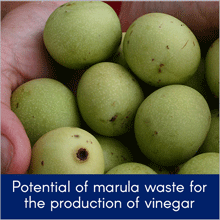 Marula vinegar produced from waste by-products was found to be a potential source of health promoting compounds including total phenolics and flavonoids with good antioxidant properties. Marula is a well-known indigenous plant in South Africa, and the fruit is used to make the legendary Amarula cream liquor. Molelekoa and colleagues investigated the feasibility of using marula fruit waste sourced from a processing plant as feedstock for vinegar (acetic acid) production. They used two fermentation techniques (surface and submerged culture methods) using both naturally occurring and inoculated bacteria. The surface culture method combined with inoculation produced a higher-quality vinegar with potential for commercial-scale production. A consumer survey recommended the application of the vinegar in products such as salad dressing and mayonnaise.
Marula vinegar produced from waste by-products was found to be a potential source of health promoting compounds including total phenolics and flavonoids with good antioxidant properties. Marula is a well-known indigenous plant in South Africa, and the fruit is used to make the legendary Amarula cream liquor. Molelekoa and colleagues investigated the feasibility of using marula fruit waste sourced from a processing plant as feedstock for vinegar (acetic acid) production. They used two fermentation techniques (surface and submerged culture methods) using both naturally occurring and inoculated bacteria. The surface culture method combined with inoculation produced a higher-quality vinegar with potential for commercial-scale production. A consumer survey recommended the application of the vinegar in products such as salad dressing and mayonnaise.
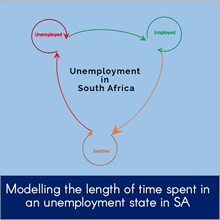 Unemployment exit rate, job sustainability and unemployment duration collectively affect the persistence of unemployment. Modelling the relationships among these factors is recommended for finding solutions to unemployment issues. Nonyana and Njuho explored the benefits of using econometric models in unpacking features of unemployment in South Africa. Using these models they found that unemployed people in South Africa tend to have lower unemployment exit rates; which relates to job scarcity in the labour market, whilst available jobs are less sustainable and the bulk of those who are employed are likely to lose their jobs within a year. Unemployment duration featured as a structural factor that has a considerable impact on unemployment: the longer the unemployed remain unemployed, their prospect of finding employment deteriorates.
Unemployment exit rate, job sustainability and unemployment duration collectively affect the persistence of unemployment. Modelling the relationships among these factors is recommended for finding solutions to unemployment issues. Nonyana and Njuho explored the benefits of using econometric models in unpacking features of unemployment in South Africa. Using these models they found that unemployed people in South Africa tend to have lower unemployment exit rates; which relates to job scarcity in the labour market, whilst available jobs are less sustainable and the bulk of those who are employed are likely to lose their jobs within a year. Unemployment duration featured as a structural factor that has a considerable impact on unemployment: the longer the unemployed remain unemployed, their prospect of finding employment deteriorates.
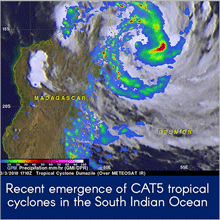 Tropical cyclone Dineo made news headlines across southern Africa in early 2016, although it was only a category 1 storm. Tropical cyclones are devastating storm systems, characterised by strong winds, heavy rainfall and storm surge flooding in coastal areas, and are classified according to intensity from category 1 (mild) to category 5 (devastating). Since 1994 – when the first tropical cyclone in the South Indian Ocean intensified to category 5 status – the number of category 5 storms in the South Indian Ocean has increased steadily each decade. Fitchett has found that the incidence of a category 5 tropical cyclone, and subsequent increase in frequency of these highest intensity storms, appears to be linked to ocean warming, as sea surface temperatures of 27–29°C are being experienced progressively further south. Category 5 storms have been recorded for the North Atlantic Ocean since 1924, but were not a feature of the South Indian Ocean for many decades.
Tropical cyclone Dineo made news headlines across southern Africa in early 2016, although it was only a category 1 storm. Tropical cyclones are devastating storm systems, characterised by strong winds, heavy rainfall and storm surge flooding in coastal areas, and are classified according to intensity from category 1 (mild) to category 5 (devastating). Since 1994 – when the first tropical cyclone in the South Indian Ocean intensified to category 5 status – the number of category 5 storms in the South Indian Ocean has increased steadily each decade. Fitchett has found that the incidence of a category 5 tropical cyclone, and subsequent increase in frequency of these highest intensity storms, appears to be linked to ocean warming, as sea surface temperatures of 27–29°C are being experienced progressively further south. Category 5 storms have been recorded for the North Atlantic Ocean since 1924, but were not a feature of the South Indian Ocean for many decades.
 Antibiotic resistance is a threat to South Africa’s healthcare system, for which there is an urgent need to enforce legislation on drug distribution and usage, to prioritise the use of alternatives to antibiotics and, finally, to implement a nationwide effective antimicrobial resistance surveillance system. Tatsing Foka and colleagues reviewed the incidence of vancomycin-resistant enterococci in South Africa. The recent and continuous detection of a high level of vancomycin-resistant enterococci in a variety of South African ecological niches is a serious public health concern, especially given the high incidence of immunocompromising complications such as HIV/Aids in the country. Agricultural practices coupled with the misuse of antibiotics in intensive animal rearing and hospital facilities have been identified as the main cause for the development of resistant strains in South Africa, and the world at large. The health implications of vancomycin-resistant enterococci and their resulting economic burden on our healthcare system cannot be underestimated. Although tremendous efforts have already been made in South Africa to tackle antimicrobial resistance issues, and vancomycin resistance problems in particular, results from recent studies need to be incorporated into fully modified operational policies.
Antibiotic resistance is a threat to South Africa’s healthcare system, for which there is an urgent need to enforce legislation on drug distribution and usage, to prioritise the use of alternatives to antibiotics and, finally, to implement a nationwide effective antimicrobial resistance surveillance system. Tatsing Foka and colleagues reviewed the incidence of vancomycin-resistant enterococci in South Africa. The recent and continuous detection of a high level of vancomycin-resistant enterococci in a variety of South African ecological niches is a serious public health concern, especially given the high incidence of immunocompromising complications such as HIV/Aids in the country. Agricultural practices coupled with the misuse of antibiotics in intensive animal rearing and hospital facilities have been identified as the main cause for the development of resistant strains in South Africa, and the world at large. The health implications of vancomycin-resistant enterococci and their resulting economic burden on our healthcare system cannot be underestimated. Although tremendous efforts have already been made in South Africa to tackle antimicrobial resistance issues, and vancomycin resistance problems in particular, results from recent studies need to be incorporated into fully modified operational policies.
![]() Nnadih and colleagues report the first ground-based recorded observations of sprites over South Africa. Sprites – named after the characters in Shakespeare’s The Tempest – are electrical discharges in the mesosphere above an active thunderstorm that are powered by large lightning strikes, but are rarely visible from the ground. Sprites have been studied extensively in other continents, but despite Africa being a lightning-rich continent, there is little or no active sprite-related research in Africa. Their study enables us to understand the interconnected processes of atmospheric electricity and terrestrial weather. The phenomenon was reported anecdotally in Johannesburg in 1937, but Nnadih et al.’s report is the first record of sprites in southern Africa. On 2 of 22 nights of observations, they recorded about 100 sprite elements from Sutherland in the Northern Cape, comprising different morphologies (55% were carrot-shaped sprites). The sprites were triggered by positive cloud-to-ground lightning strikes and were observed from distances of between 400 and 800 km. These first ground-based observations, which suggest that the optical intensity of sprites is proportional to the lightning stroke current, will pave the way for a more comprehensive study of sprites in South Africa.
Nnadih and colleagues report the first ground-based recorded observations of sprites over South Africa. Sprites – named after the characters in Shakespeare’s The Tempest – are electrical discharges in the mesosphere above an active thunderstorm that are powered by large lightning strikes, but are rarely visible from the ground. Sprites have been studied extensively in other continents, but despite Africa being a lightning-rich continent, there is little or no active sprite-related research in Africa. Their study enables us to understand the interconnected processes of atmospheric electricity and terrestrial weather. The phenomenon was reported anecdotally in Johannesburg in 1937, but Nnadih et al.’s report is the first record of sprites in southern Africa. On 2 of 22 nights of observations, they recorded about 100 sprite elements from Sutherland in the Northern Cape, comprising different morphologies (55% were carrot-shaped sprites). The sprites were triggered by positive cloud-to-ground lightning strikes and were observed from distances of between 400 and 800 km. These first ground-based observations, which suggest that the optical intensity of sprites is proportional to the lightning stroke current, will pave the way for a more comprehensive study of sprites in South Africa.
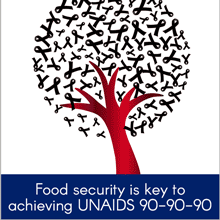 The goal to end AIDS as a global pandemic by 2030 is threatened if, as this study suggests, one-third of adults presenting for HIV counselling and testing at healthcare clinics in South Africa come from households with insufficient food. In a study of over 2700 adult women and men presenting for HIV testing at three public sector healthcare clinics in eThekwini (Durban metropolitan region), Nyirenda and colleagues found that individuals from food-insecure households were more likely to test HIV positive than those from food-secure households. Although the reason for this association was not evident, the results highlight that many newly diagnosed HIV-positive individuals do not have enough to eat. Their findings support the need for socio-economic and structural interventions to transform food-insecure into food-secure households. Failure to do so urgently in high HIV endemic areas like KwaZulu-Natal, South Africa, is likely to seriously challenge the attainment of global targets such as the UNAIDS’ 90-90-90 goal.
The goal to end AIDS as a global pandemic by 2030 is threatened if, as this study suggests, one-third of adults presenting for HIV counselling and testing at healthcare clinics in South Africa come from households with insufficient food. In a study of over 2700 adult women and men presenting for HIV testing at three public sector healthcare clinics in eThekwini (Durban metropolitan region), Nyirenda and colleagues found that individuals from food-insecure households were more likely to test HIV positive than those from food-secure households. Although the reason for this association was not evident, the results highlight that many newly diagnosed HIV-positive individuals do not have enough to eat. Their findings support the need for socio-economic and structural interventions to transform food-insecure into food-secure households. Failure to do so urgently in high HIV endemic areas like KwaZulu-Natal, South Africa, is likely to seriously challenge the attainment of global targets such as the UNAIDS’ 90-90-90 goal.
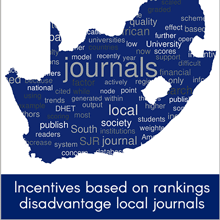
Local journals face a difficult task: escaping the ‘impact factor trap’ by attracting good research away from international journals; a task which will be made impossible by graded national financial incentives. Although the Department of Higher Education and Training does not differentiate between national and international publications with respect to subsidy for journals on accredited lists, some local universities award a higher proportion of the subsidy to authors who publish in international journals. There is pressure throughout academia to publish in high impact factor journals. The Scimago Journal Rank is an index that ranks journals based on impact and prestige, partly by measuring from where citations come. Lee and Simon examined 23 000 journals listed in the Scimago database, which included only 82 South African journals. They argue that this index is not suitable for Africa, as journals with Africa in their title are ranked lower than other journals by this index. They assert that African journals have not yet had the time required to gain the same prestige, as historically they have had low visibility. Applying incentives based on Scimago Journal Rank will therefore disadvantage local journals.
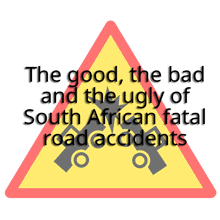 Awareness campaigns alone may not be sufficient to reduce the number of accidents on South African roads. Introducing compulsory third-party insurance and the imminent emergence of self-driving cars may have an impact. According to Fourie and Verster, human factors contributed to almost 80% of the fatal road accidents in South Africa in 2015, with road and environmental conditions contributing to 13% and vehicle factors to 8%. Fourie and Verster analysed the fatal road accidents – those in which at least one person is killed as a direct result of the accident – in South Africa in 2015. Although fatal accidents constituted only 1.3% of all road accidents, they equated to 42% of the total costs involved. The economic cost – R143 billion in 2015 – is not the only cost: 13 000 lives were lost in 2015 as a result of road accidents. Pedestrians accounted for 38% of the fatalities and male individuals 78%, with 41% of those killed being younger than 30 years old.
Awareness campaigns alone may not be sufficient to reduce the number of accidents on South African roads. Introducing compulsory third-party insurance and the imminent emergence of self-driving cars may have an impact. According to Fourie and Verster, human factors contributed to almost 80% of the fatal road accidents in South Africa in 2015, with road and environmental conditions contributing to 13% and vehicle factors to 8%. Fourie and Verster analysed the fatal road accidents – those in which at least one person is killed as a direct result of the accident – in South Africa in 2015. Although fatal accidents constituted only 1.3% of all road accidents, they equated to 42% of the total costs involved. The economic cost – R143 billion in 2015 – is not the only cost: 13 000 lives were lost in 2015 as a result of road accidents. Pedestrians accounted for 38% of the fatalities and male individuals 78%, with 41% of those killed being younger than 30 years old.
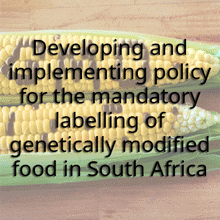 Bt modification in maize does not affect non-target beneficial microorganisms such as endophytes. Although Bt maize is one of the most popular GM crops in the world, little is known about potential impacts on ecosystem functionalities. Genetically modified Bt maize contains a gene from the soil bacterium Bacillus thuringiensis (Bt) which provides resistance to major insect pests. Mashiane and colleagues investigated whether genetic modification affected non-target microorganisms such as endophytic bacteria which are important in agriculture. Maize is one of the most important crops in the world – it is consumed as a staple food and as animal feed in both developing and developed countries. Bacterial endophytes from two developmental stages of both Bt maize and its isogenic parental line were screened for their capabilities to participate in plant protection, nutrient mobilisation as well as production of a plant growth hormone. Interestingly, Mashiane and colleagues found that growth stage rather than genetic modification had a significant impact on the endophytes and their functions.
Bt modification in maize does not affect non-target beneficial microorganisms such as endophytes. Although Bt maize is one of the most popular GM crops in the world, little is known about potential impacts on ecosystem functionalities. Genetically modified Bt maize contains a gene from the soil bacterium Bacillus thuringiensis (Bt) which provides resistance to major insect pests. Mashiane and colleagues investigated whether genetic modification affected non-target microorganisms such as endophytic bacteria which are important in agriculture. Maize is one of the most important crops in the world – it is consumed as a staple food and as animal feed in both developing and developed countries. Bacterial endophytes from two developmental stages of both Bt maize and its isogenic parental line were screened for their capabilities to participate in plant protection, nutrient mobilisation as well as production of a plant growth hormone. Interestingly, Mashiane and colleagues found that growth stage rather than genetic modification had a significant impact on the endophytes and their functions.
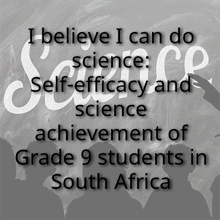 Efforts to improve performance in science should also focus on developing non-cognitive aspects such as self-efficacy. A person’s motivation and confidence can make seemingly impossible tasks possible. This self confidence in one’s ability (self-efficacy) extends to performing science-related tasks in the classroom. The strength of this belief has an impact on behaviour – those who have higher self-efficacy are more likely to persevere in an activity, no matter how difficult, until they succeed. Using information from 12 500 Grade 9 students in South Africa, Juan and colleagues found a positive relationship between self-efficacy and science achievement. In addition, positive student–parent and student–teacher interactions were related to increases in students’ science self-efficacy. Of concern was the finding that girls reported lower self-efficacy than boys, even when they scored the same on the science assessment.
Efforts to improve performance in science should also focus on developing non-cognitive aspects such as self-efficacy. A person’s motivation and confidence can make seemingly impossible tasks possible. This self confidence in one’s ability (self-efficacy) extends to performing science-related tasks in the classroom. The strength of this belief has an impact on behaviour – those who have higher self-efficacy are more likely to persevere in an activity, no matter how difficult, until they succeed. Using information from 12 500 Grade 9 students in South Africa, Juan and colleagues found a positive relationship between self-efficacy and science achievement. In addition, positive student–parent and student–teacher interactions were related to increases in students’ science self-efficacy. Of concern was the finding that girls reported lower self-efficacy than boys, even when they scored the same on the science assessment.
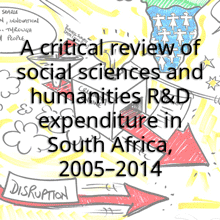 South Africa nearly doubled its R&D expenditure in social sciences and humanities research fields between 2005 and 2014, outpacing countries such as Russia, Turkey and Uruguay. A closer look at the data, however, suggests that R&D expenditure was mainly concentrated in a few research fields – finance, economics, education, accounting and political science. Intense global environmental and technological changes, coupled by critical levels of poverty and inequality in South Africa, are key urgencies that science policymakers face in the development of the new White Paper on Science, Technology and Innovation. Within this context, the case for advancing the social sciences and humanities in South Africa could not be more urgent and compelling; although questions remain as to where to target strategic R&D investments for meaningful socio-economic and epistemic impacts. Molotja and Ralphs argue that institutional R&D planners and national policymakers need to better balance current priorities and future needs if R&D in the social sciences and humanities is to be leveraged for larger socio-economic impacts, as envisaged by the new draft White Paper on Science, Technology and Innovation.
South Africa nearly doubled its R&D expenditure in social sciences and humanities research fields between 2005 and 2014, outpacing countries such as Russia, Turkey and Uruguay. A closer look at the data, however, suggests that R&D expenditure was mainly concentrated in a few research fields – finance, economics, education, accounting and political science. Intense global environmental and technological changes, coupled by critical levels of poverty and inequality in South Africa, are key urgencies that science policymakers face in the development of the new White Paper on Science, Technology and Innovation. Within this context, the case for advancing the social sciences and humanities in South Africa could not be more urgent and compelling; although questions remain as to where to target strategic R&D investments for meaningful socio-economic and epistemic impacts. Molotja and Ralphs argue that institutional R&D planners and national policymakers need to better balance current priorities and future needs if R&D in the social sciences and humanities is to be leveraged for larger socio-economic impacts, as envisaged by the new draft White Paper on Science, Technology and Innovation.
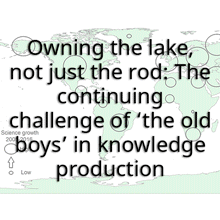 The global knowledge economy continues to be dominated by the Global North. Reasons may include a lack of proper national government support and funding and academic prowess on the part of scholars in the Global South. However, focusing on only these largely technical and economic reasons, whilst ignoring the greater cultural and political reasons within which the practice of academia is in itself deeply entrenched, limits our understanding. Dalu and colleagues consider the barriers that stem from the practice of the ‘old boys’ network’ as a possible contributor to Global South academic performance in the global knowledge economy. They contemplate the idea of monopolies of power centred in the Global North with regard to who moderates academic outputs, and how the Global South continues to uphold the standards of academic outputs as they are stipulated in the Global North. Knowledge exchange platforms between the Global North and South have developmental implications within the decolonisation agenda currently on the South African table.
The global knowledge economy continues to be dominated by the Global North. Reasons may include a lack of proper national government support and funding and academic prowess on the part of scholars in the Global South. However, focusing on only these largely technical and economic reasons, whilst ignoring the greater cultural and political reasons within which the practice of academia is in itself deeply entrenched, limits our understanding. Dalu and colleagues consider the barriers that stem from the practice of the ‘old boys’ network’ as a possible contributor to Global South academic performance in the global knowledge economy. They contemplate the idea of monopolies of power centred in the Global North with regard to who moderates academic outputs, and how the Global South continues to uphold the standards of academic outputs as they are stipulated in the Global North. Knowledge exchange platforms between the Global North and South have developmental implications within the decolonisation agenda currently on the South African table.
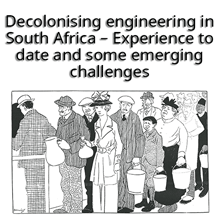 Did Cape Town’s water crisis happen because the city’s leadership thought that they lived in Europe? More generally, does the practice of applied sciences like engineering adequately reflect the South African context? These questions offer practical perspectives on the contentious debate about the decolonisation of our universities and society. There is plenty of evidence that civil engineering initially served the colonial purpose of extracting wealth; and that the exclusion of black people from the profession in South Africa and the British colonies left a legacy of damaging distrust. How can the society and its engineering professions move beyond this inheritance? As we seek an inclusive way forward, engineers must become more assertive about their role as pathfinders. They must help to engineer more effective institutions as well as physical structures and services. On the way, they will have to help politicians to learn to take advice.
Did Cape Town’s water crisis happen because the city’s leadership thought that they lived in Europe? More generally, does the practice of applied sciences like engineering adequately reflect the South African context? These questions offer practical perspectives on the contentious debate about the decolonisation of our universities and society. There is plenty of evidence that civil engineering initially served the colonial purpose of extracting wealth; and that the exclusion of black people from the profession in South Africa and the British colonies left a legacy of damaging distrust. How can the society and its engineering professions move beyond this inheritance? As we seek an inclusive way forward, engineers must become more assertive about their role as pathfinders. They must help to engineer more effective institutions as well as physical structures and services. On the way, they will have to help politicians to learn to take advice.
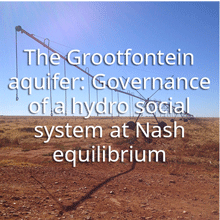 Inadequate governance of groundwater harms economic growth, food security, social stability, land reform, transformation and other sectors. Mahikeng, the capital of North West Province, depends on groundwater from nearby aquifers for more than half of its water supply, but falling groundwater levels have made this water supply less predictable and less reliable. According to Cobbing and De Wit, the groundwater aquifers near Mahikeng – if they were better managed – could help to make Mahikeng’s water supply more reliable, and less vulnerable to drought. The natural environment would also benefit, as would social stability and business confidence. The root of the problem is poor cooperation between those extracting and those controlling the groundwater, including farmers and the municipality. An undesirable “Nash” equilibrium has emerged, meaning that all the parties are currently losers. However, this sub-optimal equilibrium can be broken – there is enough water to go around, and “win-win” outcomes are possible. But the hidden cost of today’s poor management is high.
Inadequate governance of groundwater harms economic growth, food security, social stability, land reform, transformation and other sectors. Mahikeng, the capital of North West Province, depends on groundwater from nearby aquifers for more than half of its water supply, but falling groundwater levels have made this water supply less predictable and less reliable. According to Cobbing and De Wit, the groundwater aquifers near Mahikeng – if they were better managed – could help to make Mahikeng’s water supply more reliable, and less vulnerable to drought. The natural environment would also benefit, as would social stability and business confidence. The root of the problem is poor cooperation between those extracting and those controlling the groundwater, including farmers and the municipality. An undesirable “Nash” equilibrium has emerged, meaning that all the parties are currently losers. However, this sub-optimal equilibrium can be broken – there is enough water to go around, and “win-win” outcomes are possible. But the hidden cost of today’s poor management is high.
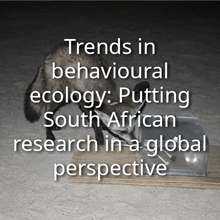 South African researchers contribute more than 3% of the global literature on mammalian behavioural ecology, with a strong focus on the broader themes of mating, social and foraging behaviour. The large number of protected areas and mammalian guilds in South Africa provide unique opportunities for the study of behavioural ecology – a sub-discipline of zoology that has evolved and grown significantly since the start of the 20th century. Researchers link behaviour to genetics, evolutionary trends, and fast adaptation to a rapidly changing world. Le Roux reviewed over 1000 papers published from 2000 to 2015 and determined the South African contributions to this multidisciplinary field. Although South African researchers contribute more than 3% of the global literature, some important themes within behavioural ecology – such as animal cognition and personalities – that are gaining rapid international traction are not studied locally.
South African researchers contribute more than 3% of the global literature on mammalian behavioural ecology, with a strong focus on the broader themes of mating, social and foraging behaviour. The large number of protected areas and mammalian guilds in South Africa provide unique opportunities for the study of behavioural ecology – a sub-discipline of zoology that has evolved and grown significantly since the start of the 20th century. Researchers link behaviour to genetics, evolutionary trends, and fast adaptation to a rapidly changing world. Le Roux reviewed over 1000 papers published from 2000 to 2015 and determined the South African contributions to this multidisciplinary field. Although South African researchers contribute more than 3% of the global literature, some important themes within behavioural ecology – such as animal cognition and personalities – that are gaining rapid international traction are not studied locally.
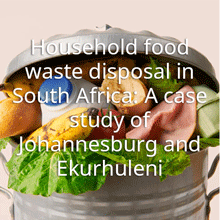 Food waste in South Africa is lower than that in Europe but greater than in the rest of sub-Saharan Africa. Households in South Africa dispose of less food into the municipal bin than European households do, but more than households in the rest of sub-Saharan Africa, excluding food fed to pets or disposed of onto compost heaps at home. Food waste is an important issue in light of population growth and global food security concerns. It is estimated that between a third and half of all food produced globally is wasted every year while 12 million people in South Africa go to bed hungry each day. Oelofse and colleagues measured the actual amount of food waste disposed of into municipal bins by households in the City of Johannesburg and Ekurhuleni. The food disposed of amounts to 12 kg per person per year in Johannesburg and 8 kg in Ekurhuleni – a contribution of about 51 000 tonnes in Johannesburg and 25 000 tonnes in Ekurhuleni to the municipal solid waste disposed of on already stressed landfills.
Food waste in South Africa is lower than that in Europe but greater than in the rest of sub-Saharan Africa. Households in South Africa dispose of less food into the municipal bin than European households do, but more than households in the rest of sub-Saharan Africa, excluding food fed to pets or disposed of onto compost heaps at home. Food waste is an important issue in light of population growth and global food security concerns. It is estimated that between a third and half of all food produced globally is wasted every year while 12 million people in South Africa go to bed hungry each day. Oelofse and colleagues measured the actual amount of food waste disposed of into municipal bins by households in the City of Johannesburg and Ekurhuleni. The food disposed of amounts to 12 kg per person per year in Johannesburg and 8 kg in Ekurhuleni – a contribution of about 51 000 tonnes in Johannesburg and 25 000 tonnes in Ekurhuleni to the municipal solid waste disposed of on already stressed landfills.
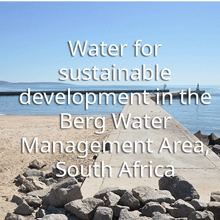 Cole et al. propose additional indicators for SDG 6 – Sustainable Development Goal 6, namely “Water and sanitation for all” – on water efficiency that focus on how individuals and households benefit from allocations and the use of water resources. Appropriate indicators can support decision-making and highlight key issues on inequality, unemployment and sustainability. Water is fundamental – not just for human well-being but also for economic growth. In a water scarce country like South Africa, it is important to understand how the allocation of water resources is directly and indirectly benefitting individuals, households and the economy. Cole and colleagues analysed water use and water-dependent jobs across 42 towns in the Berg Water Management Area, in the southwest corner of South Africa and found significant variation across industries and municipalities, highlighting the impact of water allocation on the local population and economy. In the face of growing demand and uncertain supply, future water allocation decisions require better water-use and employment data, spatial analysis, scenario development and stakeholder engagement.
Cole et al. propose additional indicators for SDG 6 – Sustainable Development Goal 6, namely “Water and sanitation for all” – on water efficiency that focus on how individuals and households benefit from allocations and the use of water resources. Appropriate indicators can support decision-making and highlight key issues on inequality, unemployment and sustainability. Water is fundamental – not just for human well-being but also for economic growth. In a water scarce country like South Africa, it is important to understand how the allocation of water resources is directly and indirectly benefitting individuals, households and the economy. Cole and colleagues analysed water use and water-dependent jobs across 42 towns in the Berg Water Management Area, in the southwest corner of South Africa and found significant variation across industries and municipalities, highlighting the impact of water allocation on the local population and economy. In the face of growing demand and uncertain supply, future water allocation decisions require better water-use and employment data, spatial analysis, scenario development and stakeholder engagement.
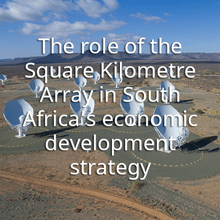 The Square Kilometre Array South Africa (SKA SA)’s success is underpinned by open and inclusive institutions, fostering and leveraging interrelationships, promoting innovation that may be commercialised, and attracting, retaining and training suitable individuals. These four themes or key pillars (institutions, interrelationships, innovation and individuals) – comprising the 4I model – were revealed to be crucial for engendering a knowledge economy. Bhogal developed the 4I model whilst exploring factors that inhibit and enable the impact of SKA on South Africa’s knowledge economy. Increasingly, nations pursue knowledge-based endeavours to promote economic growth. SKA SA – South Africa’s flagship science project and the world’s largest radio telescope – is expected to develop local competitive advantage, which will contribute to economic growth. Sub-themes in the 4I model include the role of a nation’s inherent competitive advantage in informing its competitive and innovation strategy, multidimensional interrelationships and politically astute leadership. A deeper understanding of the 4I model forms a basis for strengthening each pillar and thereby its impact on the knowledge economy.
The Square Kilometre Array South Africa (SKA SA)’s success is underpinned by open and inclusive institutions, fostering and leveraging interrelationships, promoting innovation that may be commercialised, and attracting, retaining and training suitable individuals. These four themes or key pillars (institutions, interrelationships, innovation and individuals) – comprising the 4I model – were revealed to be crucial for engendering a knowledge economy. Bhogal developed the 4I model whilst exploring factors that inhibit and enable the impact of SKA on South Africa’s knowledge economy. Increasingly, nations pursue knowledge-based endeavours to promote economic growth. SKA SA – South Africa’s flagship science project and the world’s largest radio telescope – is expected to develop local competitive advantage, which will contribute to economic growth. Sub-themes in the 4I model include the role of a nation’s inherent competitive advantage in informing its competitive and innovation strategy, multidimensional interrelationships and politically astute leadership. A deeper understanding of the 4I model forms a basis for strengthening each pillar and thereby its impact on the knowledge economy.
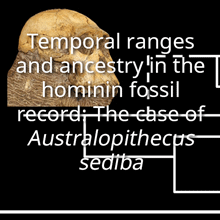 Recently discovered Australopithecus sediba is known from only one time and place: Malapa, South Africa, dated to ~800 thousand years later than the earliest fossils attributed to the genus Homo – fuelling debate about whether A. sediba could be ancestral to Homo and modern humans. Because the fossil record is incomplete, researchers cannot be certain how far back in time any species extended. However, by reviewing evidence from other, better documented hominin species, Robinson and colleagues have demonstrated that dates alone are insufficient to reject the hypothesis of direct ancestry of Homo as, on average, fossil hominin species lived for almost one million years. Using the one date for A. sediba as a first, middle or last date of appearance, Robinson and colleagues compared possible temporal ranges of A. sediba and Homo for known modes of speciation, and showed that the possibility of A. sediba being ancestral to Homo could not be precluded. Until additional data are available for the temporal range of A. sediba, any inferences about the evolutionary relationship between A. sediba and Homo should be based primarily on morphology.
Recently discovered Australopithecus sediba is known from only one time and place: Malapa, South Africa, dated to ~800 thousand years later than the earliest fossils attributed to the genus Homo – fuelling debate about whether A. sediba could be ancestral to Homo and modern humans. Because the fossil record is incomplete, researchers cannot be certain how far back in time any species extended. However, by reviewing evidence from other, better documented hominin species, Robinson and colleagues have demonstrated that dates alone are insufficient to reject the hypothesis of direct ancestry of Homo as, on average, fossil hominin species lived for almost one million years. Using the one date for A. sediba as a first, middle or last date of appearance, Robinson and colleagues compared possible temporal ranges of A. sediba and Homo for known modes of speciation, and showed that the possibility of A. sediba being ancestral to Homo could not be precluded. Until additional data are available for the temporal range of A. sediba, any inferences about the evolutionary relationship between A. sediba and Homo should be based primarily on morphology.
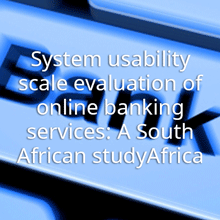 Age, experience and income affect users’ perceptions of online banking in South Africa. The adoption of online banking by South Africans has been very low compared with the global average. Mujinga et al. investigated if online banking usability was a barrier to adoption using a system usability measurement tool and found that assessment of usability was affected by age, experience and income – with older, more experienced and higher income users scoring usability more highly. Gender, employment, and use frequency had no impact on users’ assessment of online banking. Banks make large investments in providing self-service solutions. To realise returns on these investments and to reduce operating costs for in-branch services, clients must use the online services offered. An in-depth investigation is needed to identify usability factors that might be contributing to the lack of uptake of online banking services in South Africa.
Age, experience and income affect users’ perceptions of online banking in South Africa. The adoption of online banking by South Africans has been very low compared with the global average. Mujinga et al. investigated if online banking usability was a barrier to adoption using a system usability measurement tool and found that assessment of usability was affected by age, experience and income – with older, more experienced and higher income users scoring usability more highly. Gender, employment, and use frequency had no impact on users’ assessment of online banking. Banks make large investments in providing self-service solutions. To realise returns on these investments and to reduce operating costs for in-branch services, clients must use the online services offered. An in-depth investigation is needed to identify usability factors that might be contributing to the lack of uptake of online banking services in South Africa.
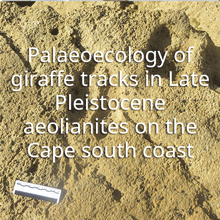 Did ancient giraffes once roam a savanna now submerged by the Gouritz and Breede Rivers? The recent discovery in 2016 of fossil giraffe tracks east of Still Bay on the Cape south coast – the first Pleistocene fossil giraffe tracks to be recorded in southern Africa – significantly increases the geographic range of this species. Until now there have been no reliable historical or fossil records for the giraffe south of the Orange River or northern Namaqualand. Based on correlations to dated sites nearby, the tracks were probably made around 125 000 years ago. Helm and colleagues report on the discovery which has implications for Late Pleistocene climate and vegetation in the southern Cape, because of the specialised feeding niche of giraffe populations. Evidence suggests that the currently submerged floodplains of the Gouritz and Breede Rivers supported a productive savanna during Pleistocene glacial conditions. This habitat would have been suitable for giraffe, and would likely have allowed giraffe to migrate along the southern coastal plain.
Did ancient giraffes once roam a savanna now submerged by the Gouritz and Breede Rivers? The recent discovery in 2016 of fossil giraffe tracks east of Still Bay on the Cape south coast – the first Pleistocene fossil giraffe tracks to be recorded in southern Africa – significantly increases the geographic range of this species. Until now there have been no reliable historical or fossil records for the giraffe south of the Orange River or northern Namaqualand. Based on correlations to dated sites nearby, the tracks were probably made around 125 000 years ago. Helm and colleagues report on the discovery which has implications for Late Pleistocene climate and vegetation in the southern Cape, because of the specialised feeding niche of giraffe populations. Evidence suggests that the currently submerged floodplains of the Gouritz and Breede Rivers supported a productive savanna during Pleistocene glacial conditions. This habitat would have been suitable for giraffe, and would likely have allowed giraffe to migrate along the southern coastal plain.
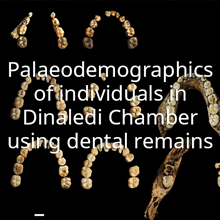 An assemblage of hominin fossils from Dinaledi Chamber, attributed to at least 15 individuals of the newly identified species Homo naledi, is strikingly different from australopith and Neanderthal sites with multiple individuals. The difference lies in the high proportion of infants and young juveniles in the Dinaledi assemblage as well as in the location of the Dinaledi fossils, which are scattered within a hidden cave chamber. About 1550 fossil specimens of a single hominin species were recovered from the Dinaledi Chamber (Cradle of Humankind, South Africa) during excavations in 2013–2014. Bolter and colleagues used 190 dental elements to identify life-history stages and attributed these elements based on their degree of development to 15 individuals: 9 immature and 6 adult individuals, including one old adult with very worn teeth. Adults were classified by sets of dentition with all the permanent teeth in place; infants (3) as those with only deciduous (or baby) teeth, juveniles (4) as those with a combination of deciduous and permanent teeth, and sub-adults (1) as those with permanent teeth that were not fully erupted. One immature individual could not be assigned to an age class. Current studies using forensic techniques are proceeding to match skeletal bones with the dental remains. The Dinaledi assemblage presents an uncommon opportunity to examine a fossil species at the population-level perspective. Additional excavations underway suggest more individuals lie in wait deep inside the cave system.
An assemblage of hominin fossils from Dinaledi Chamber, attributed to at least 15 individuals of the newly identified species Homo naledi, is strikingly different from australopith and Neanderthal sites with multiple individuals. The difference lies in the high proportion of infants and young juveniles in the Dinaledi assemblage as well as in the location of the Dinaledi fossils, which are scattered within a hidden cave chamber. About 1550 fossil specimens of a single hominin species were recovered from the Dinaledi Chamber (Cradle of Humankind, South Africa) during excavations in 2013–2014. Bolter and colleagues used 190 dental elements to identify life-history stages and attributed these elements based on their degree of development to 15 individuals: 9 immature and 6 adult individuals, including one old adult with very worn teeth. Adults were classified by sets of dentition with all the permanent teeth in place; infants (3) as those with only deciduous (or baby) teeth, juveniles (4) as those with a combination of deciduous and permanent teeth, and sub-adults (1) as those with permanent teeth that were not fully erupted. One immature individual could not be assigned to an age class. Current studies using forensic techniques are proceeding to match skeletal bones with the dental remains. The Dinaledi assemblage presents an uncommon opportunity to examine a fossil species at the population-level perspective. Additional excavations underway suggest more individuals lie in wait deep inside the cave system.
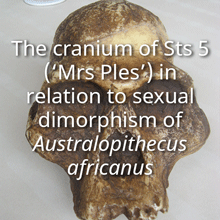 The fossilised skull of an Australopithecus africanus from Sterkfontein – well known as “Mrs Ples” – may indeed be a “Mr Ples”. Evidence obtained from an ongoing study of canine sockets and skull measurements supports the view that “Mrs Ples" is probably a small male individual. Both age and sex are factors that contribute to variation in growth and development of the cranium in australopithecines. On the basis of their comparisons of alveolar canine dimensions, Tawane and Thackeray conclude that “Mrs Ples” is the skull of a small male rather than a large female individual. The fossil is the most complete cranium of A. africanus and was discovered at the Sterkfontein Caves in the Cradle of Humankind in 1947 by Robert Broom and John Robinson. Broom claimed that it represented a female individual on the basis of canine sockets, but he did not have a large comparative sample of specimens to allow him to support this opinion. Within the last 70 years, more hominin fossils have been obtained from Sterkfontein. The view that "Mrs Ples" is a female specimen of A. africanus has been highly controversial and the skull continues to be the subject of research in the context of human evolution.
The fossilised skull of an Australopithecus africanus from Sterkfontein – well known as “Mrs Ples” – may indeed be a “Mr Ples”. Evidence obtained from an ongoing study of canine sockets and skull measurements supports the view that “Mrs Ples" is probably a small male individual. Both age and sex are factors that contribute to variation in growth and development of the cranium in australopithecines. On the basis of their comparisons of alveolar canine dimensions, Tawane and Thackeray conclude that “Mrs Ples” is the skull of a small male rather than a large female individual. The fossil is the most complete cranium of A. africanus and was discovered at the Sterkfontein Caves in the Cradle of Humankind in 1947 by Robert Broom and John Robinson. Broom claimed that it represented a female individual on the basis of canine sockets, but he did not have a large comparative sample of specimens to allow him to support this opinion. Within the last 70 years, more hominin fossils have been obtained from Sterkfontein. The view that "Mrs Ples" is a female specimen of A. africanus has been highly controversial and the skull continues to be the subject of research in the context of human evolution.
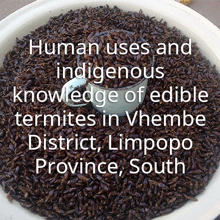 Termites are a food source with high economic and social importance and the preservation of the indigenous knowledge used during the harvesting and processing of termites should be prioritised. Netshifhefhe and colleagues surveyed over 100 harvesters, marketers and consumers from 48 villages in the Vhembe District Municipality of Limpopo Province, South Africa. Three termite species of the Macrotermes genus – mound-building termites which dominate the African savanna – are consumed, with M. falciger being the species of preference (90% of all termites). Individuals of all ages consume termites and the method of preparation preferred (by 78% of respondents) is frying. Termites are rich in proteins, fats, vitamins and many essential mineral nutrients. In addition to providing food security, income from the sale of termites can be as much as ZAR18 000 per year, and thus contributes significantly to the livelihoods of many rural families.
Termites are a food source with high economic and social importance and the preservation of the indigenous knowledge used during the harvesting and processing of termites should be prioritised. Netshifhefhe and colleagues surveyed over 100 harvesters, marketers and consumers from 48 villages in the Vhembe District Municipality of Limpopo Province, South Africa. Three termite species of the Macrotermes genus – mound-building termites which dominate the African savanna – are consumed, with M. falciger being the species of preference (90% of all termites). Individuals of all ages consume termites and the method of preparation preferred (by 78% of respondents) is frying. Termites are rich in proteins, fats, vitamins and many essential mineral nutrients. In addition to providing food security, income from the sale of termites can be as much as ZAR18 000 per year, and thus contributes significantly to the livelihoods of many rural families.
